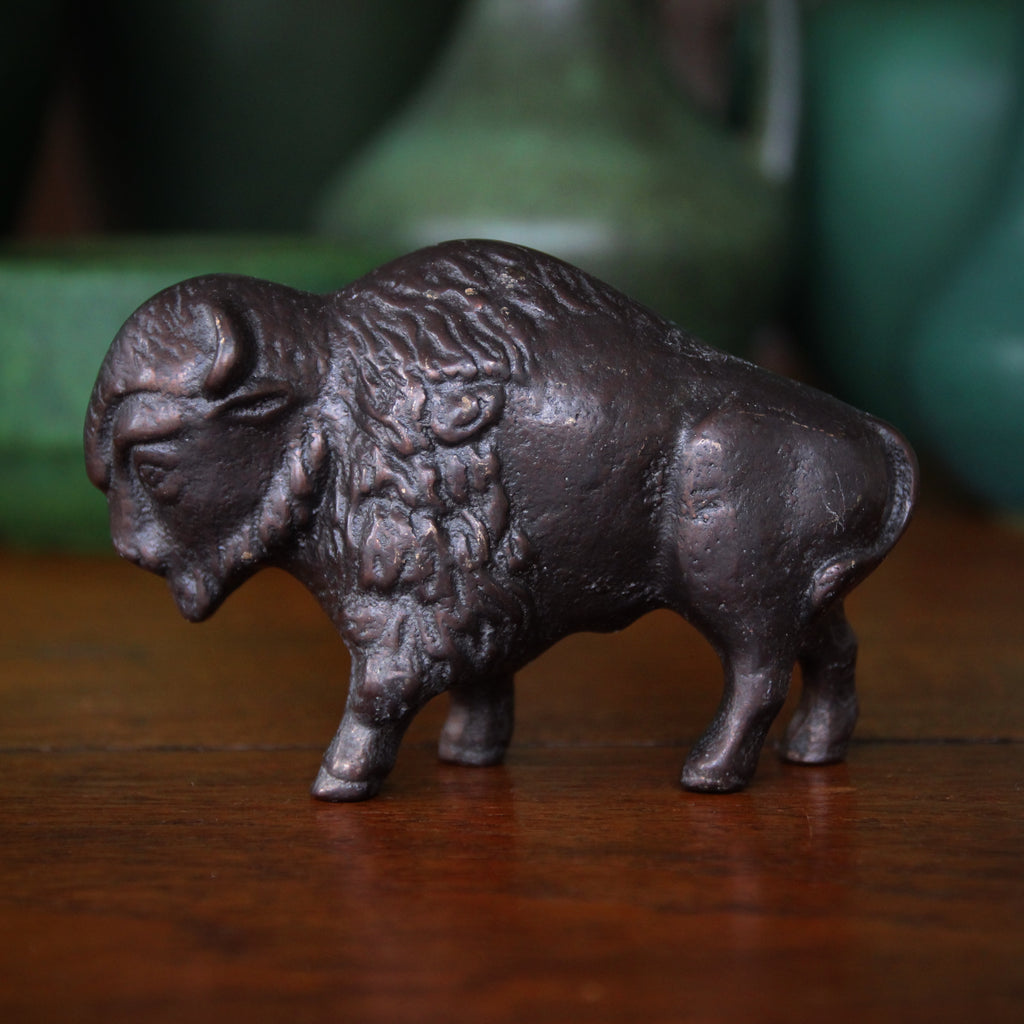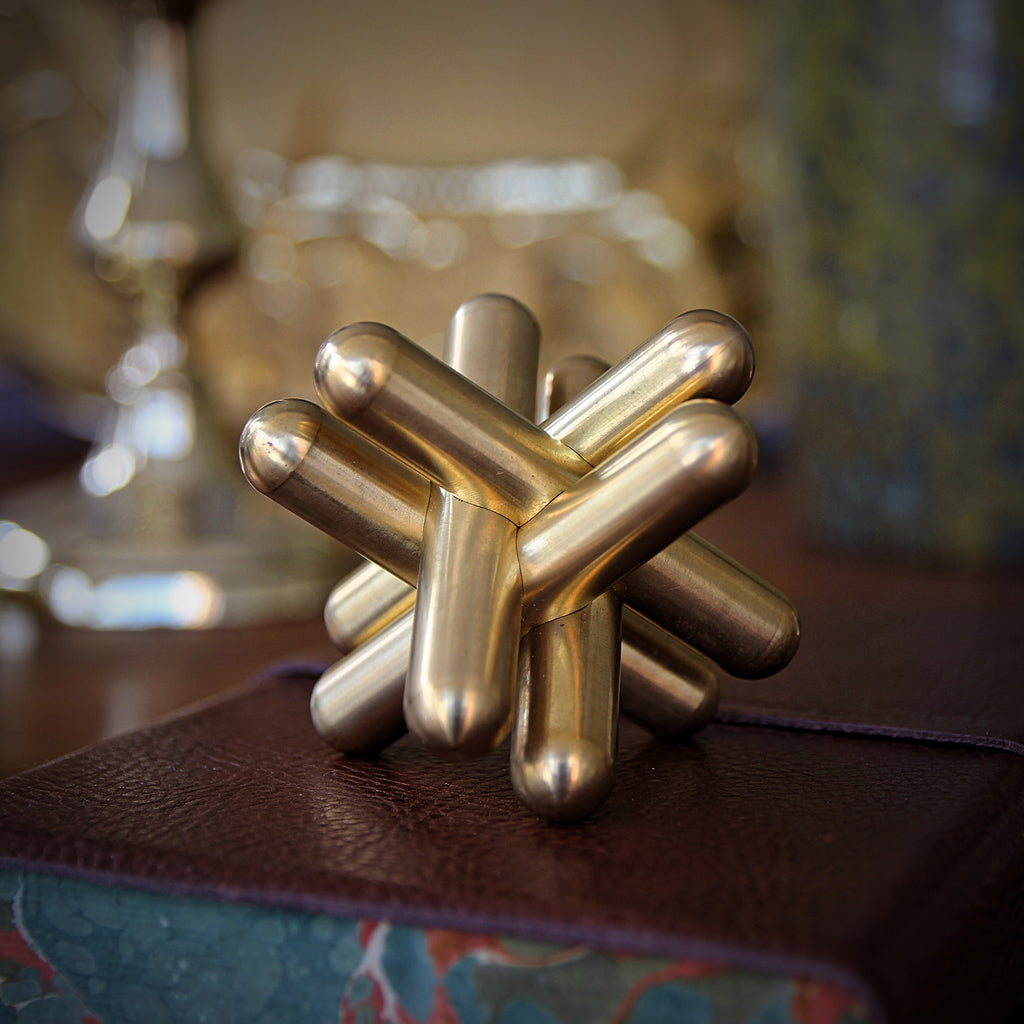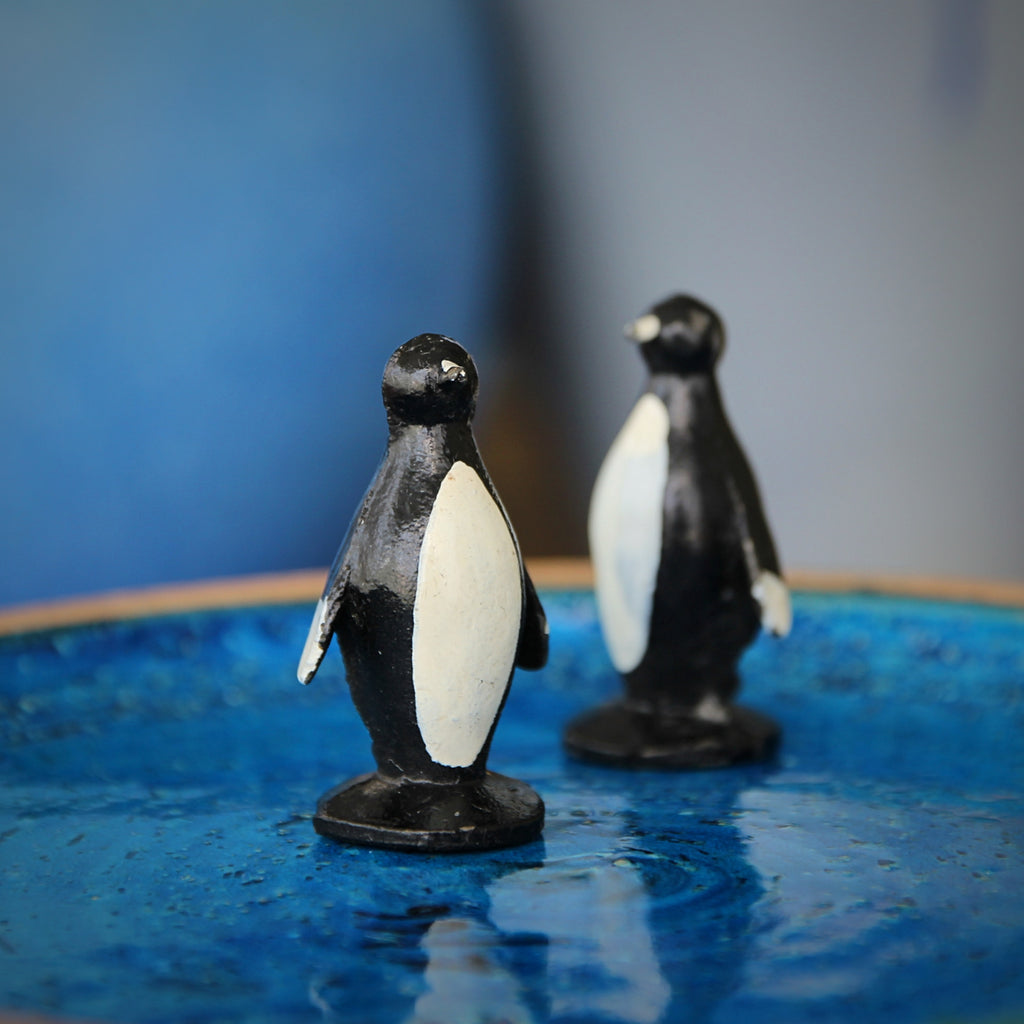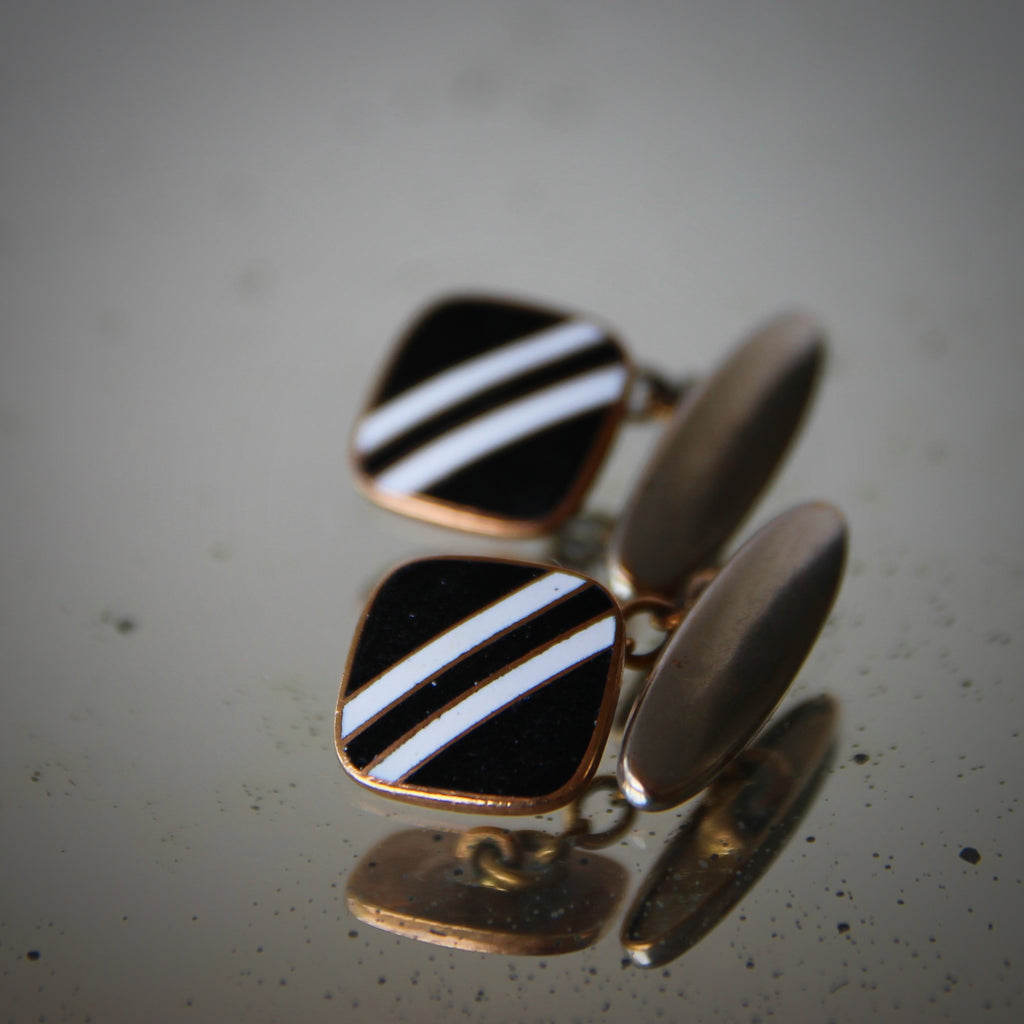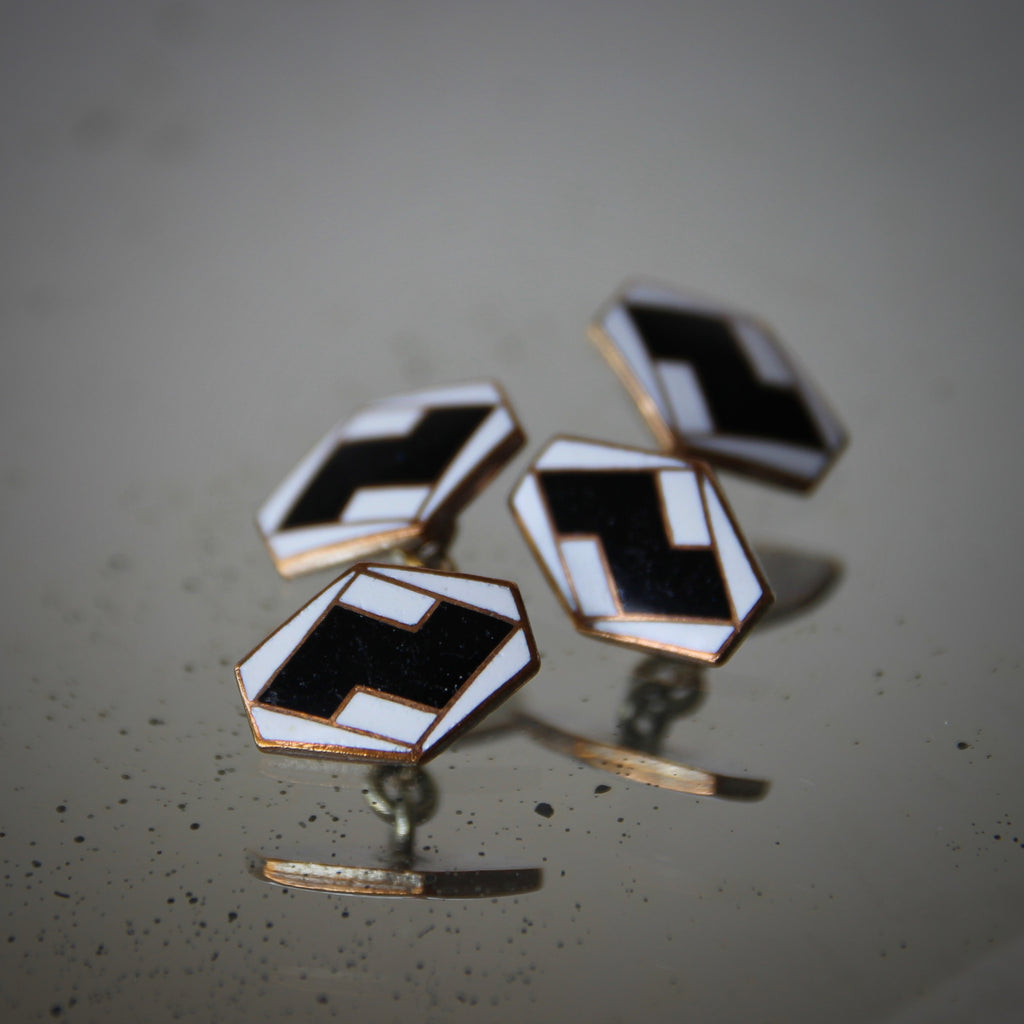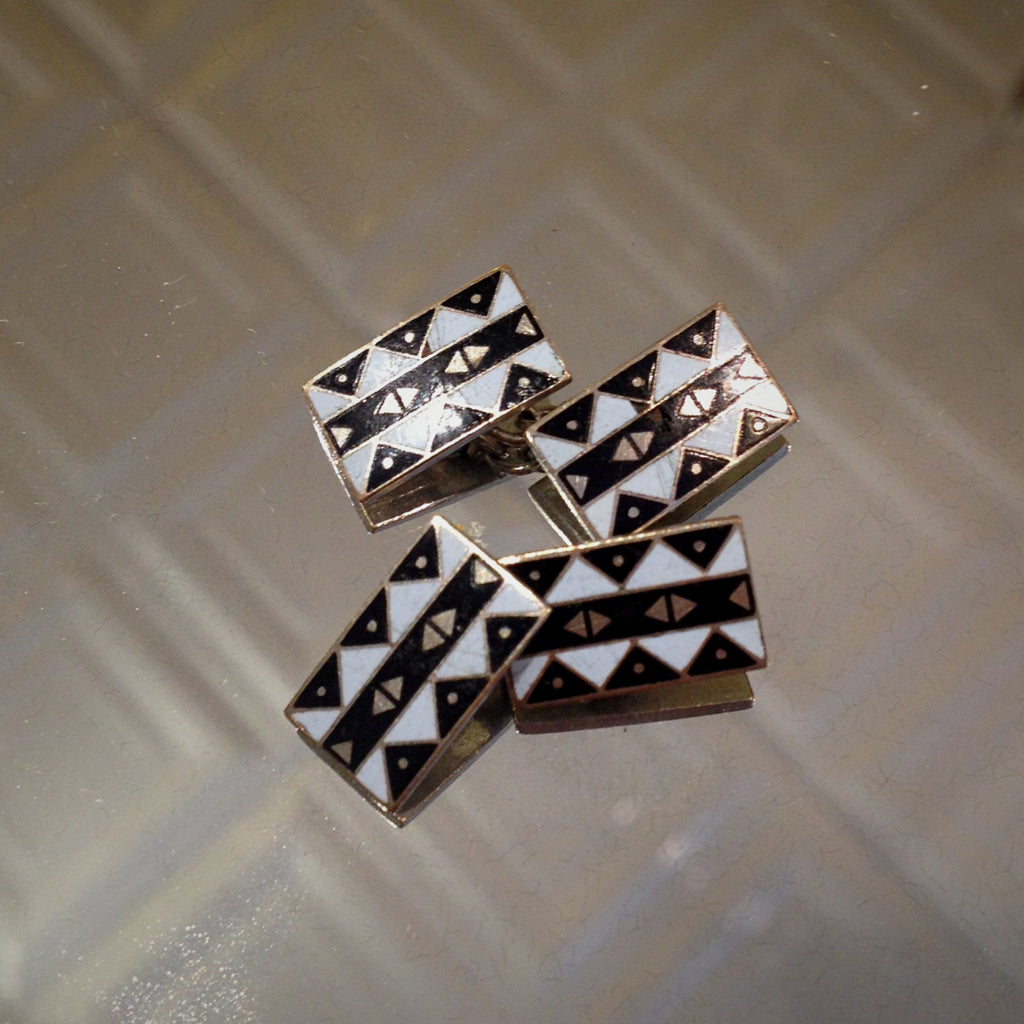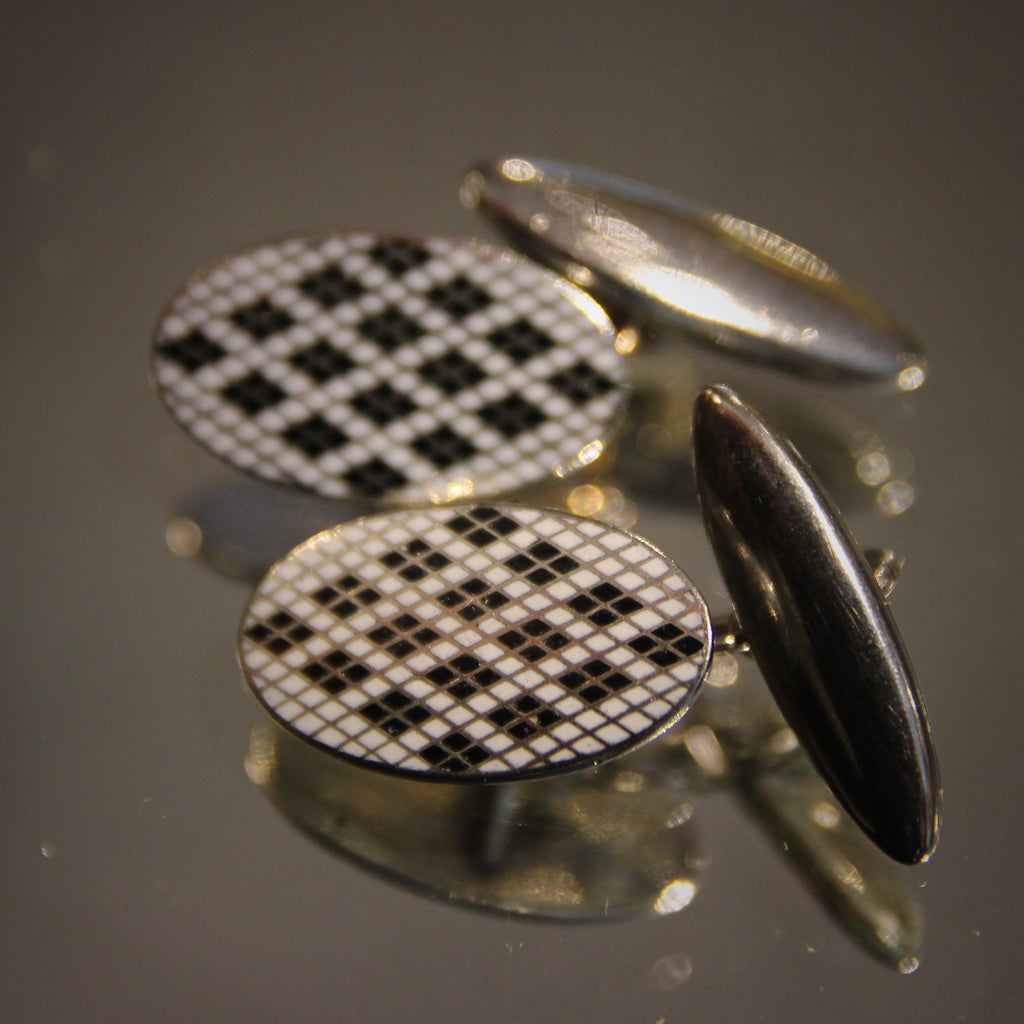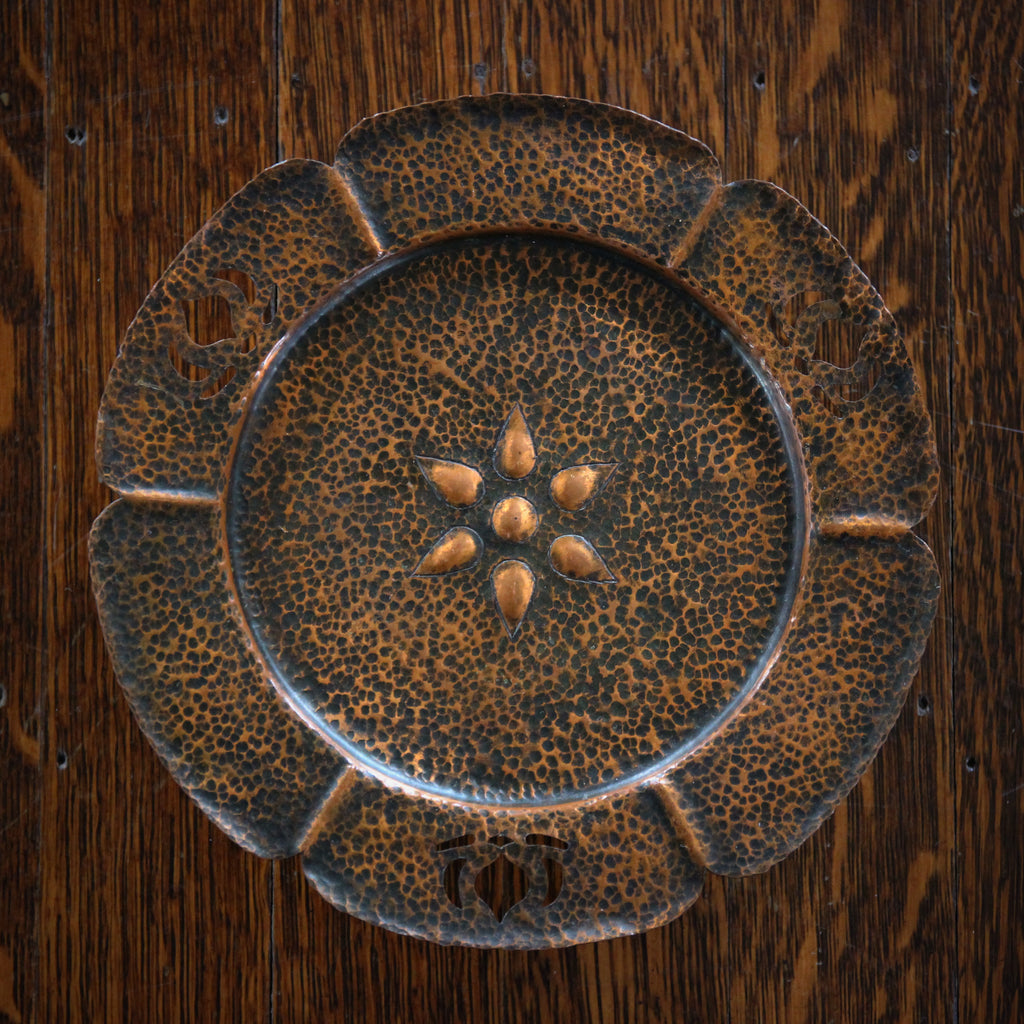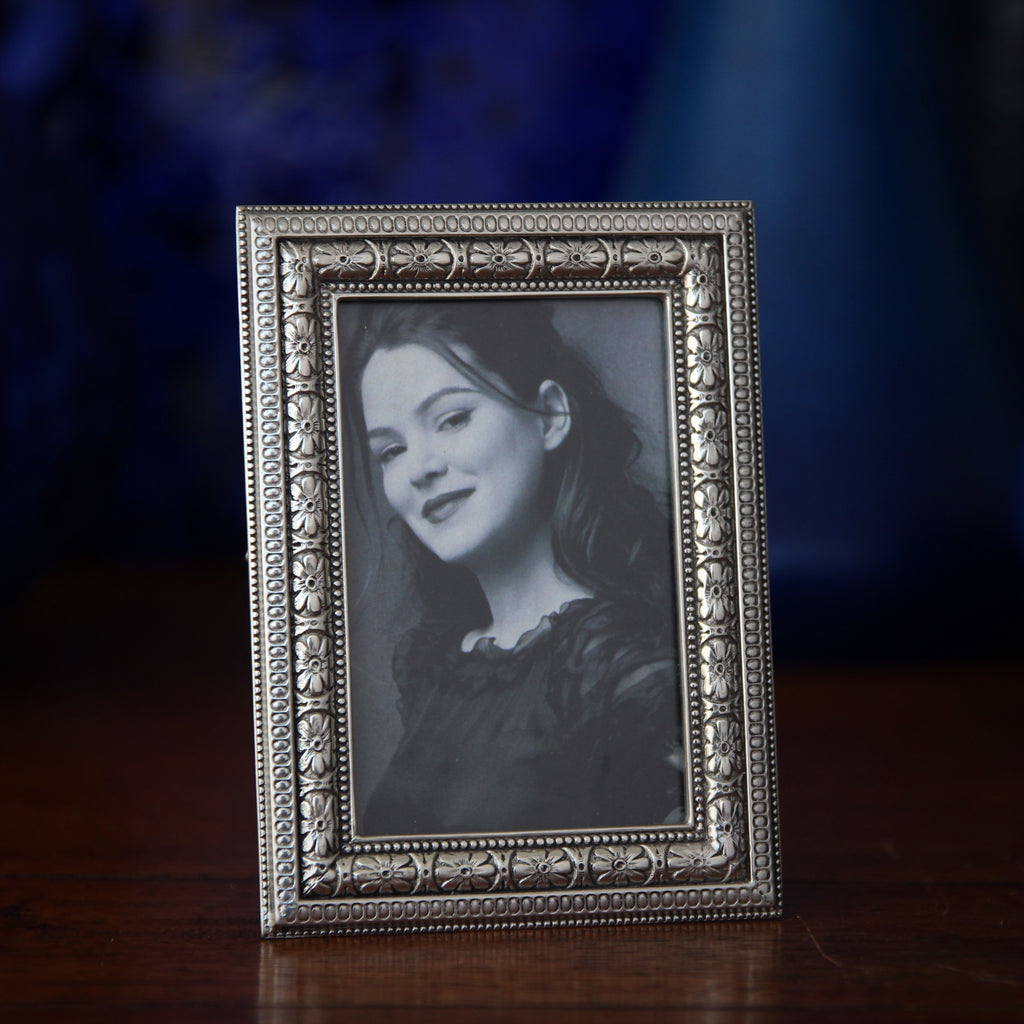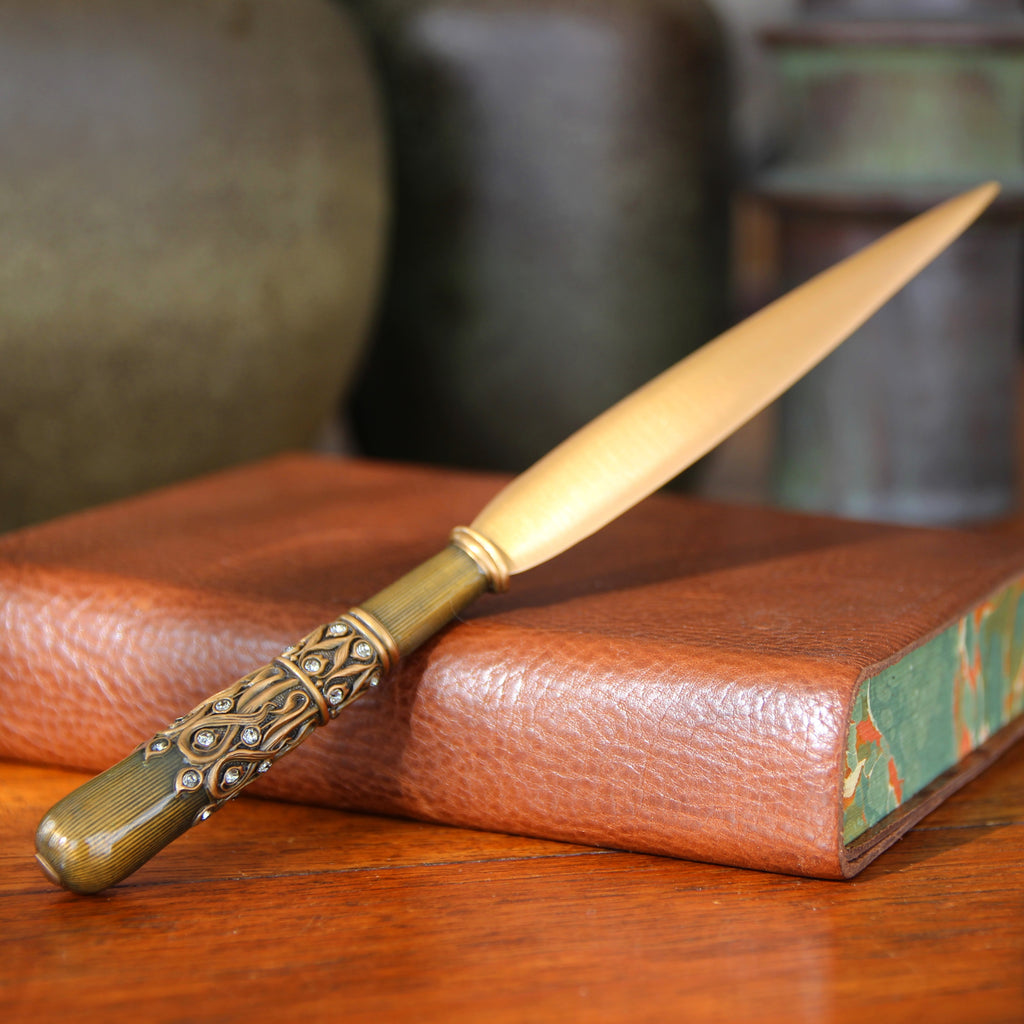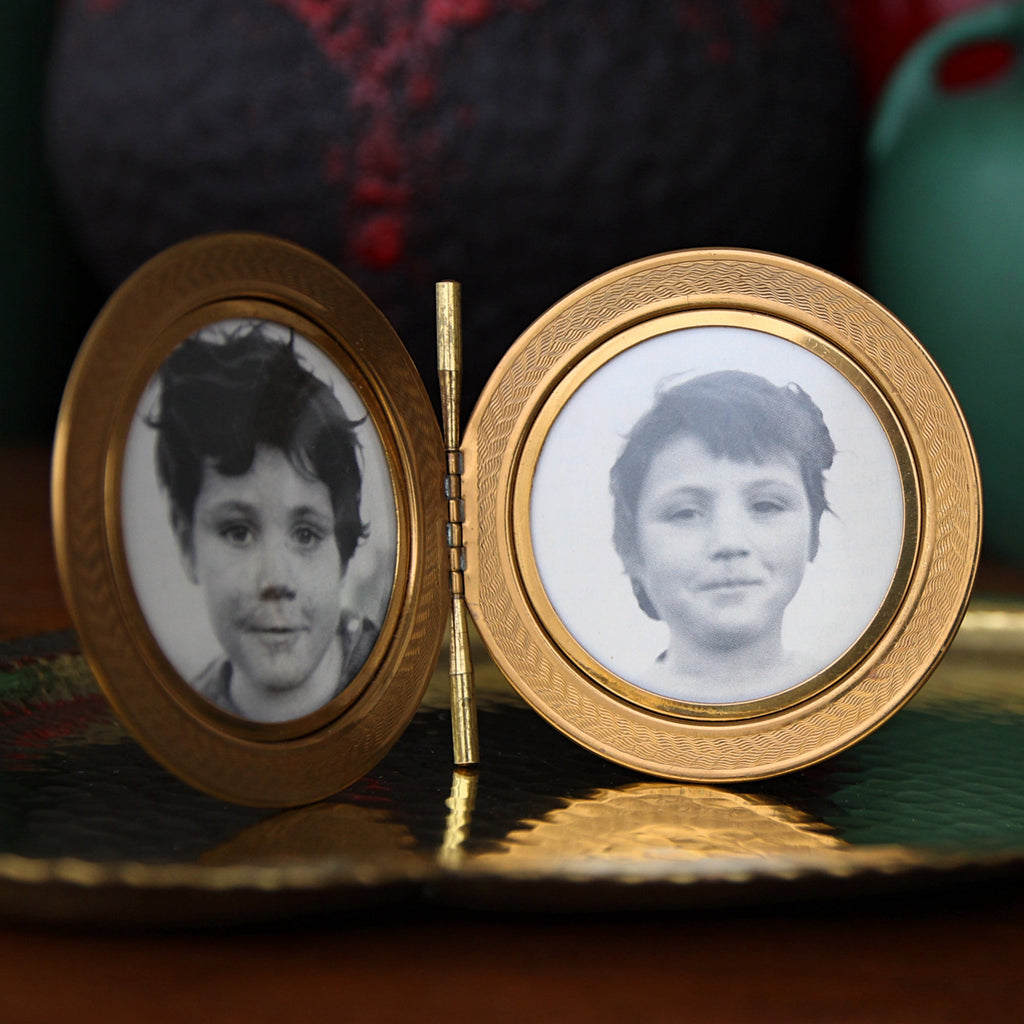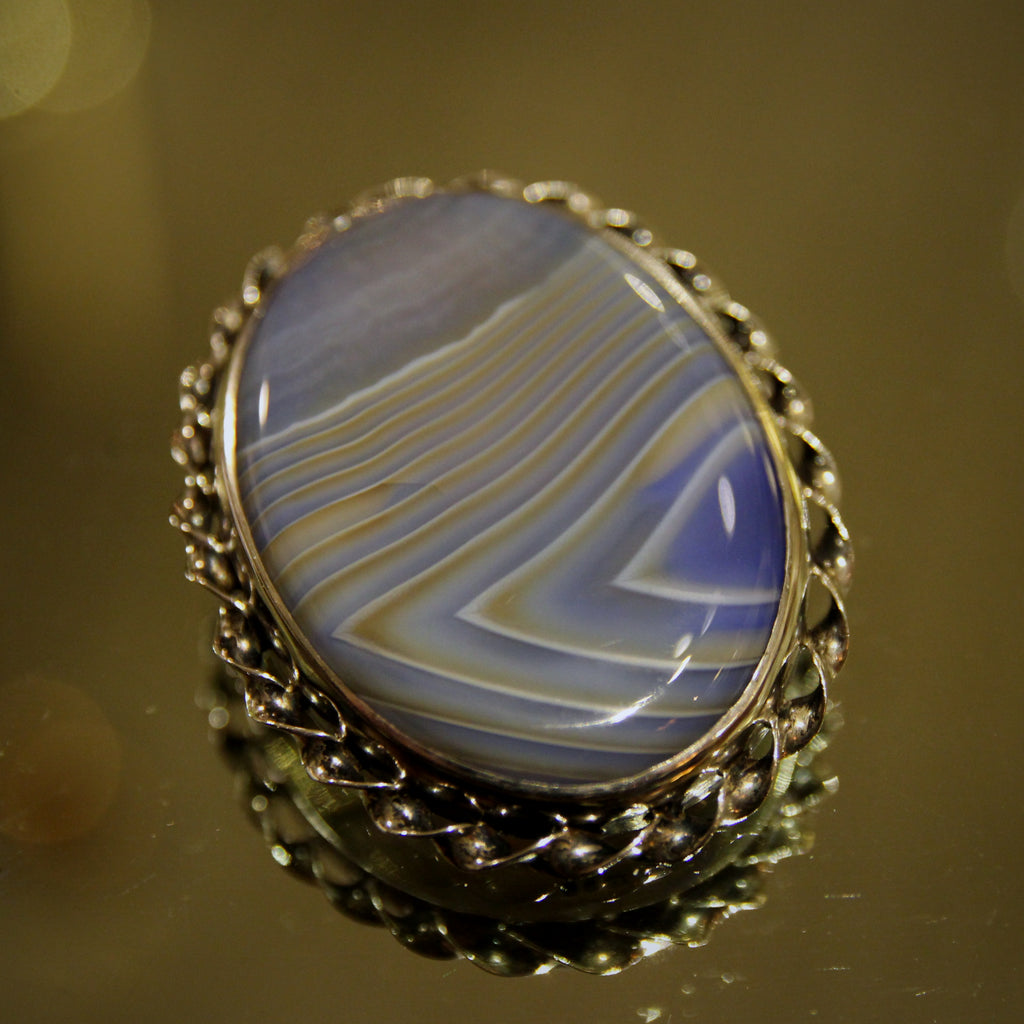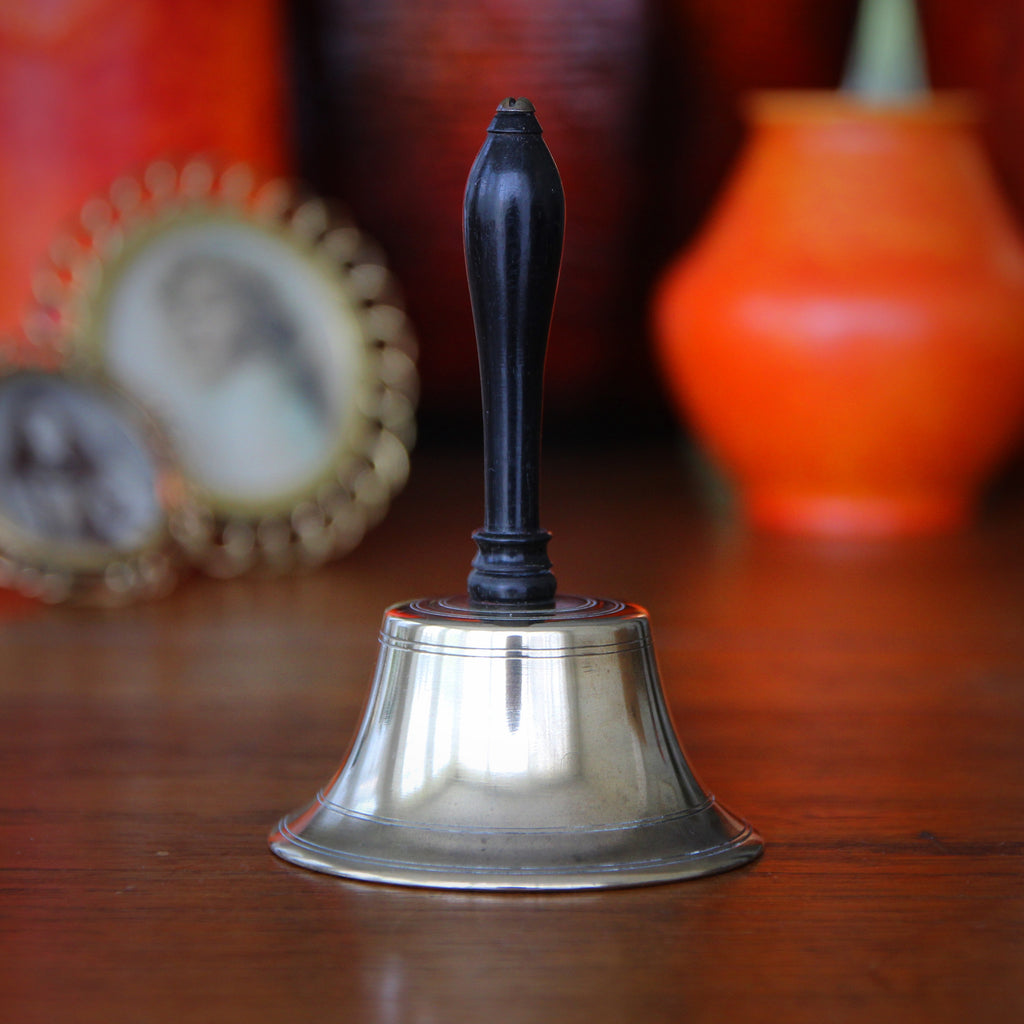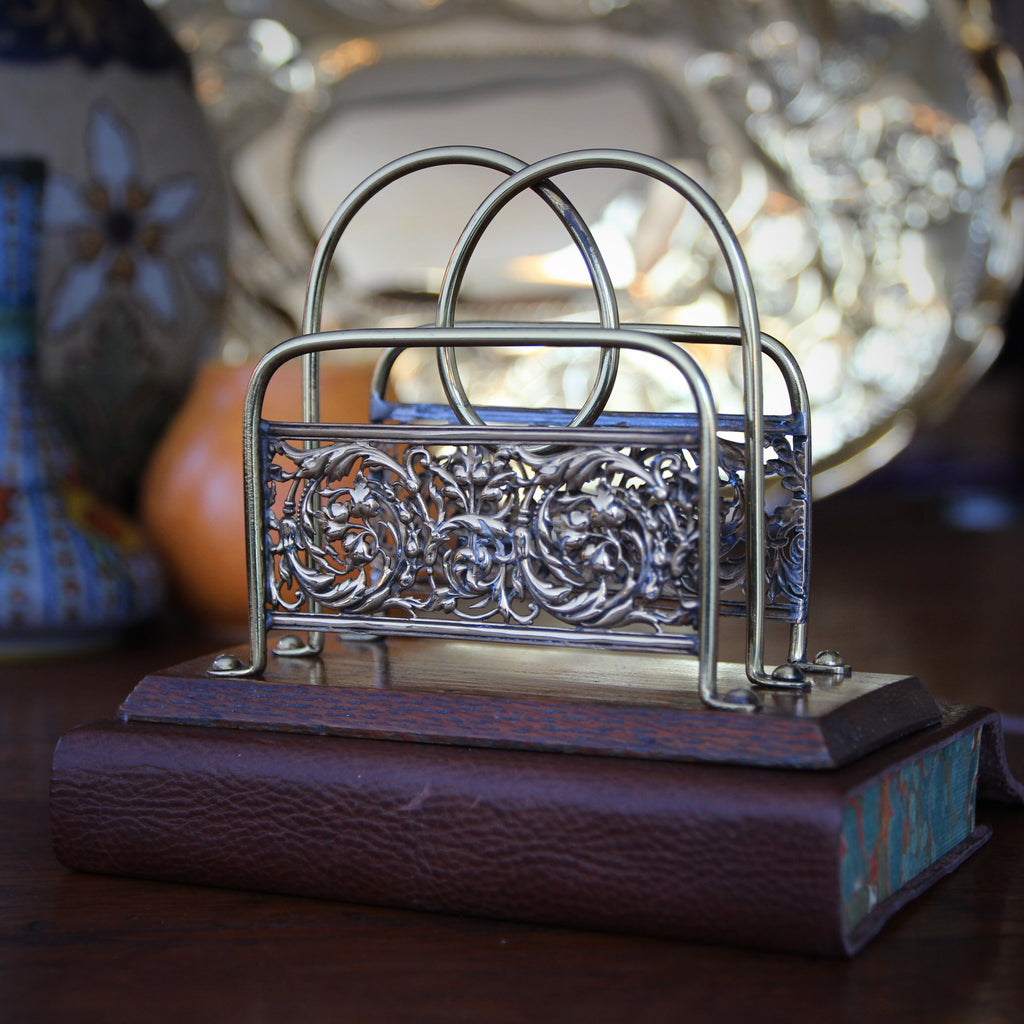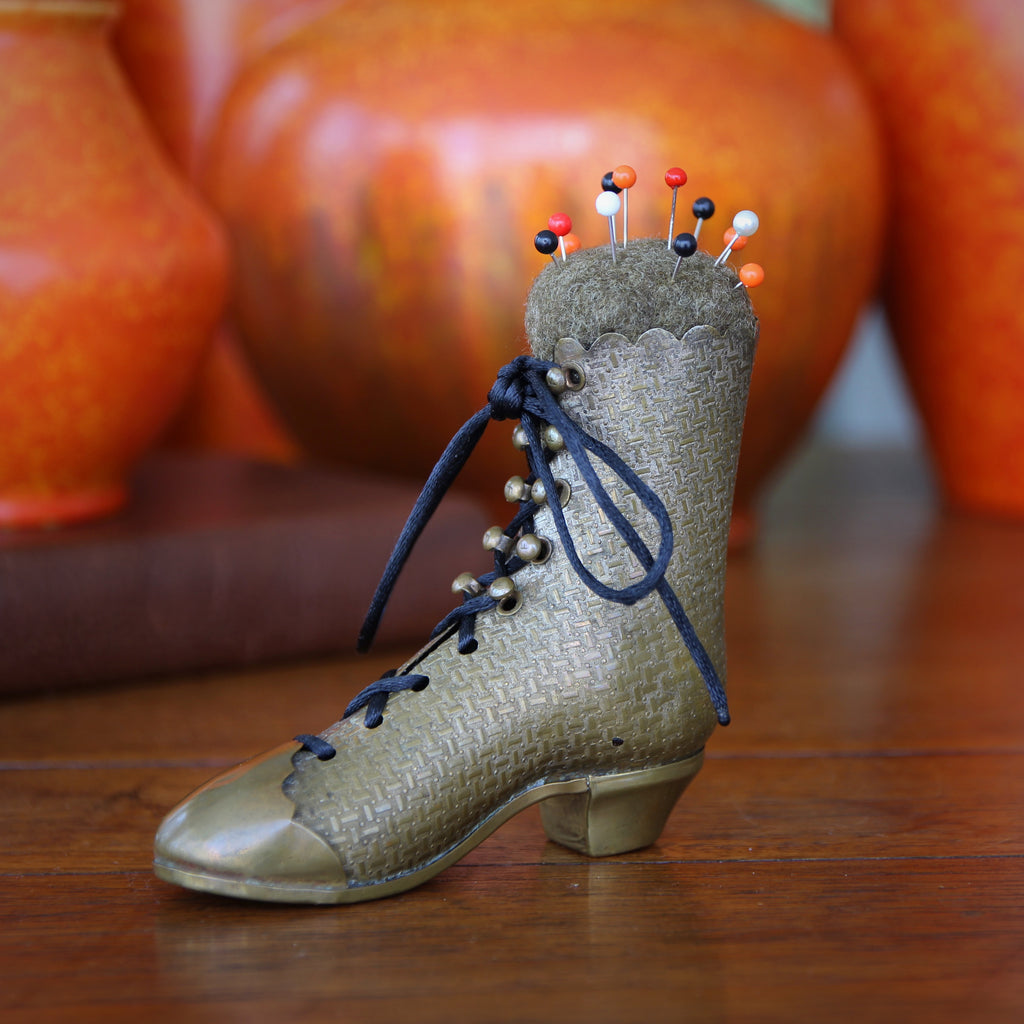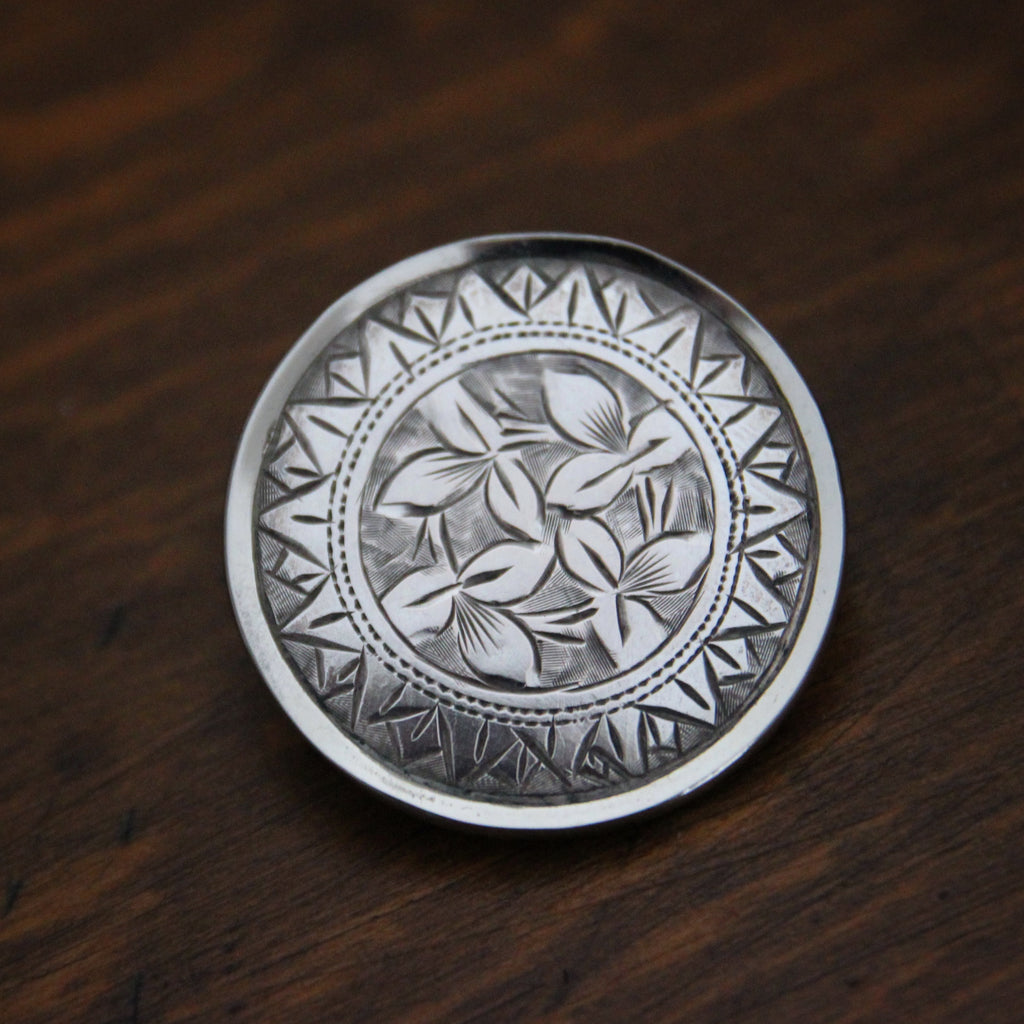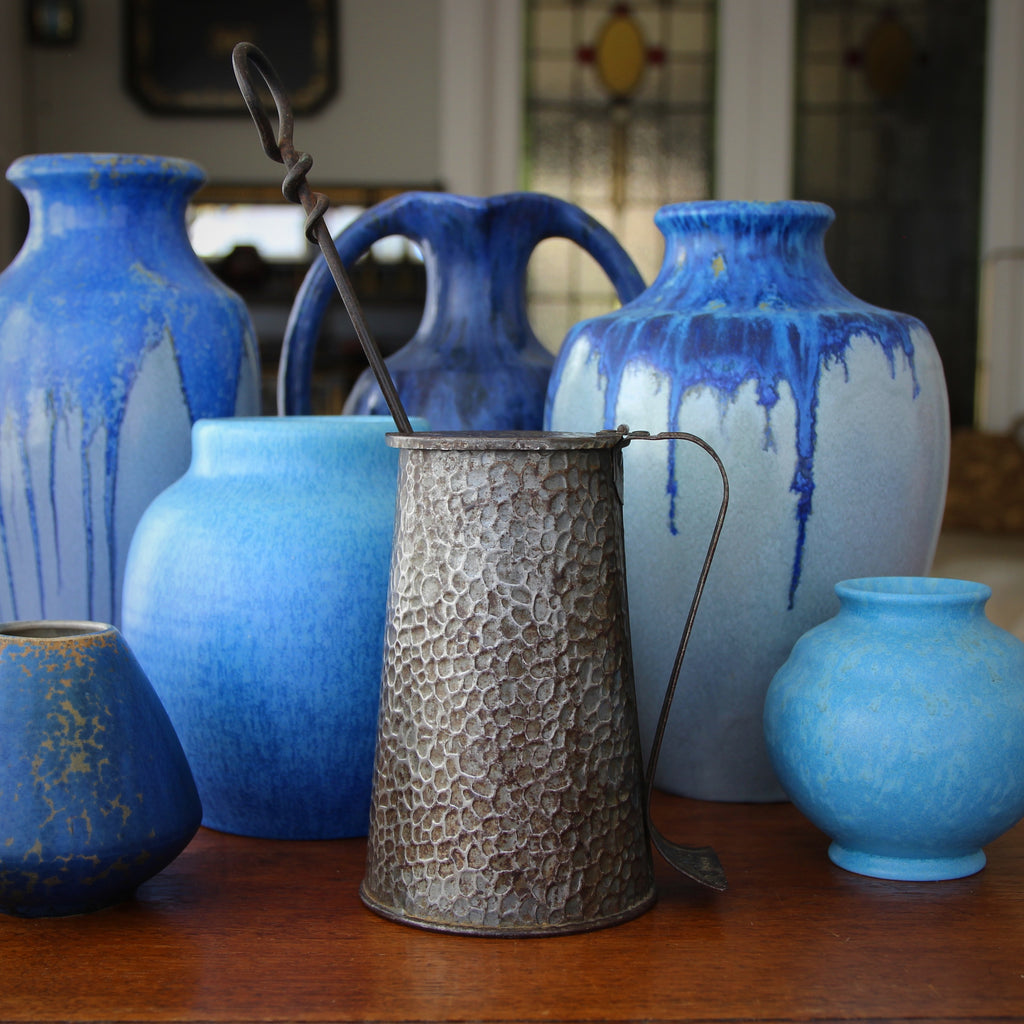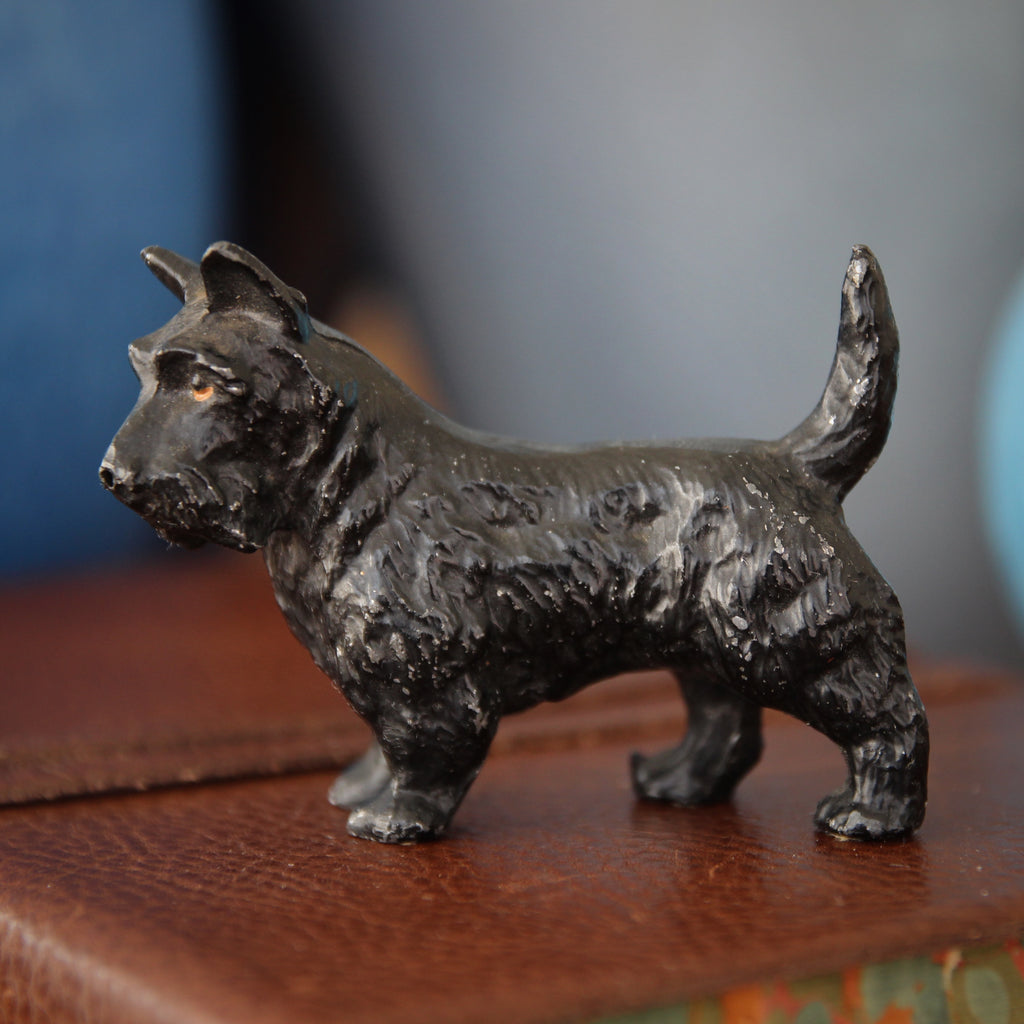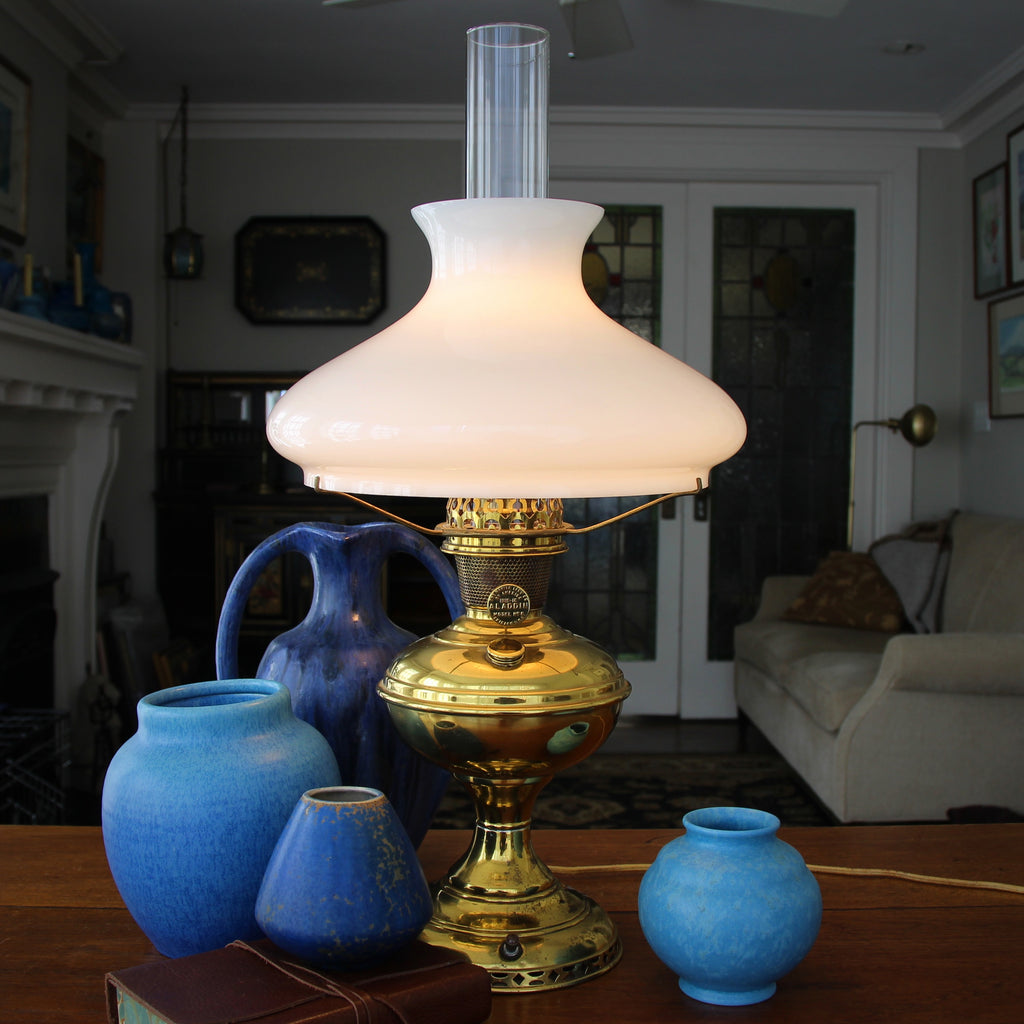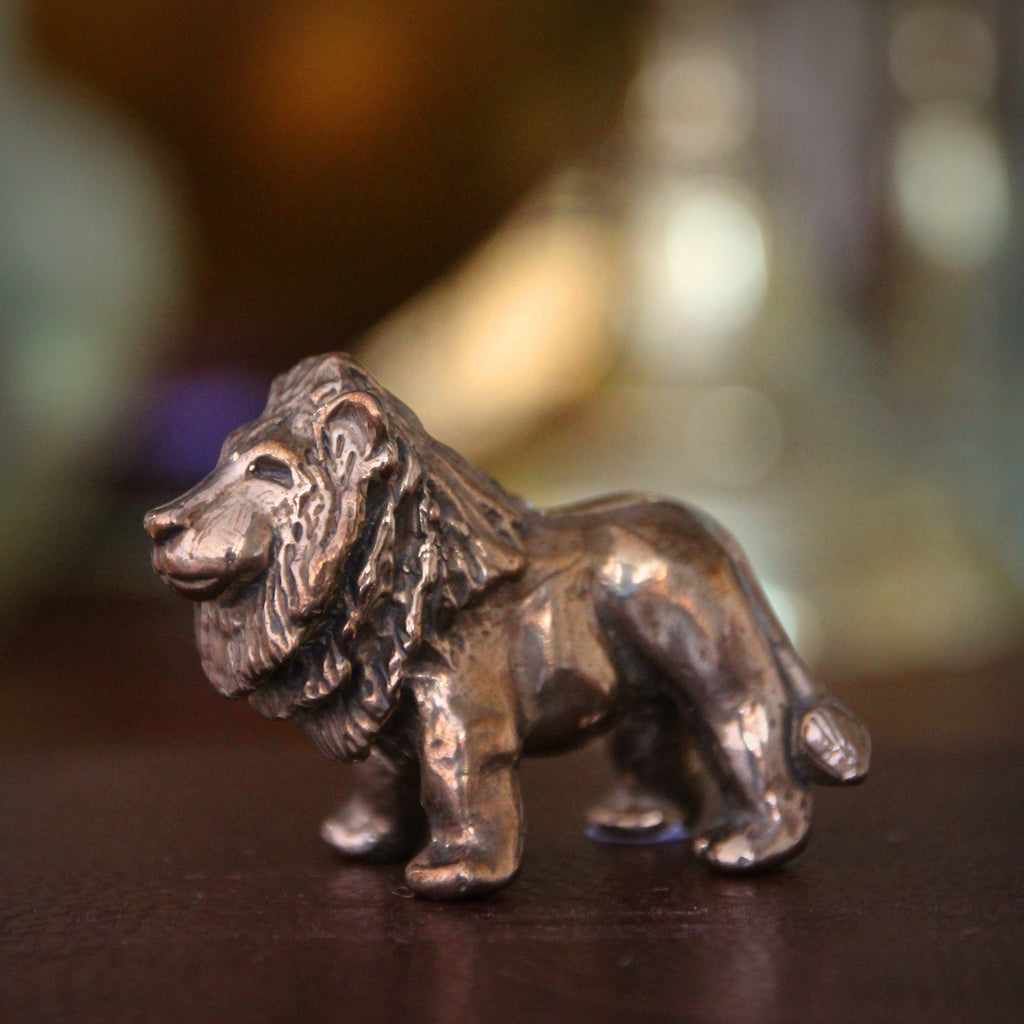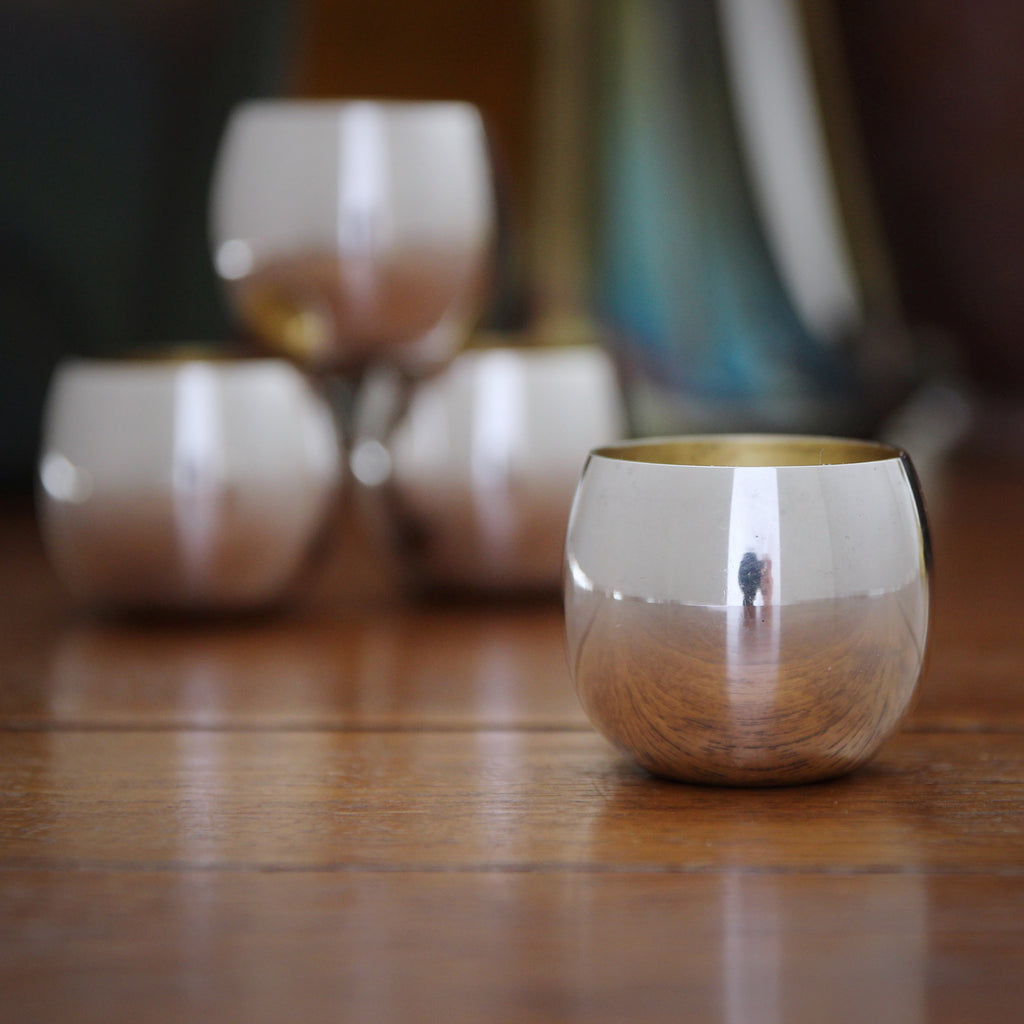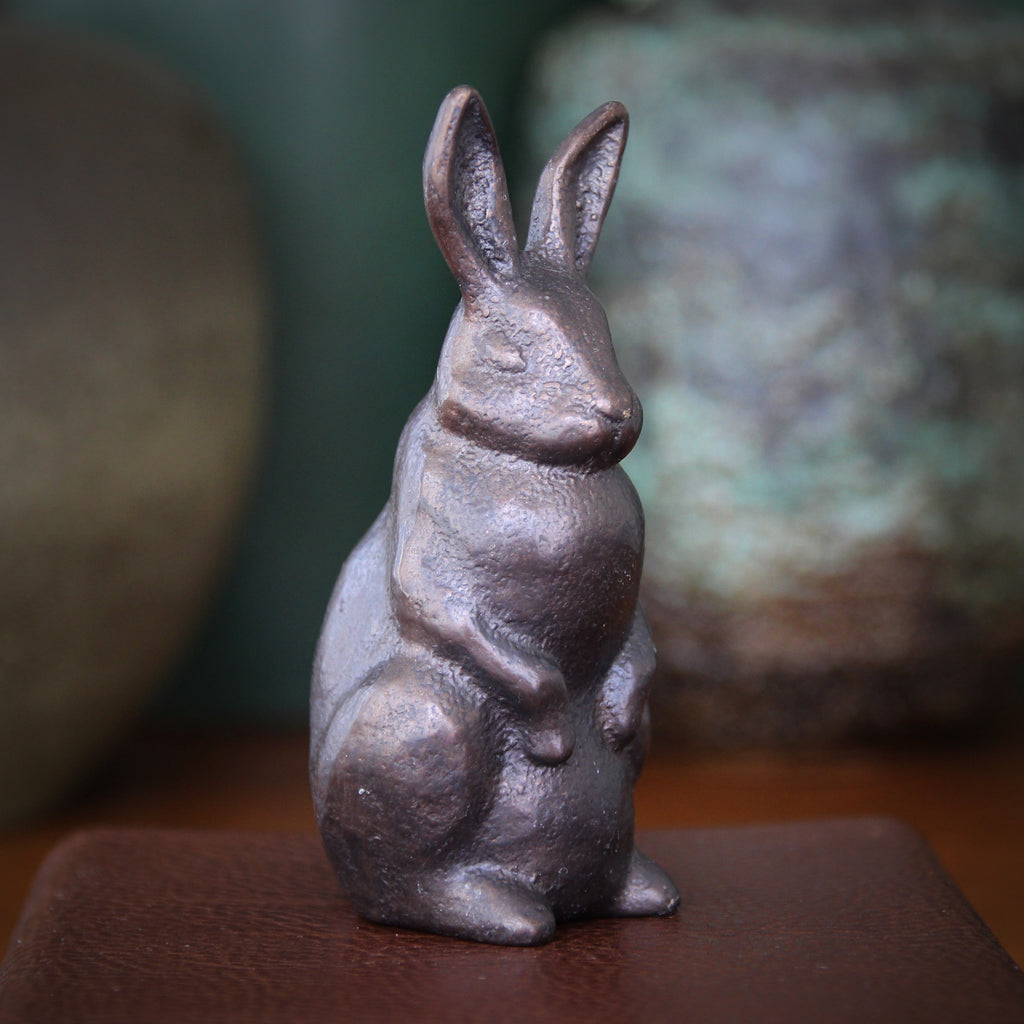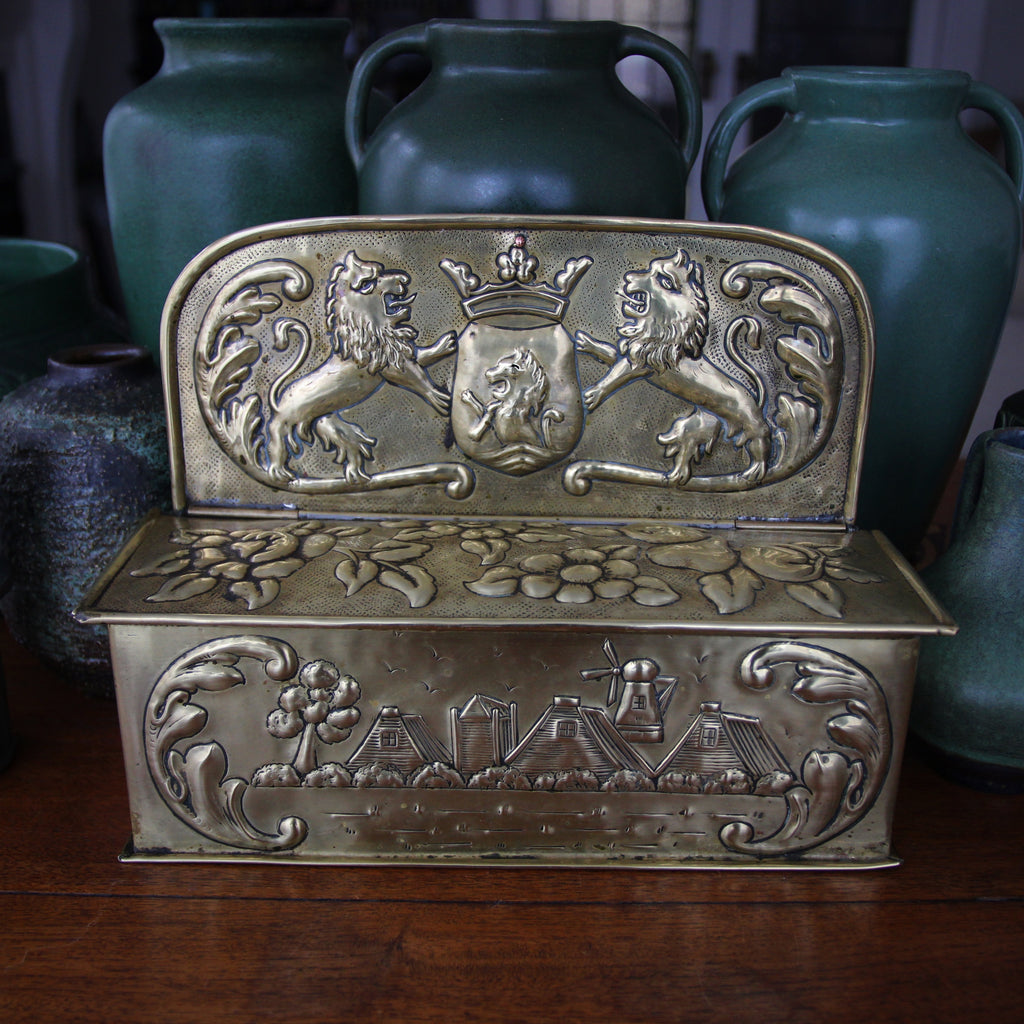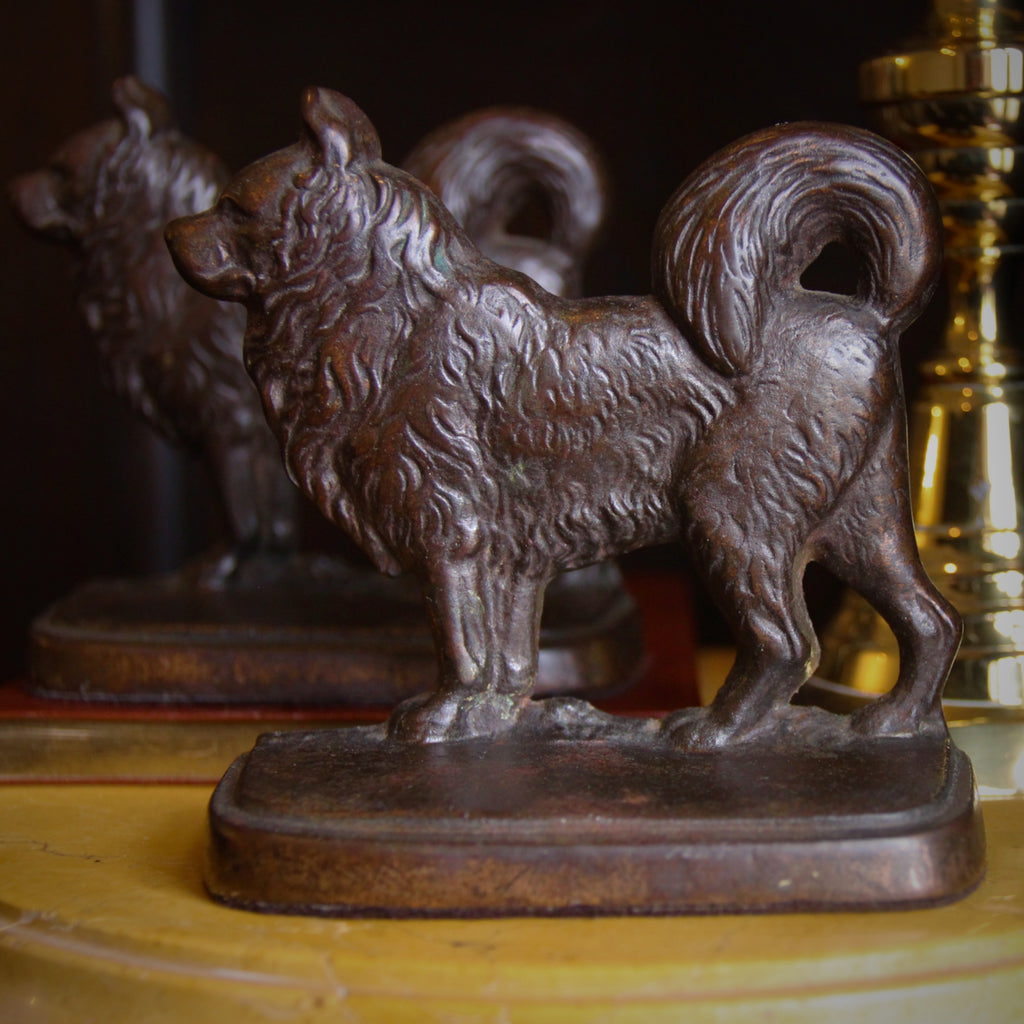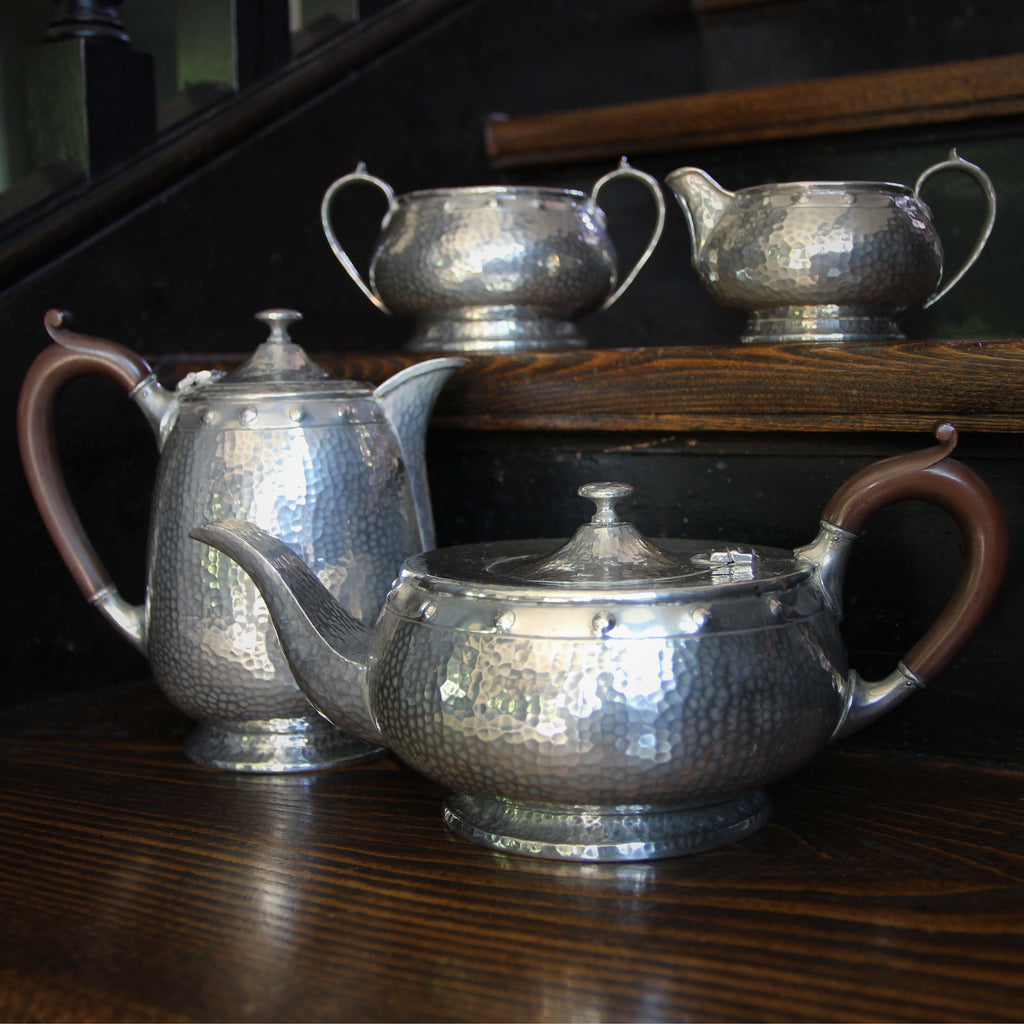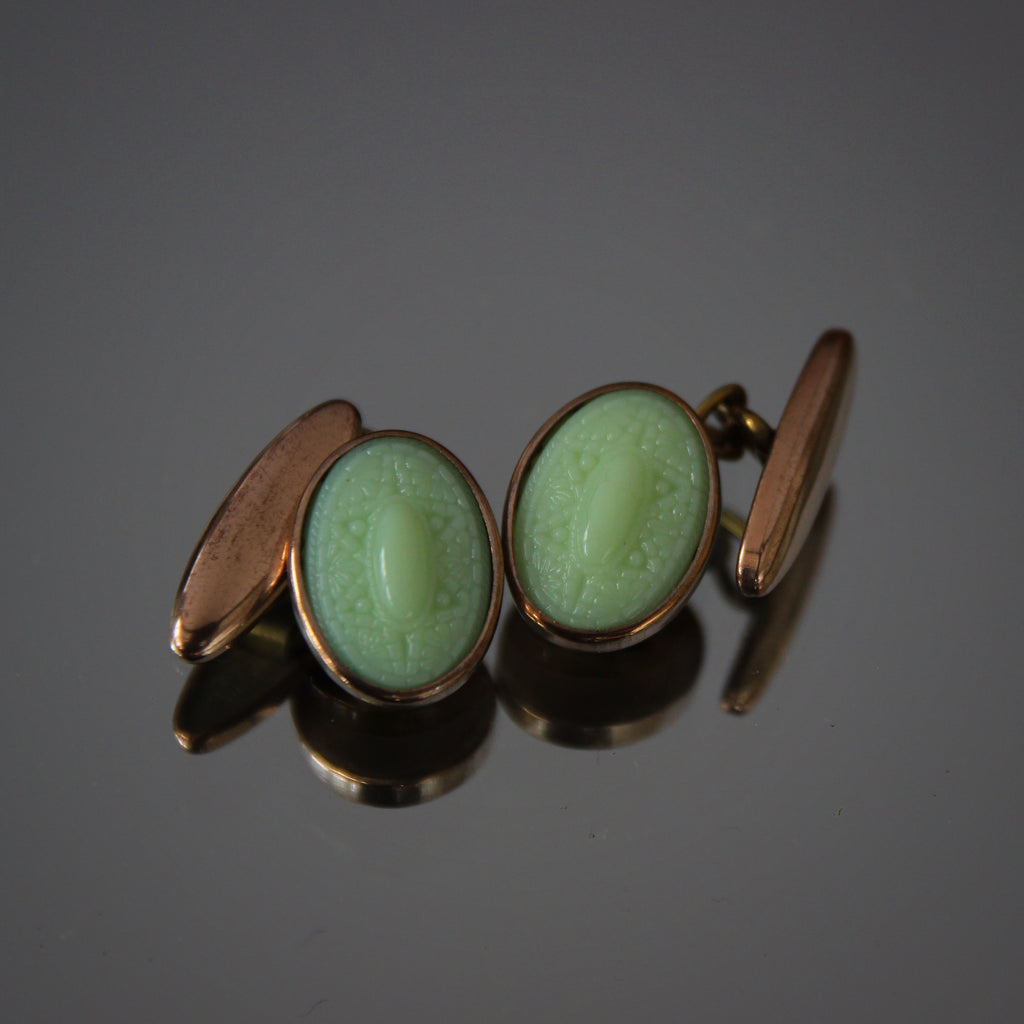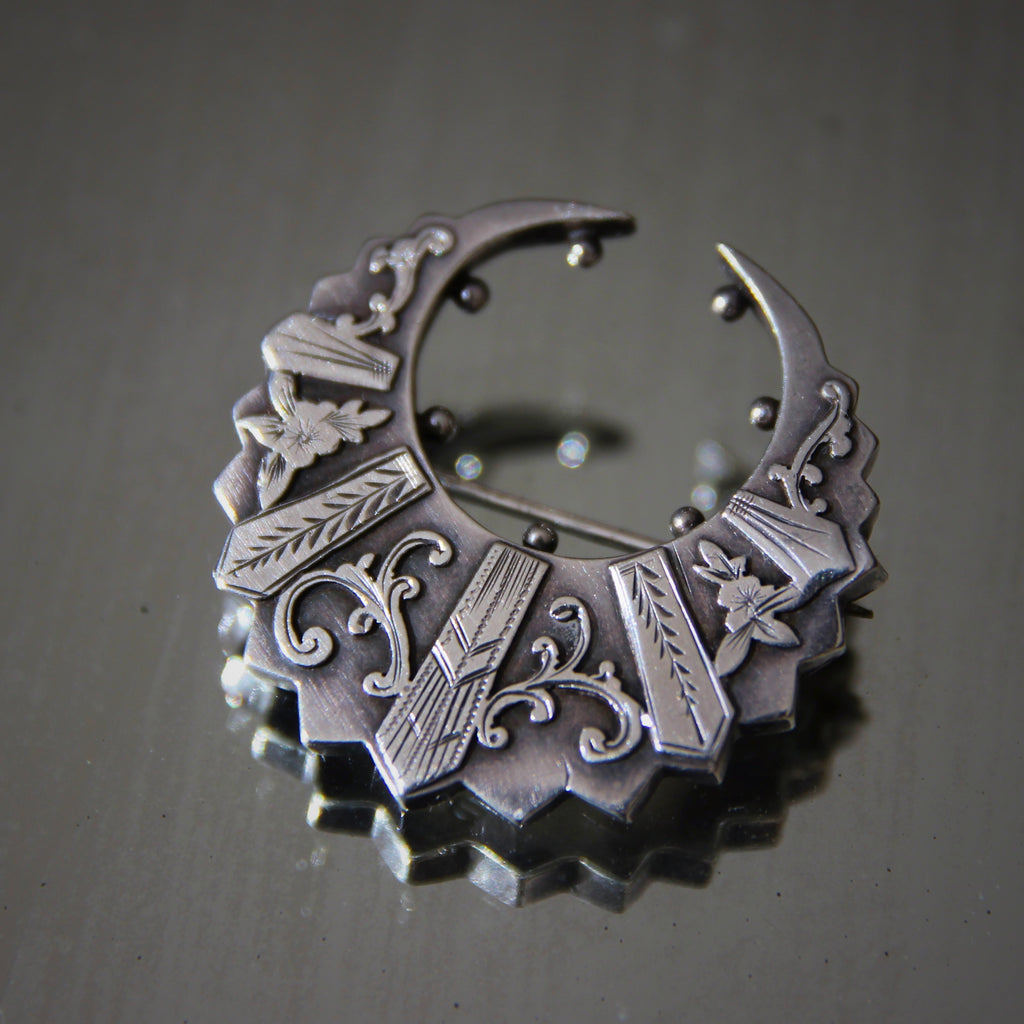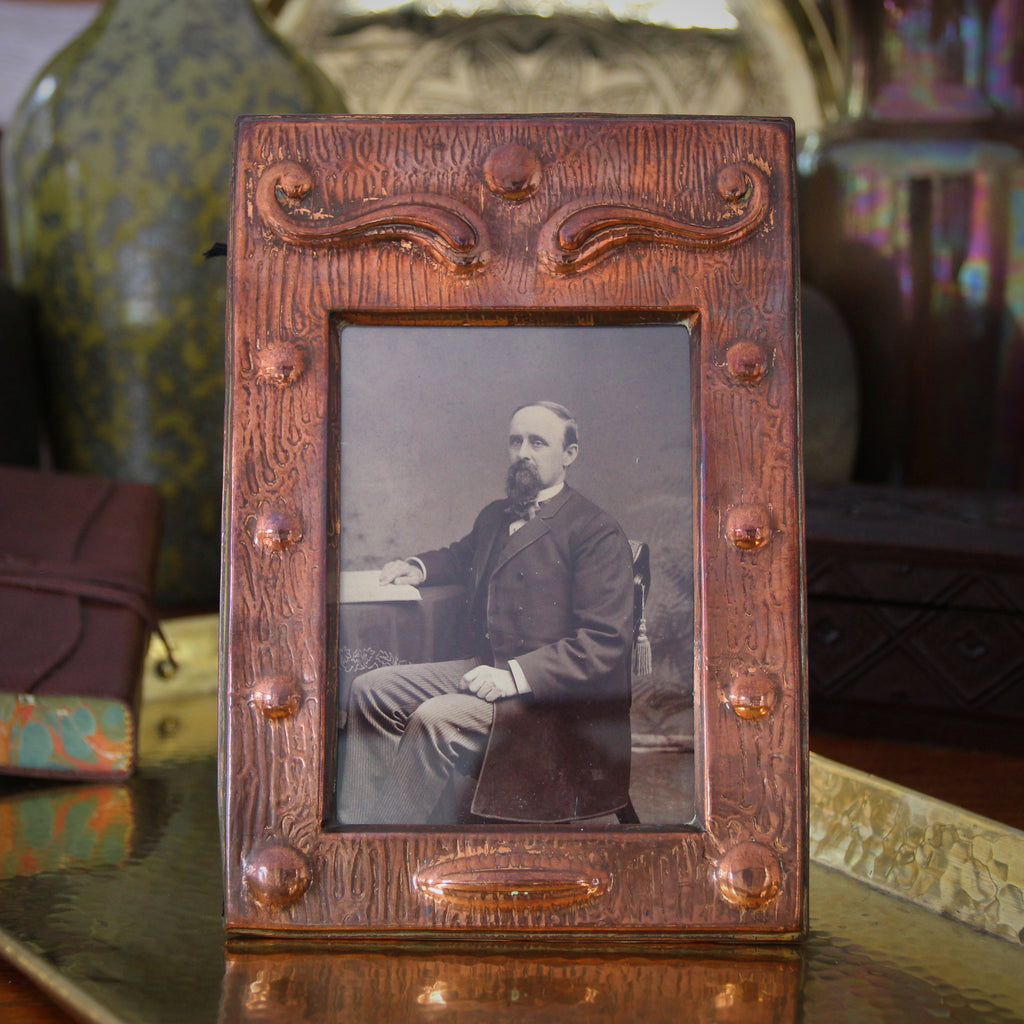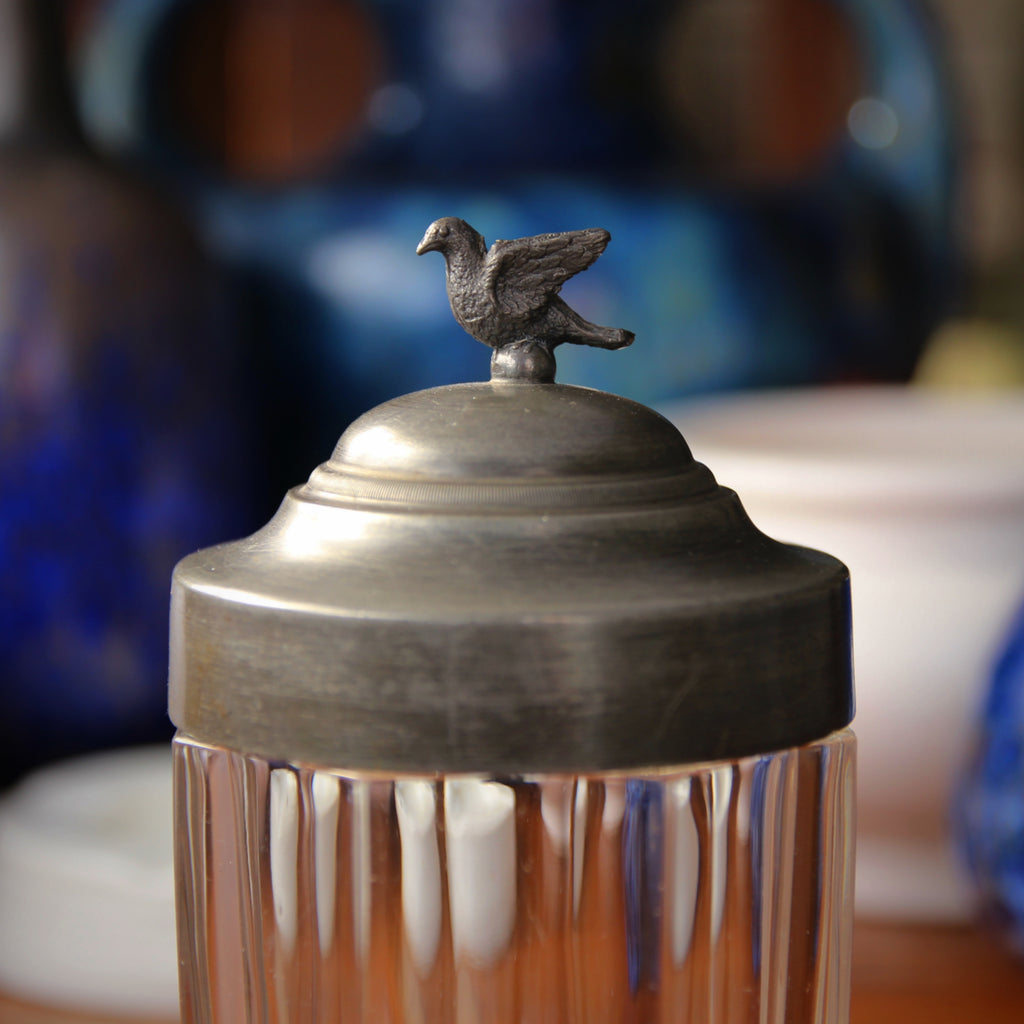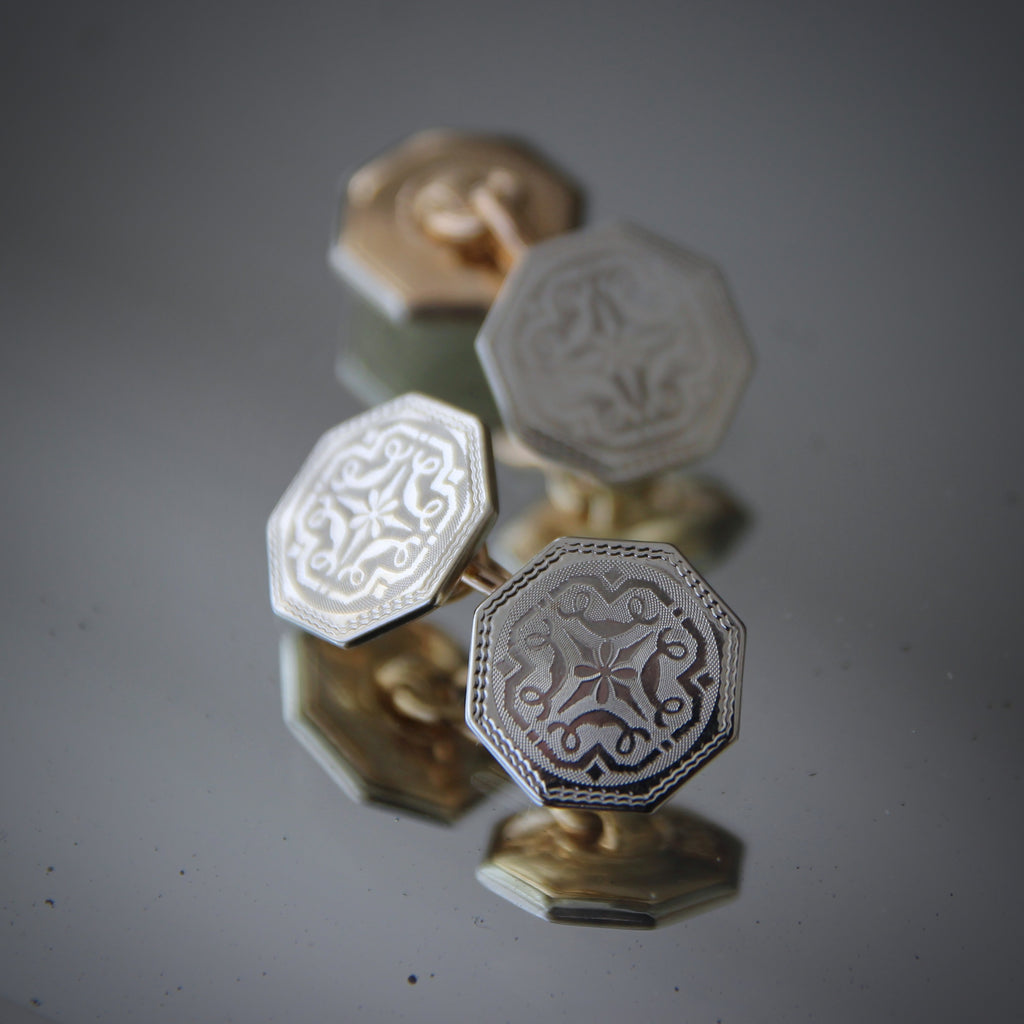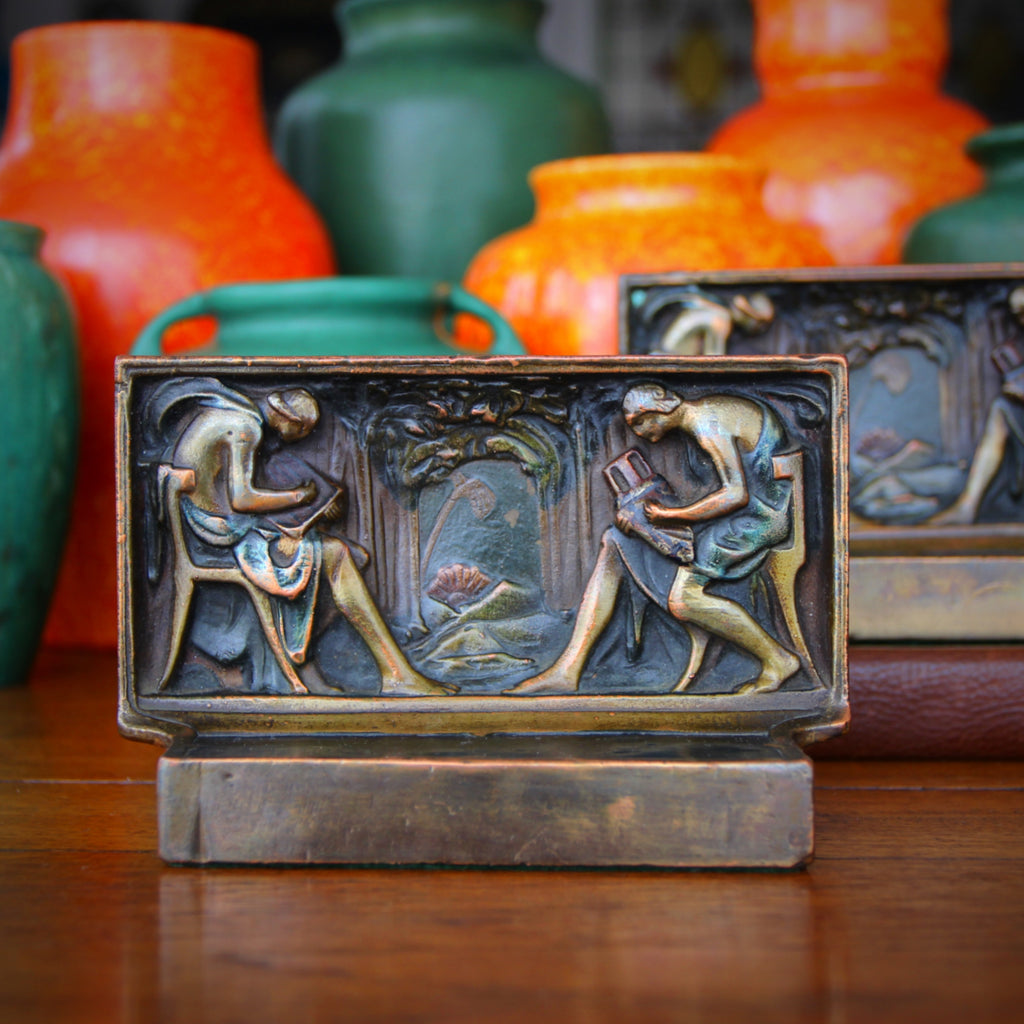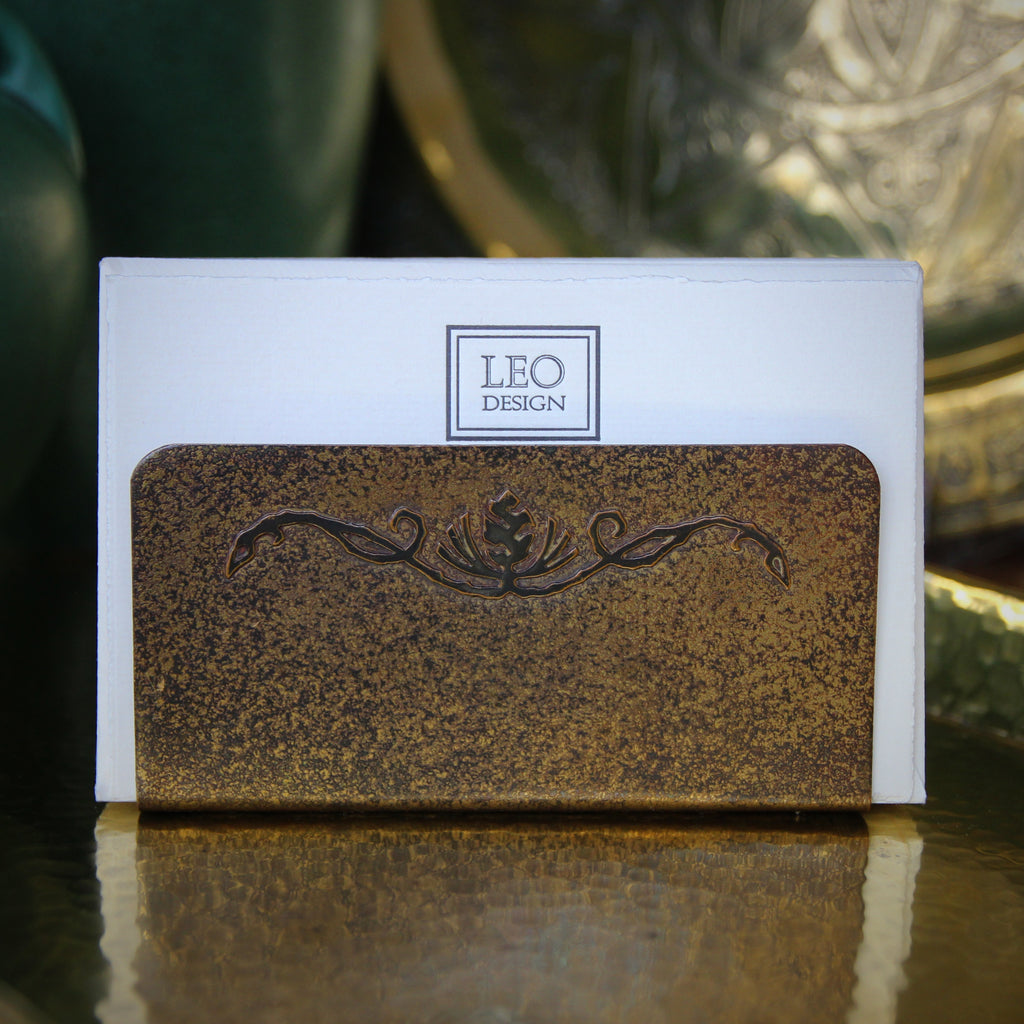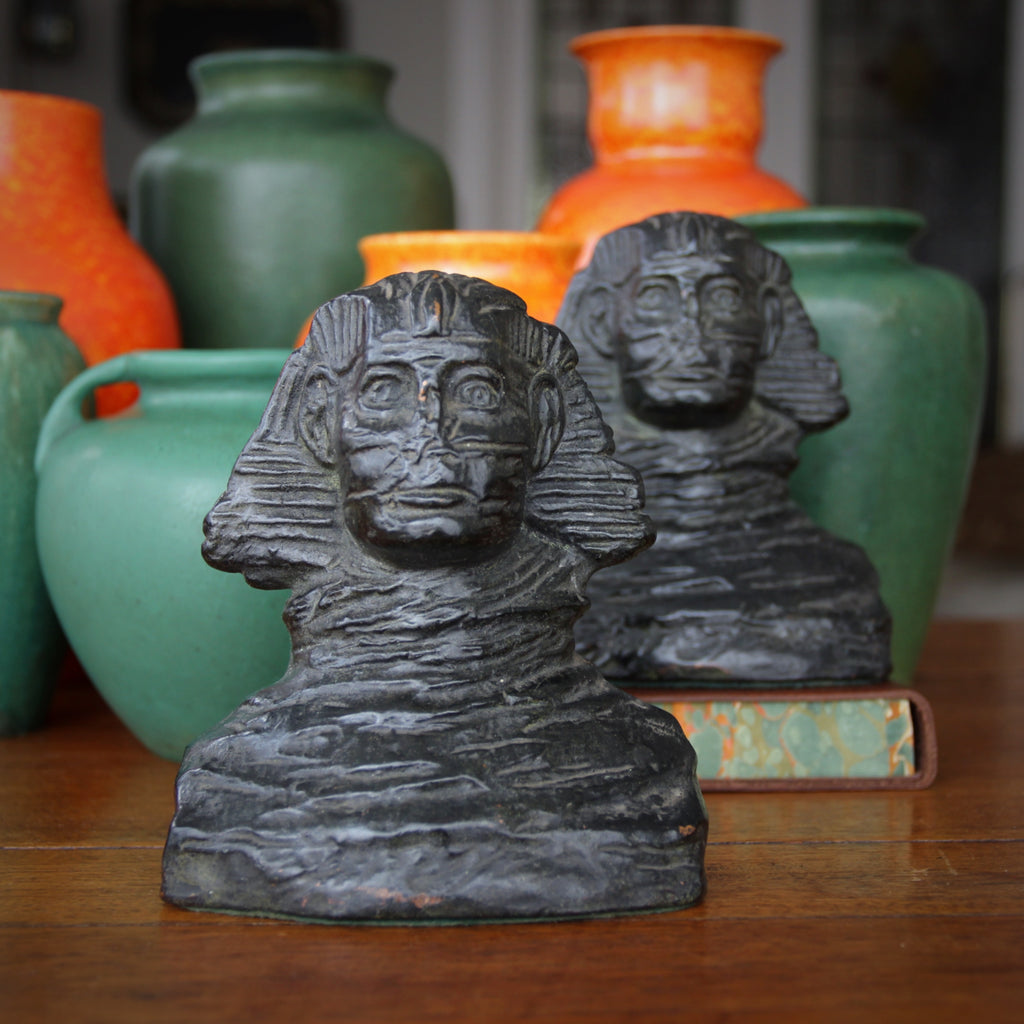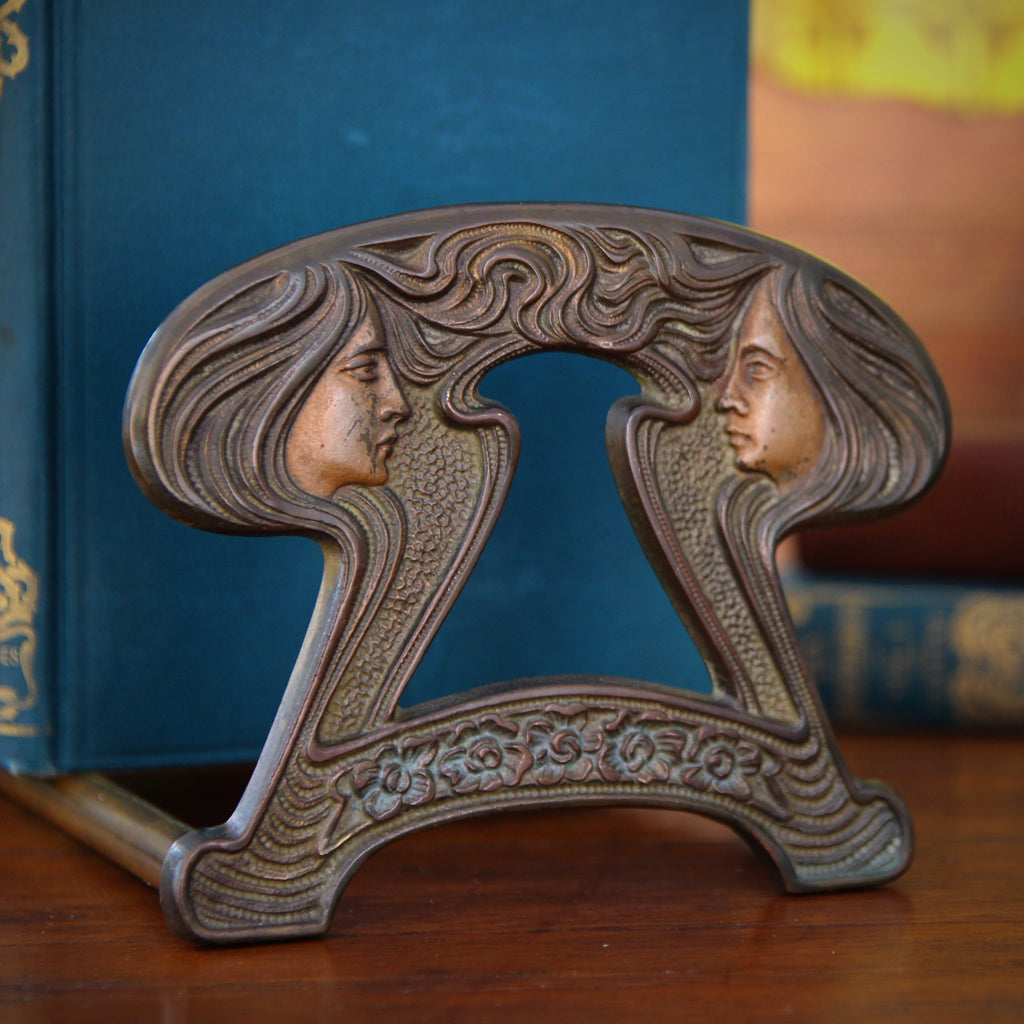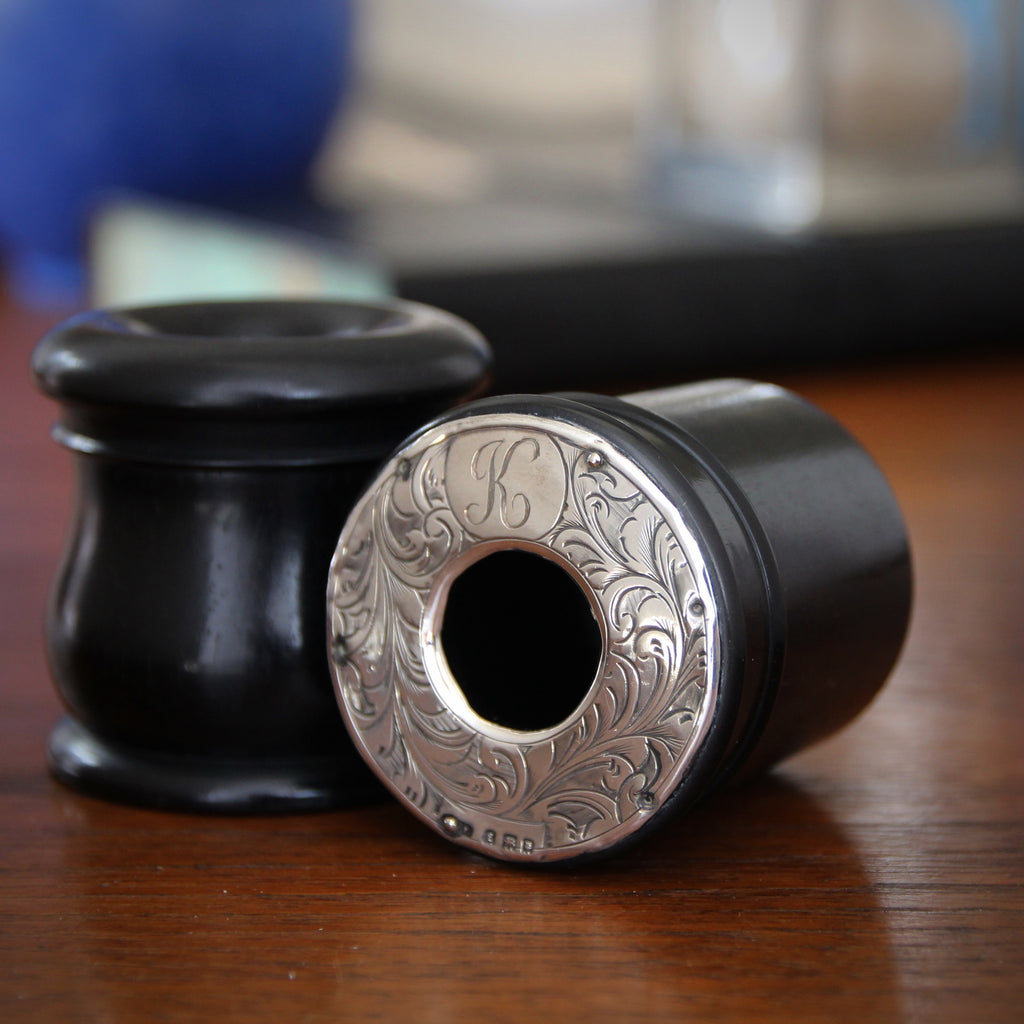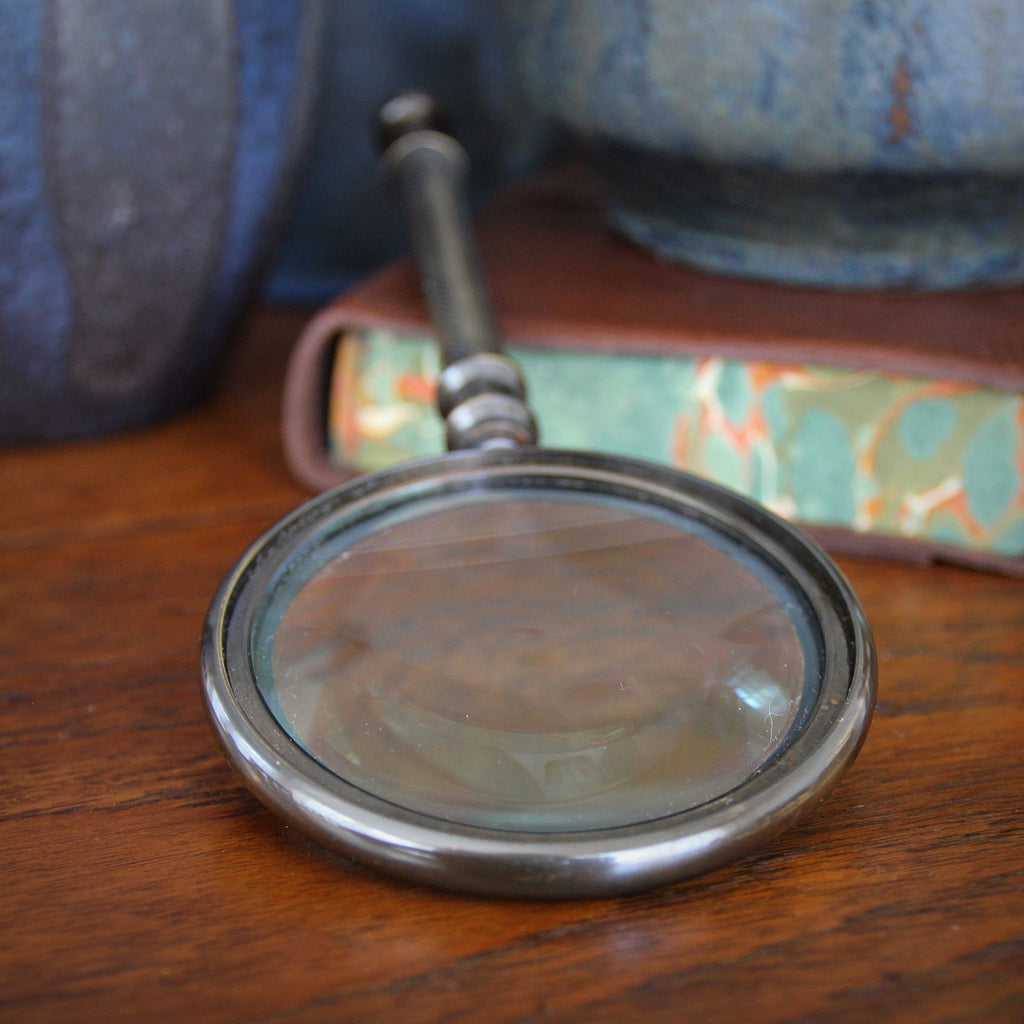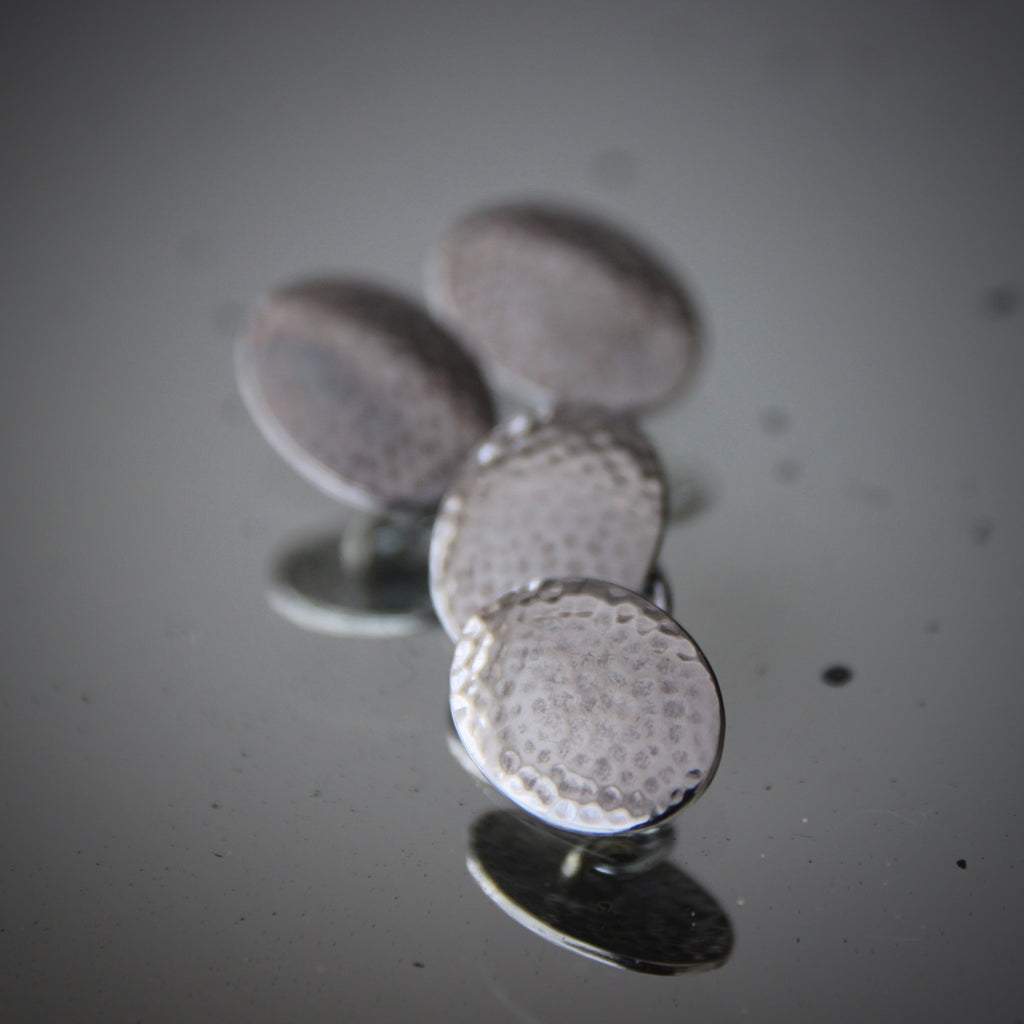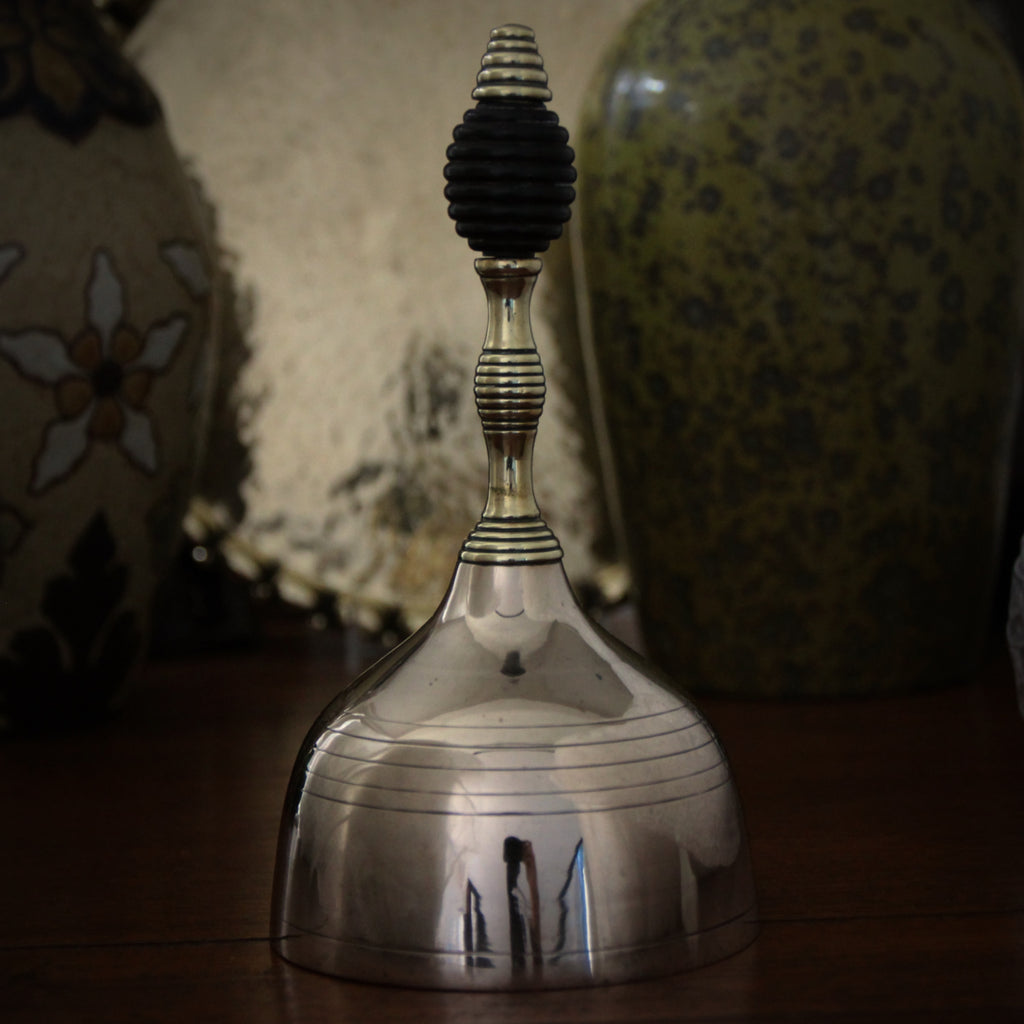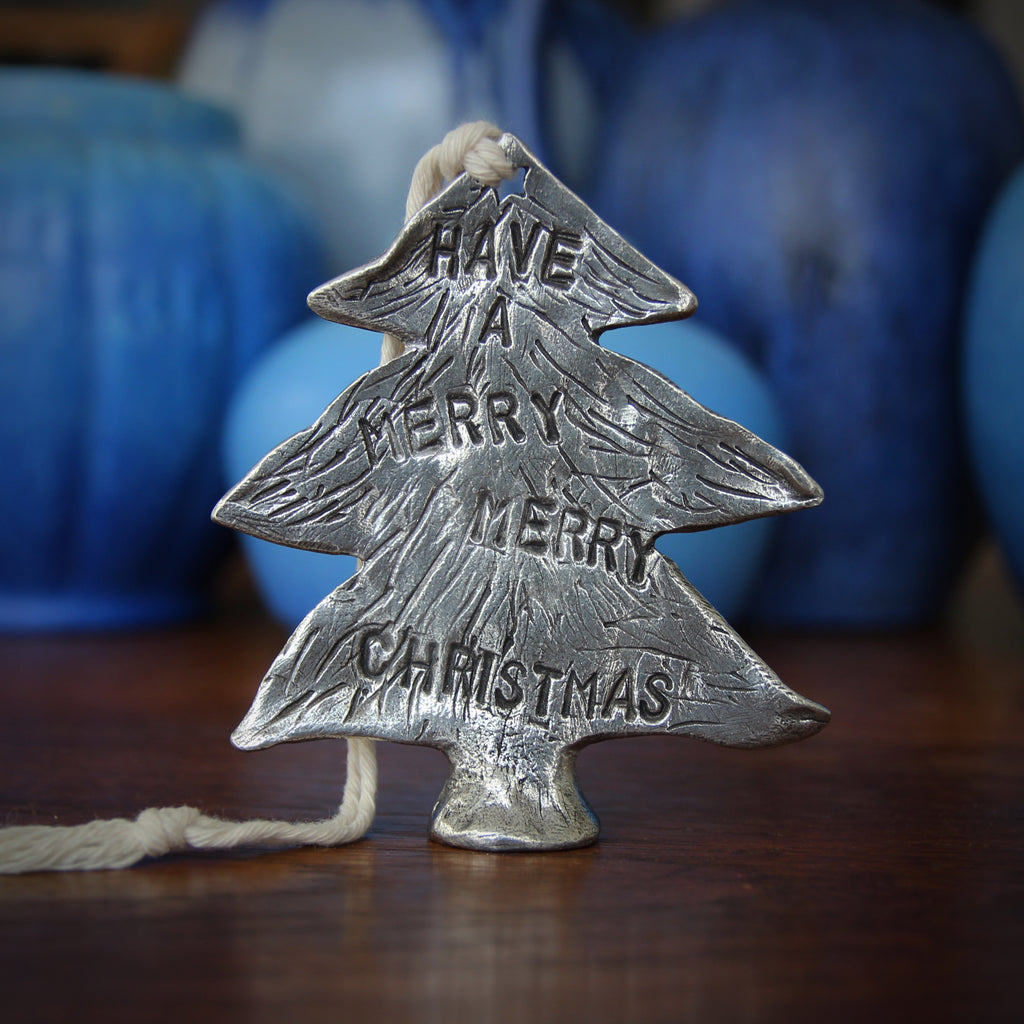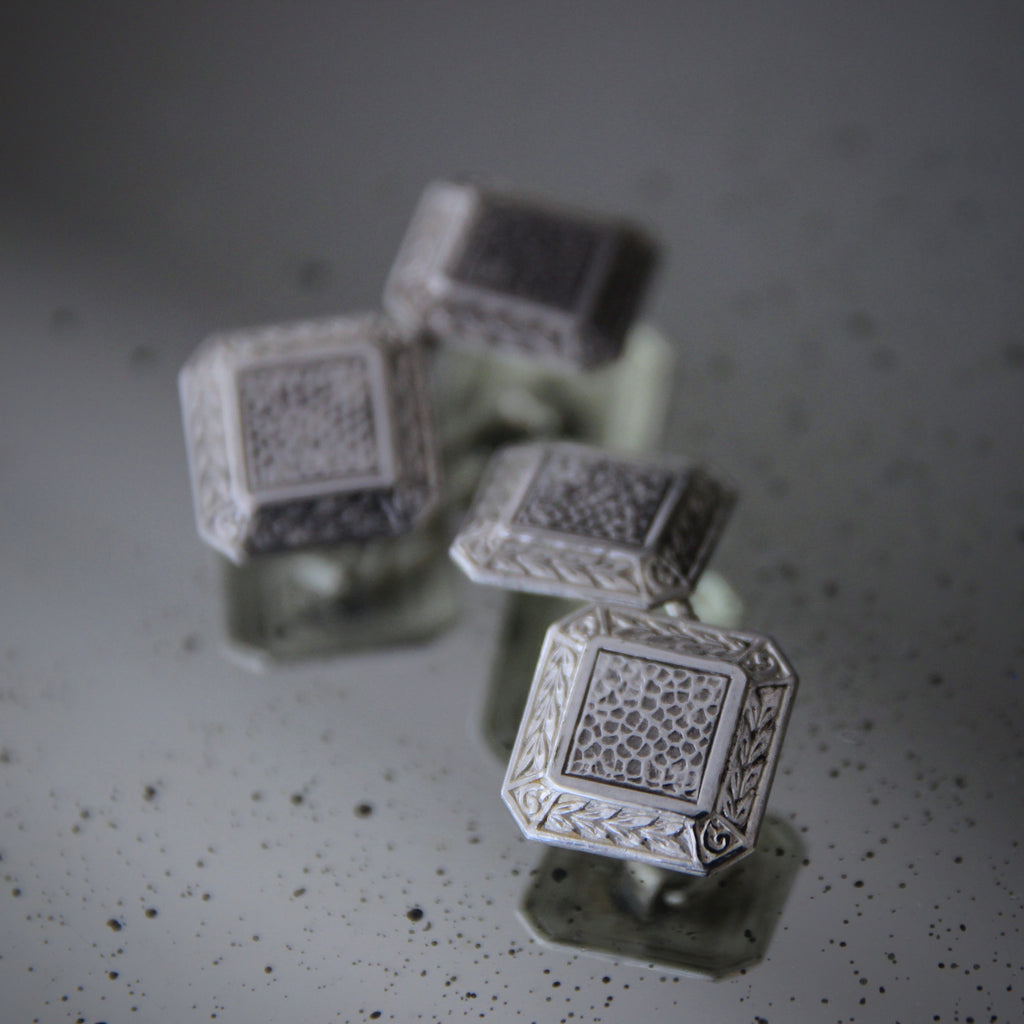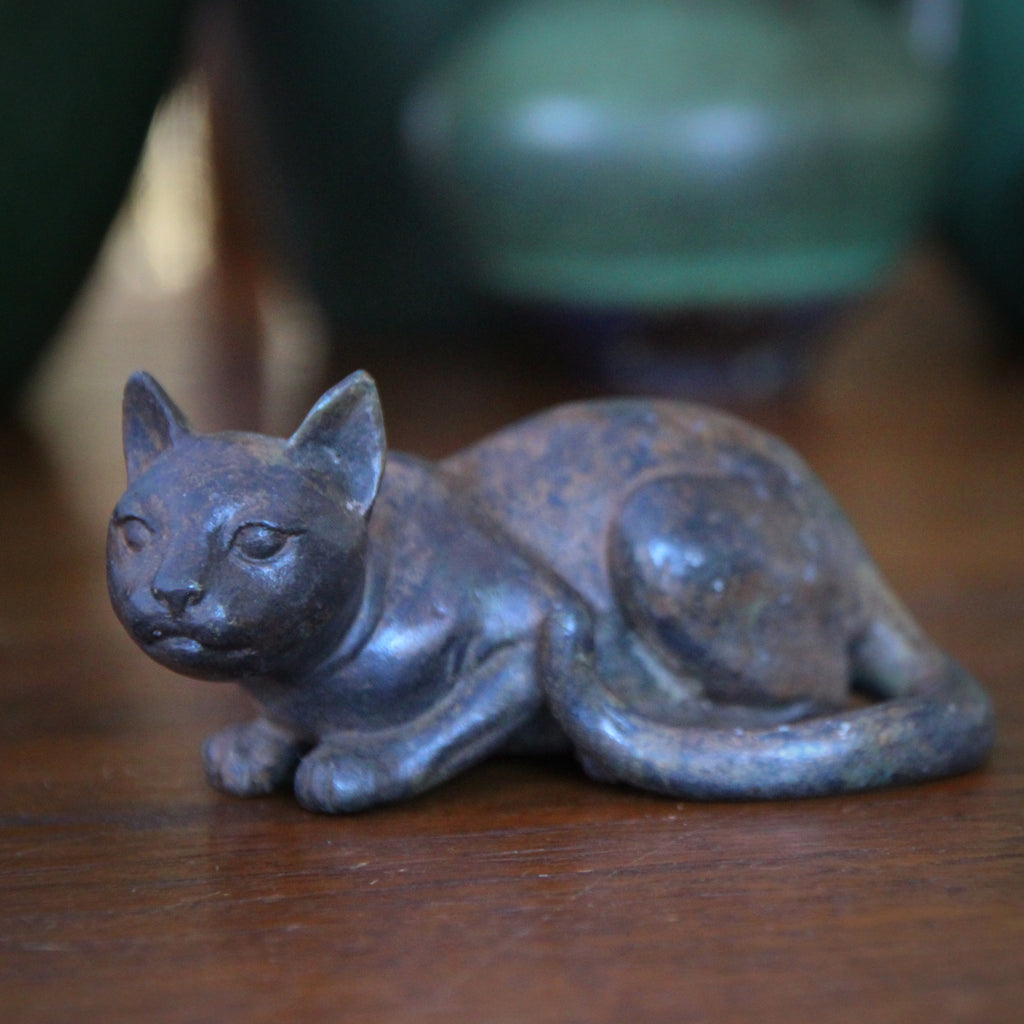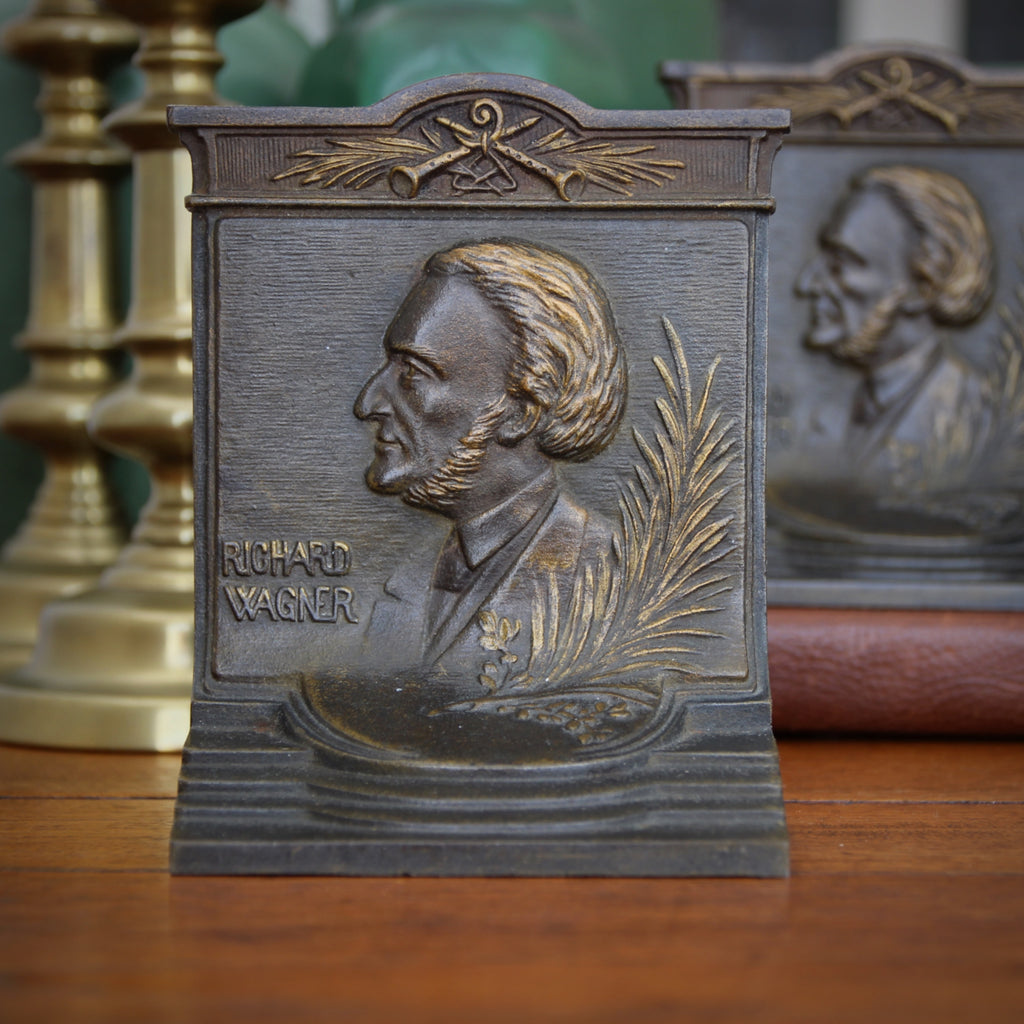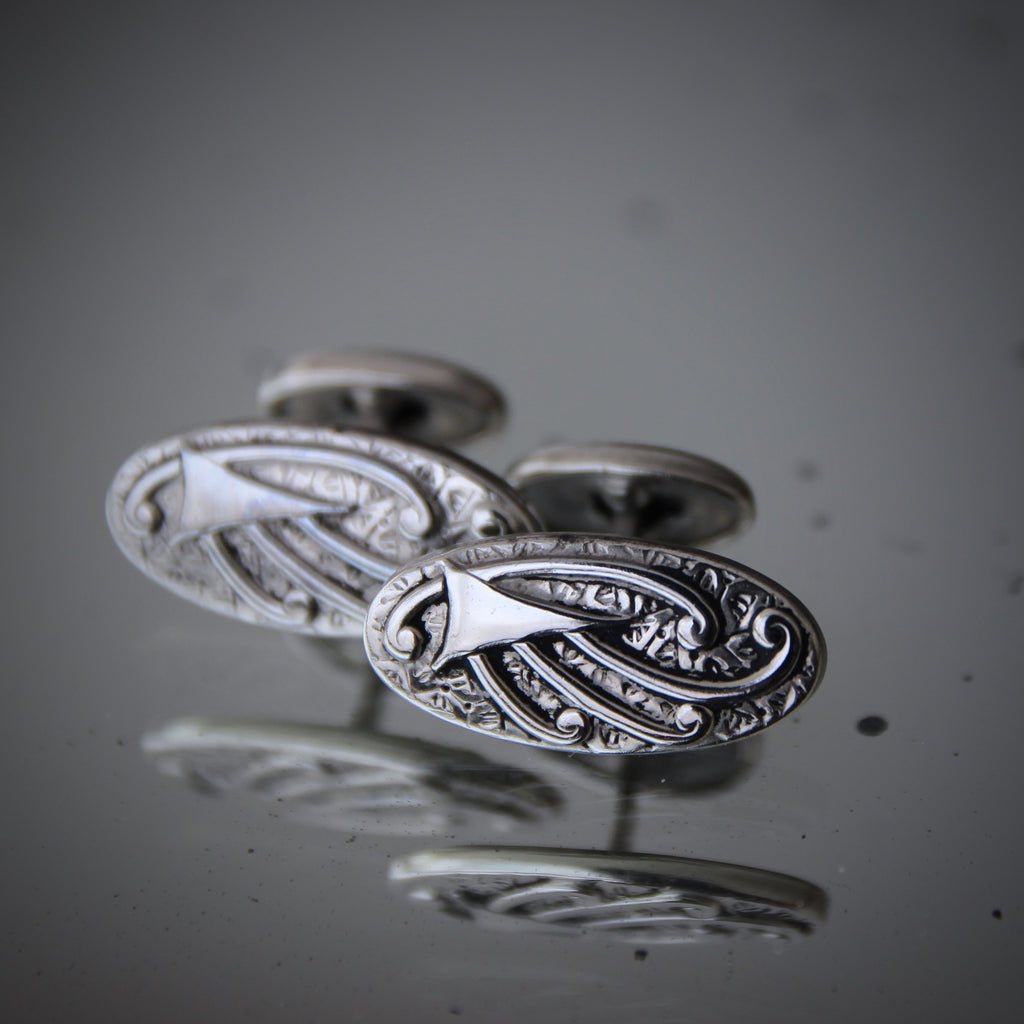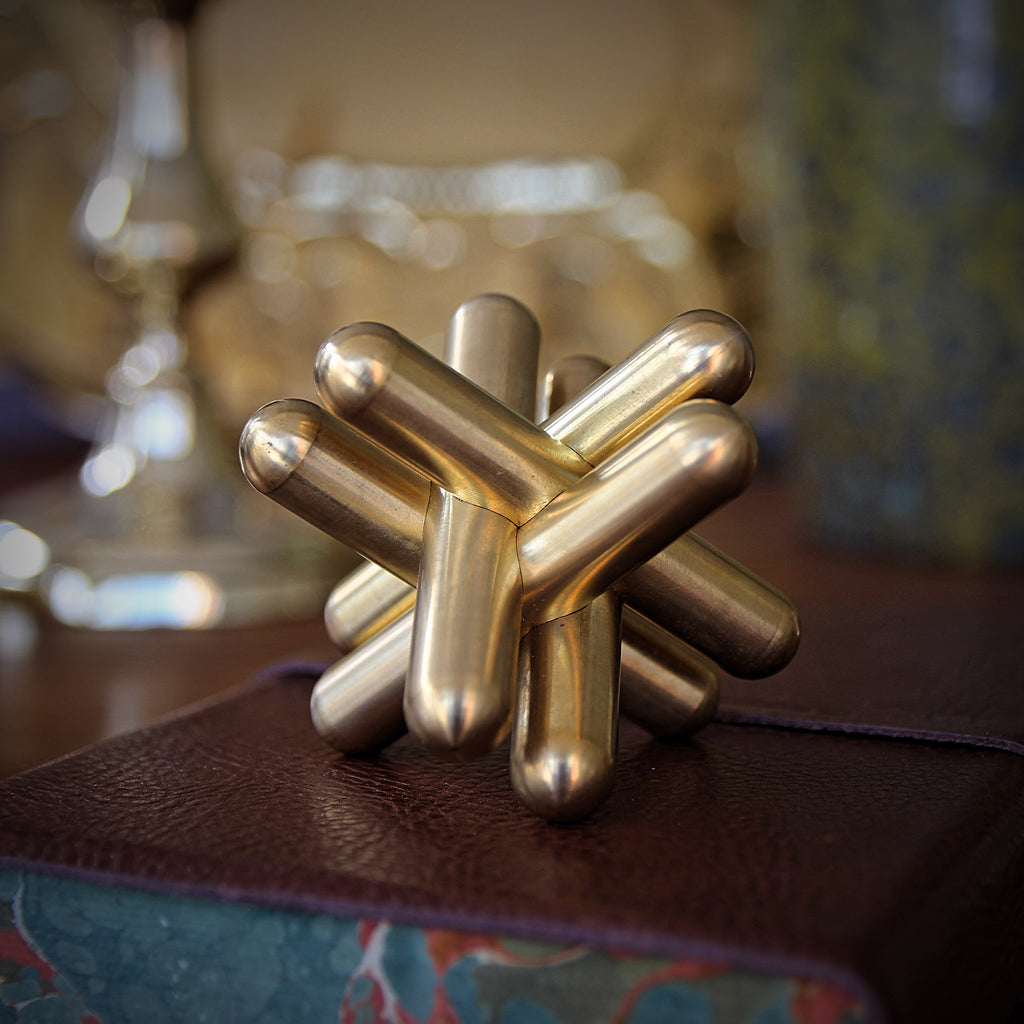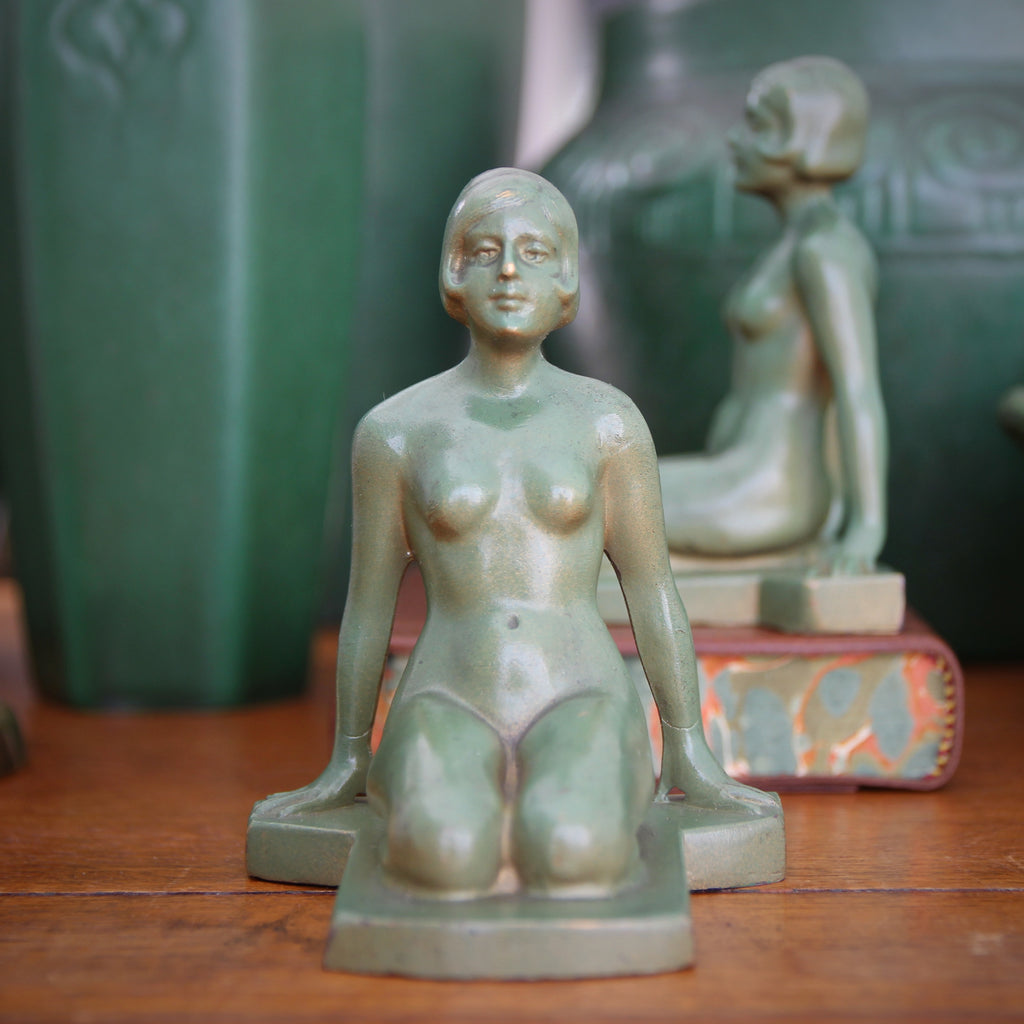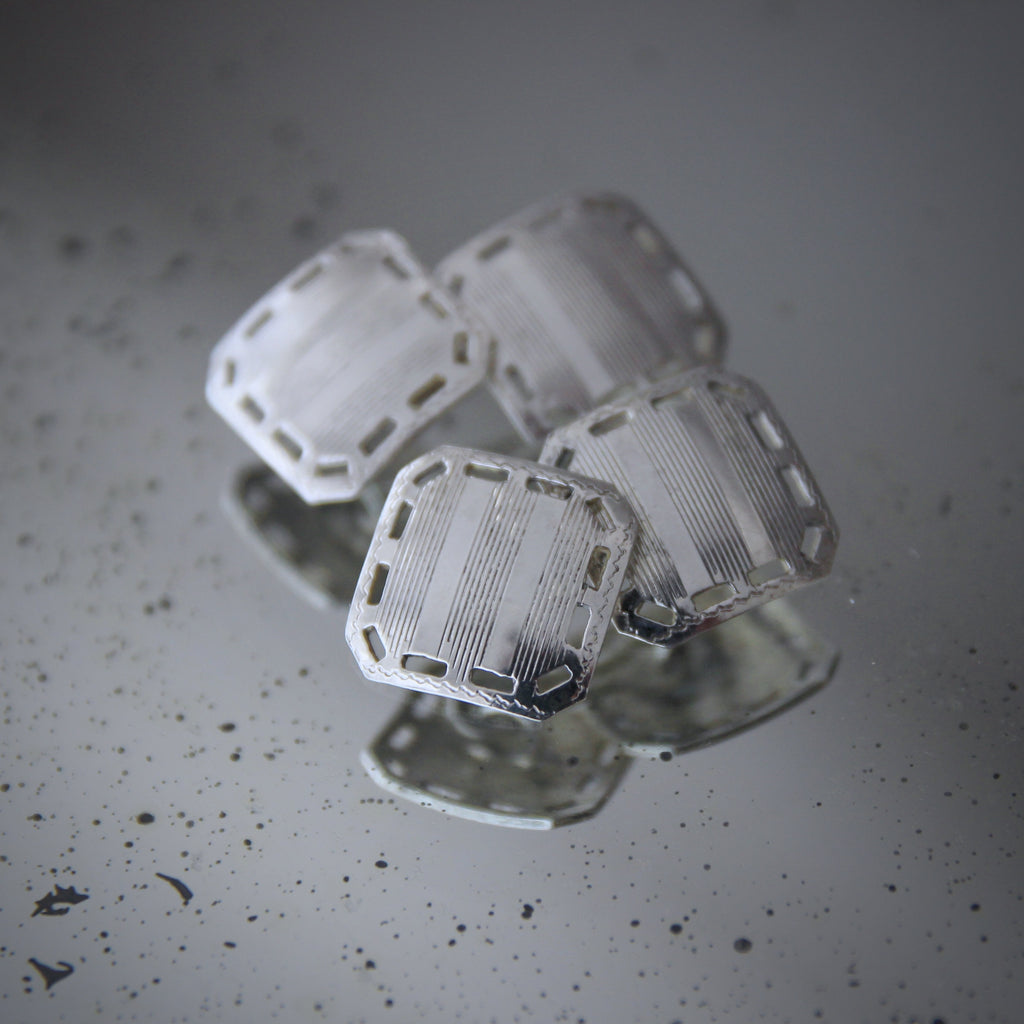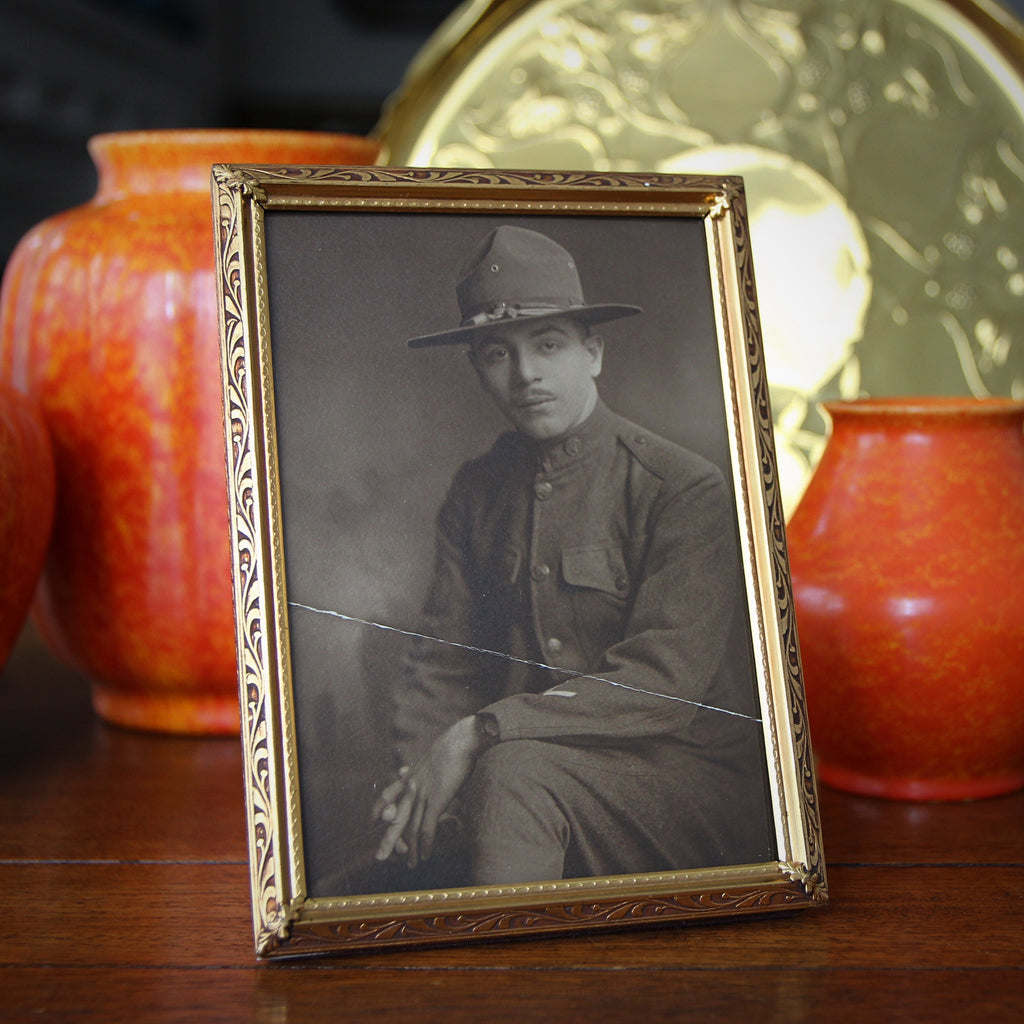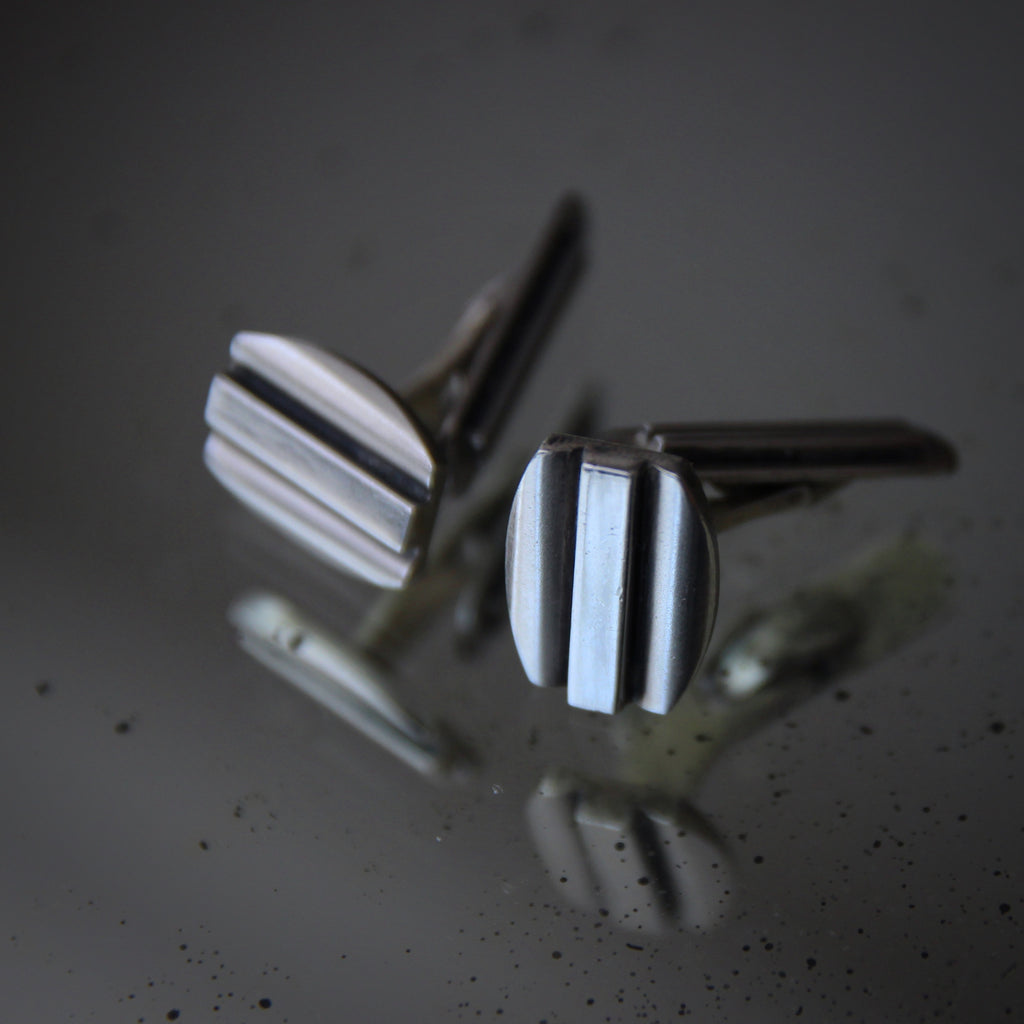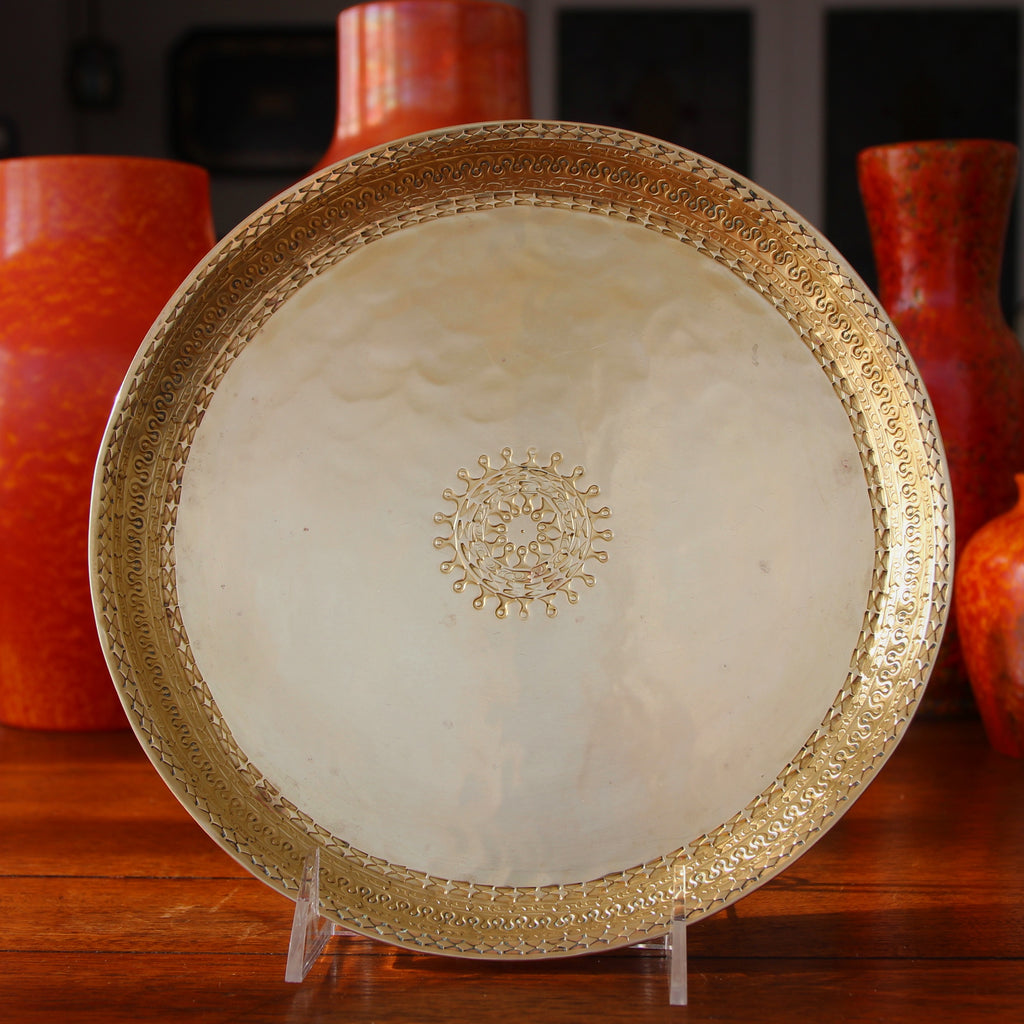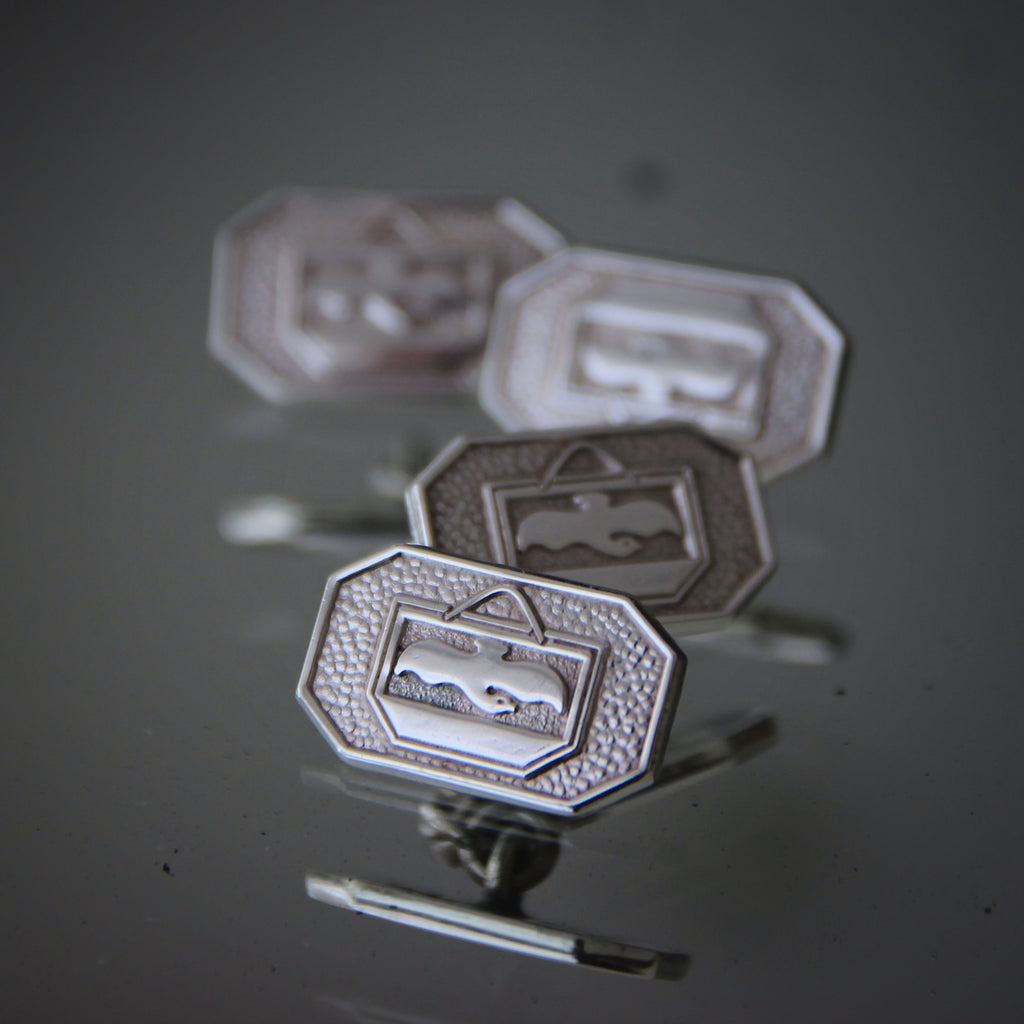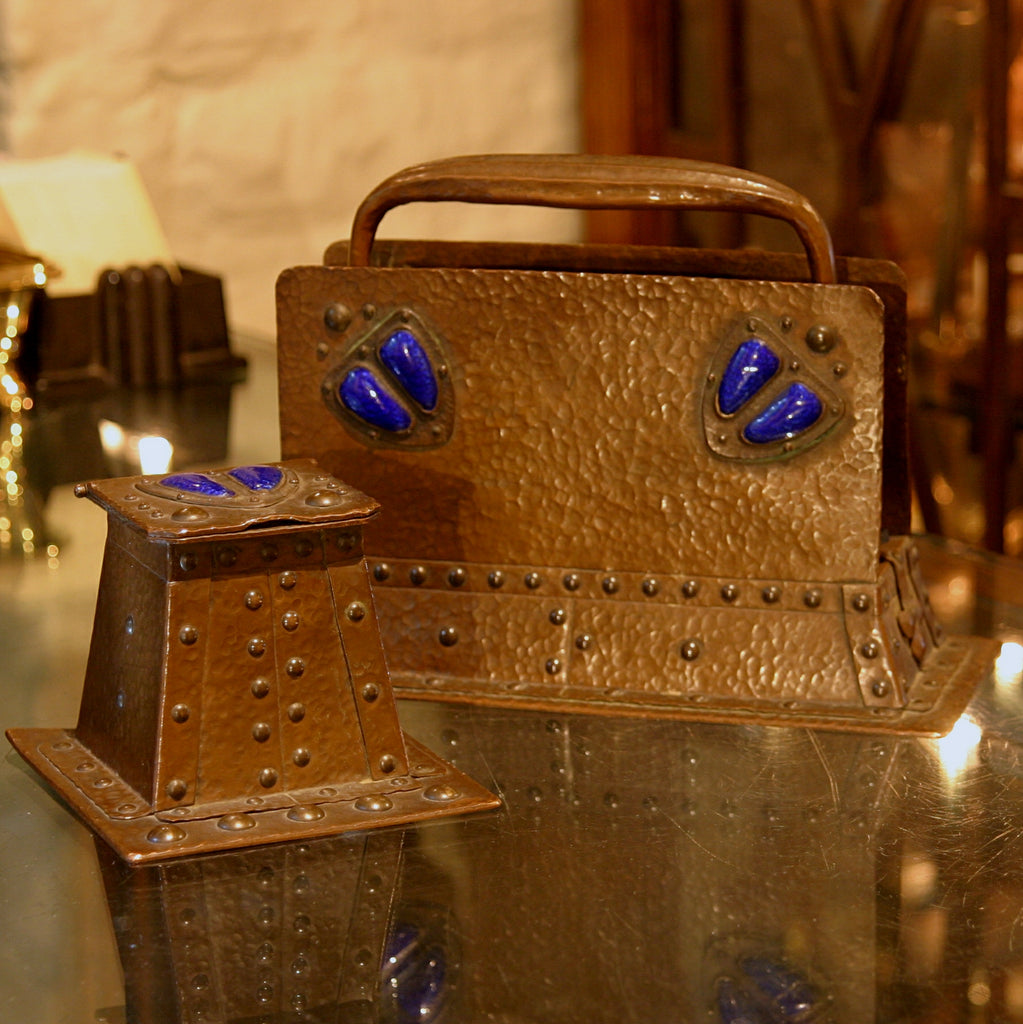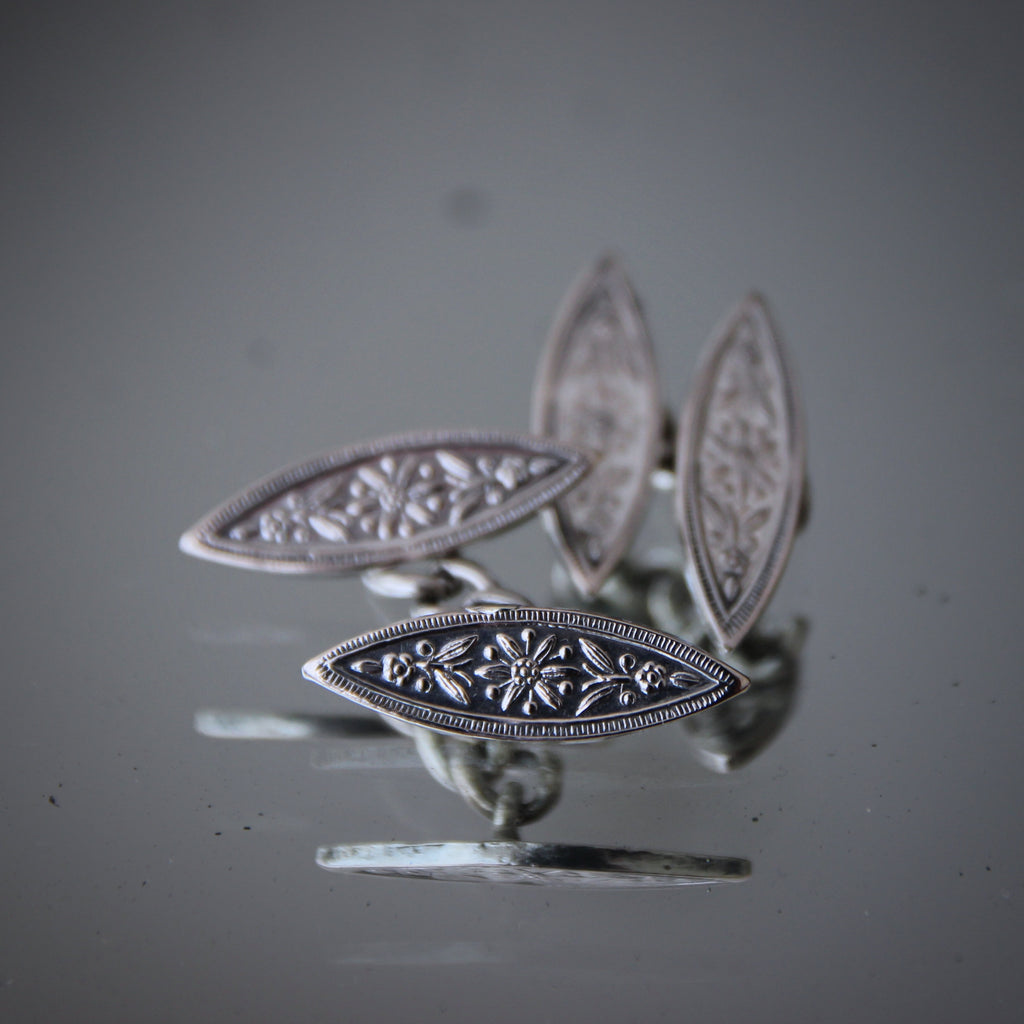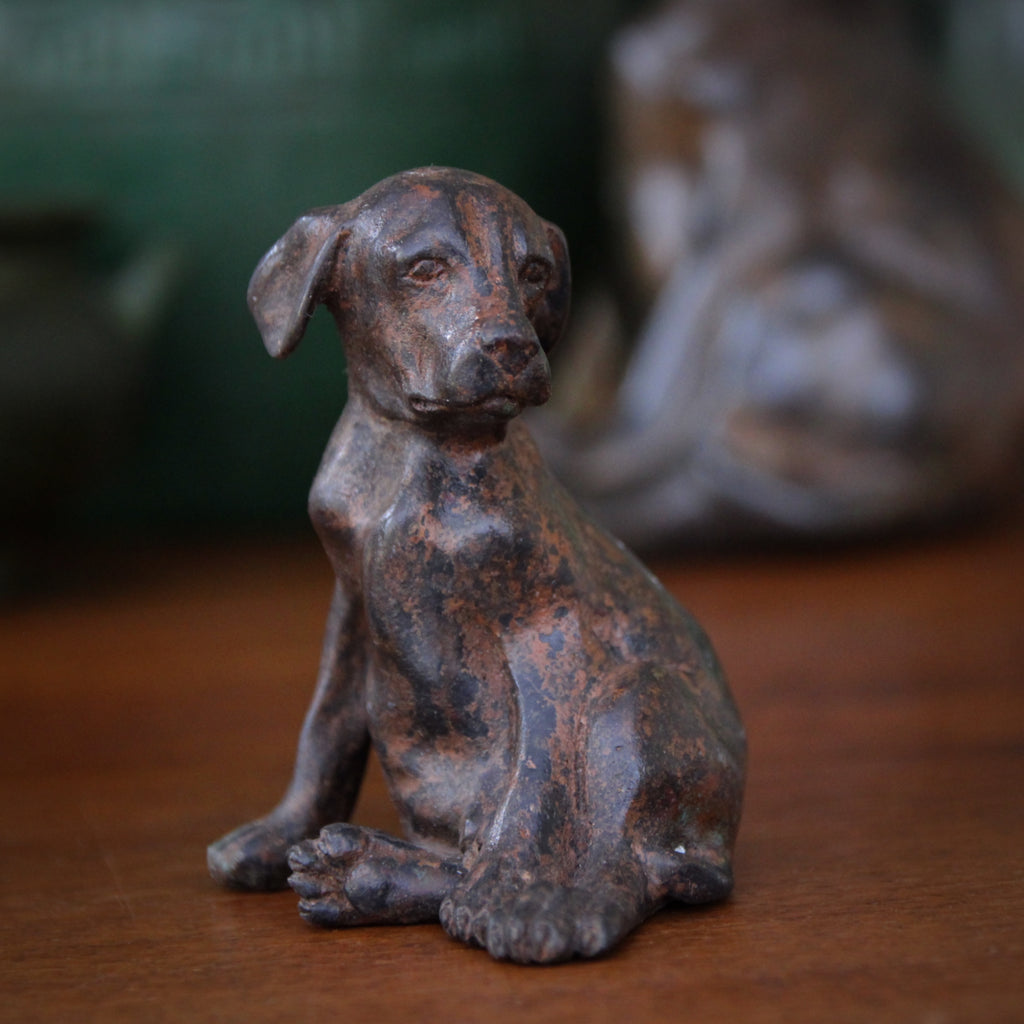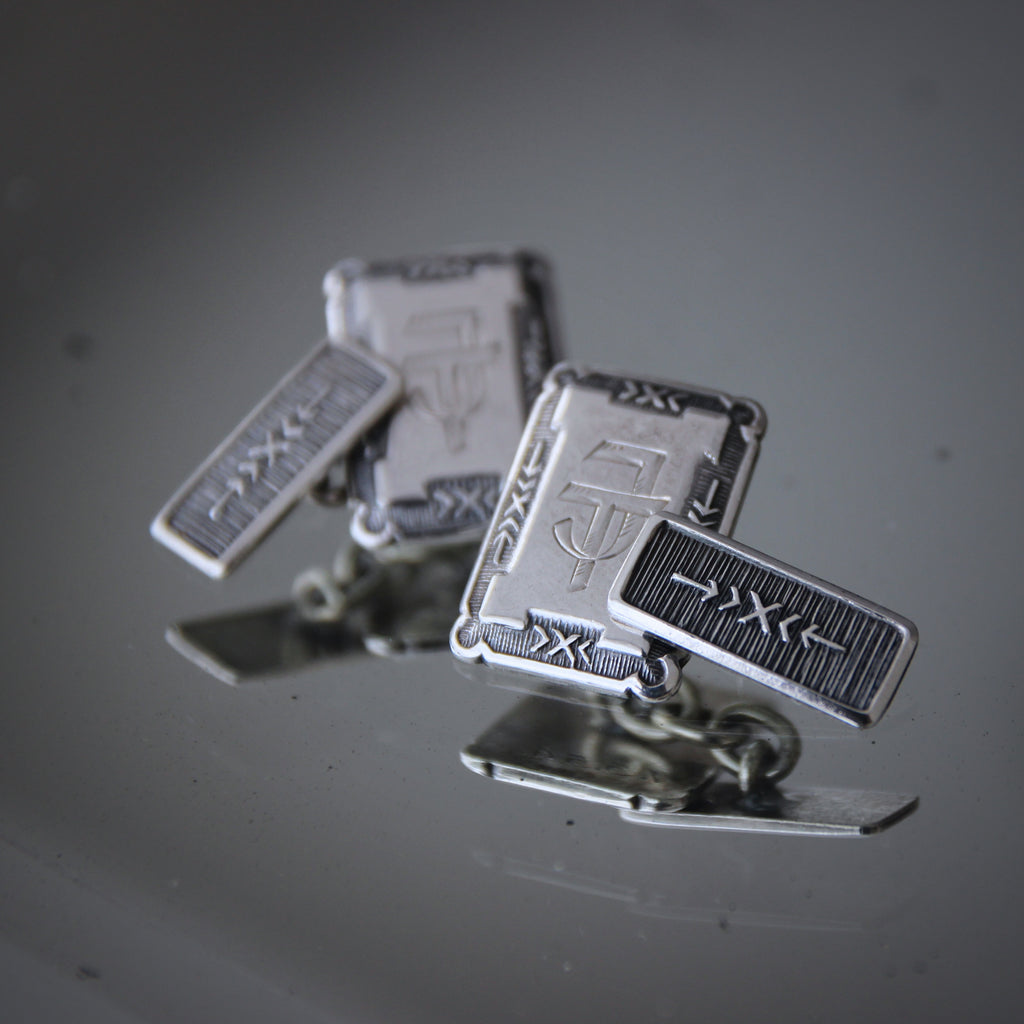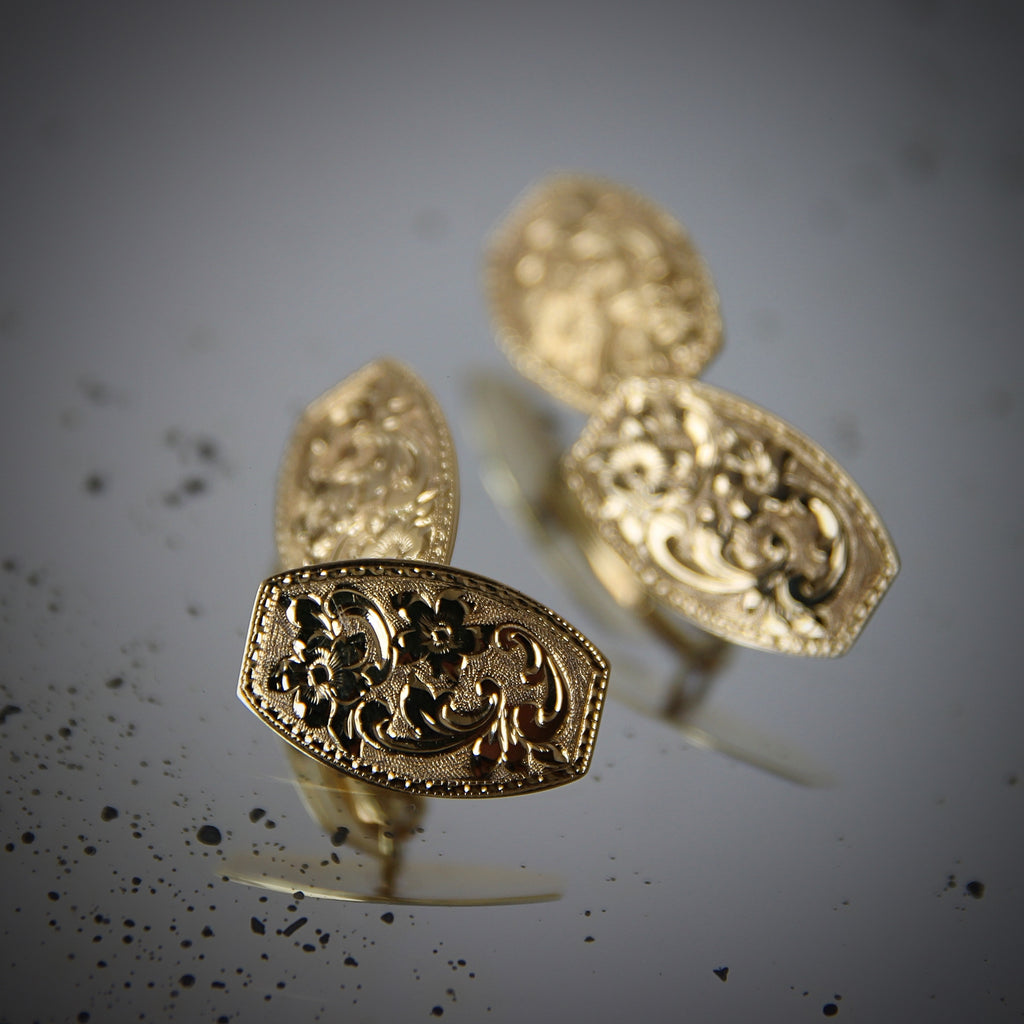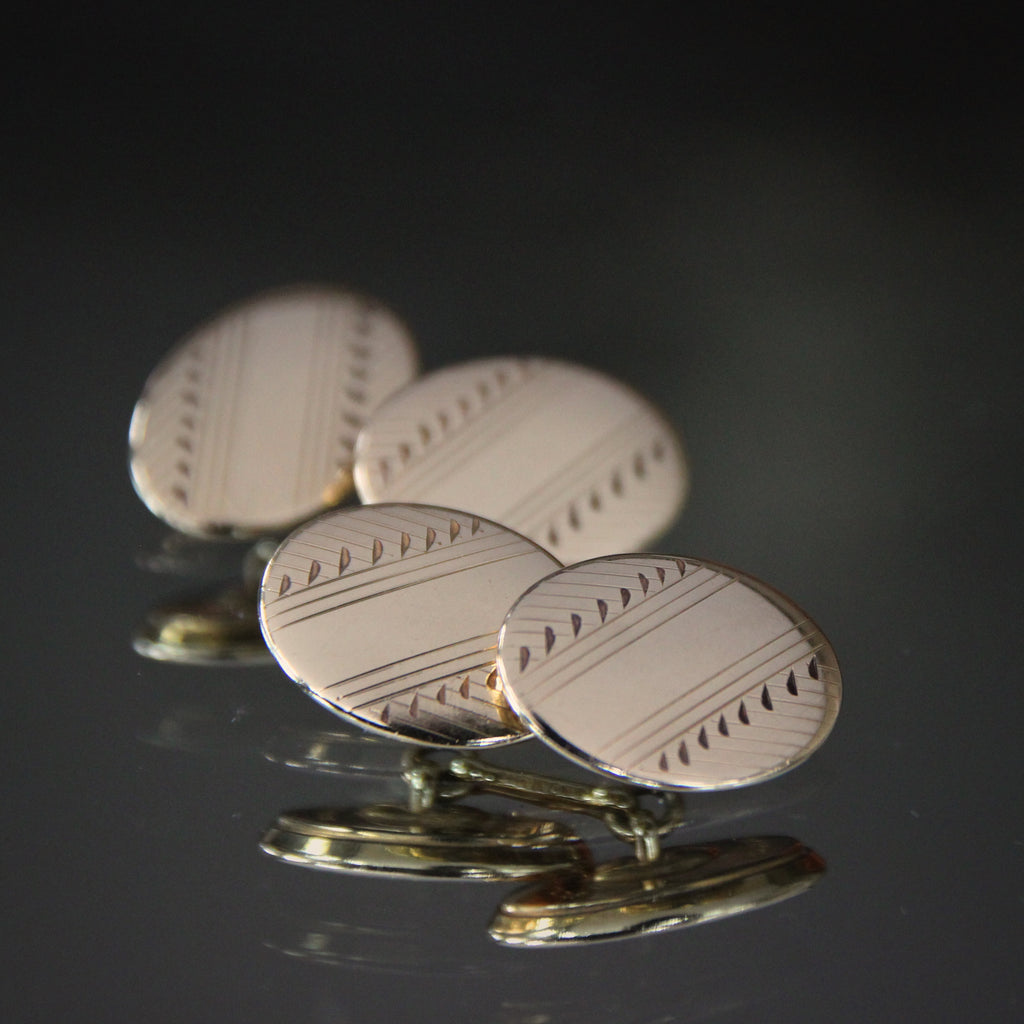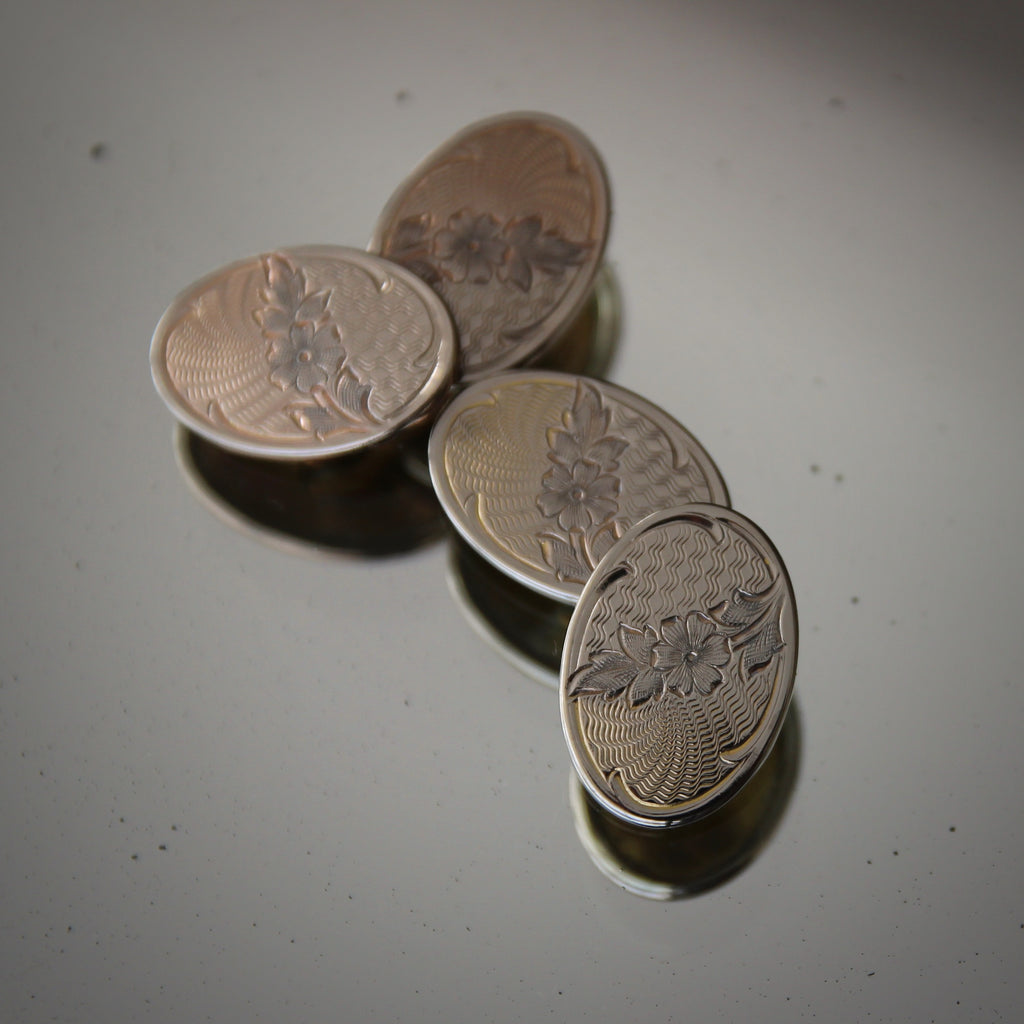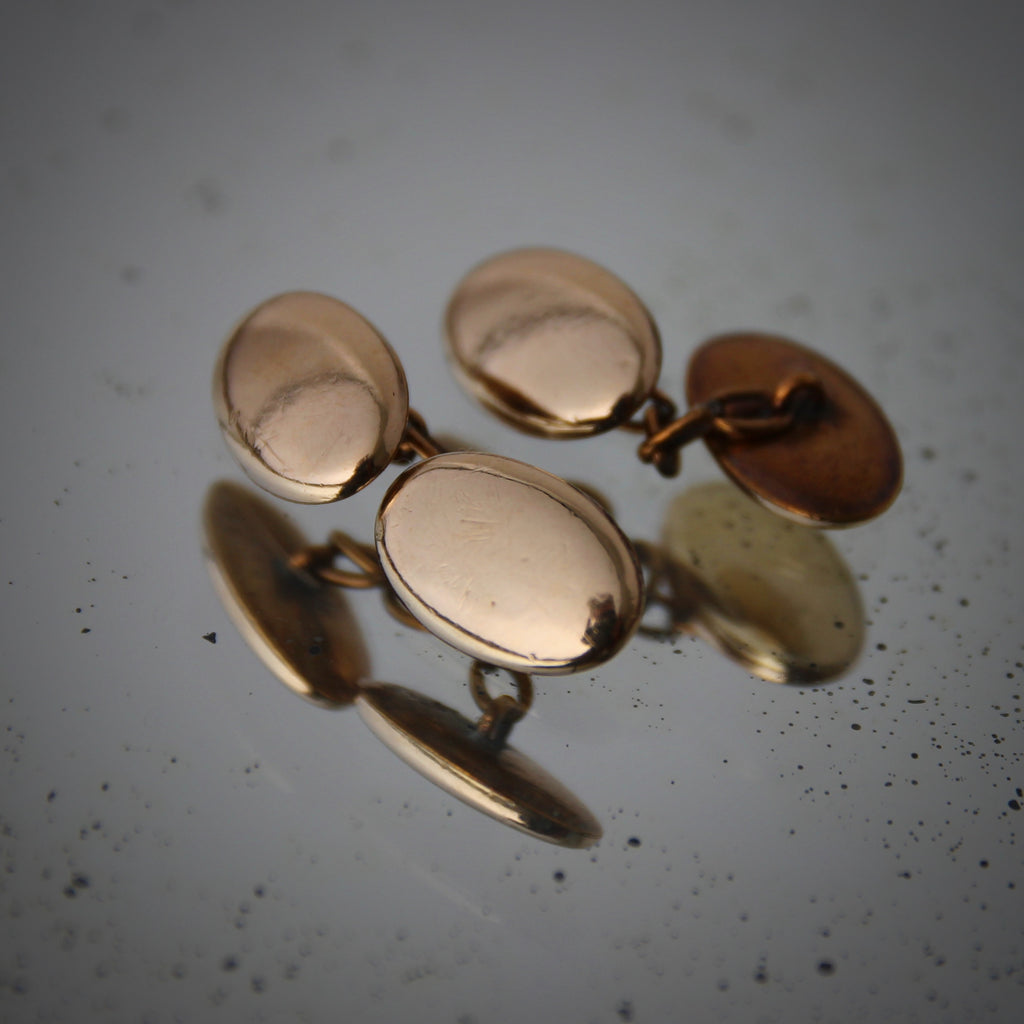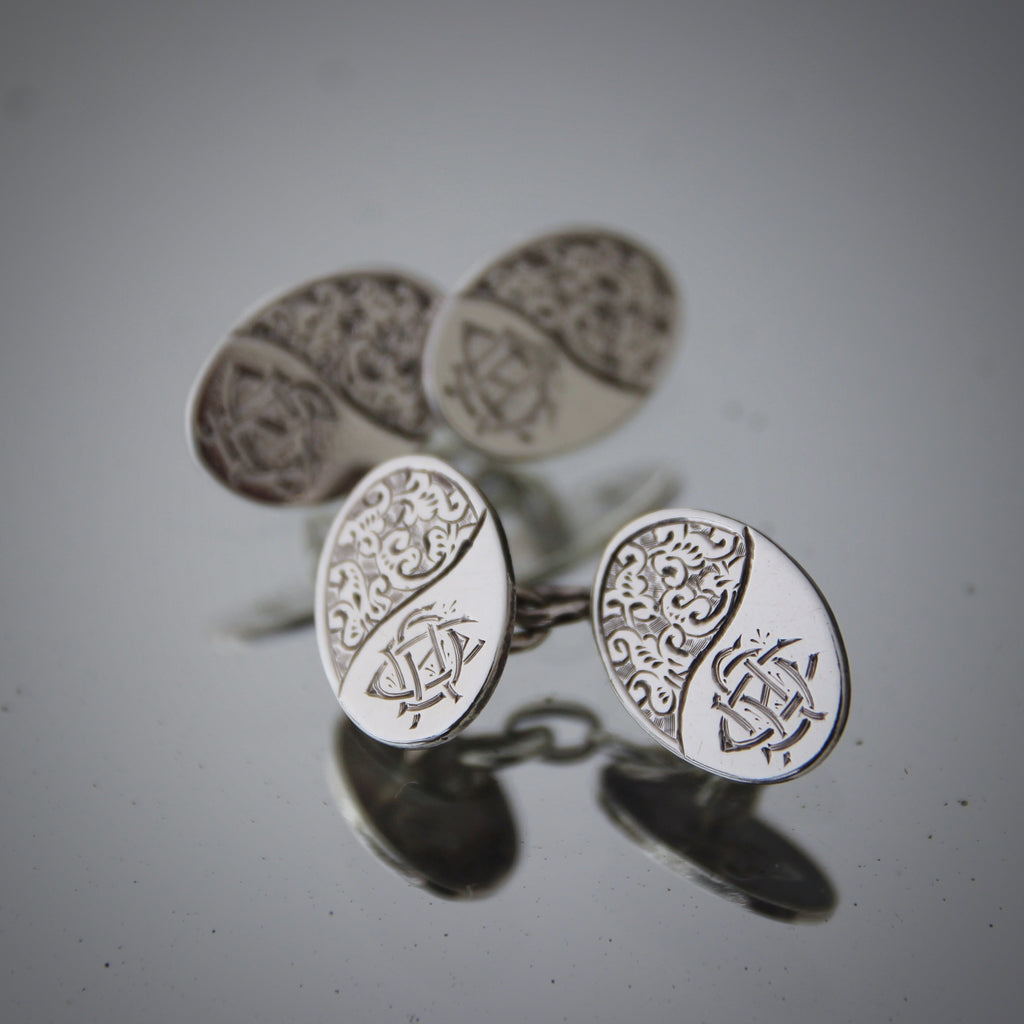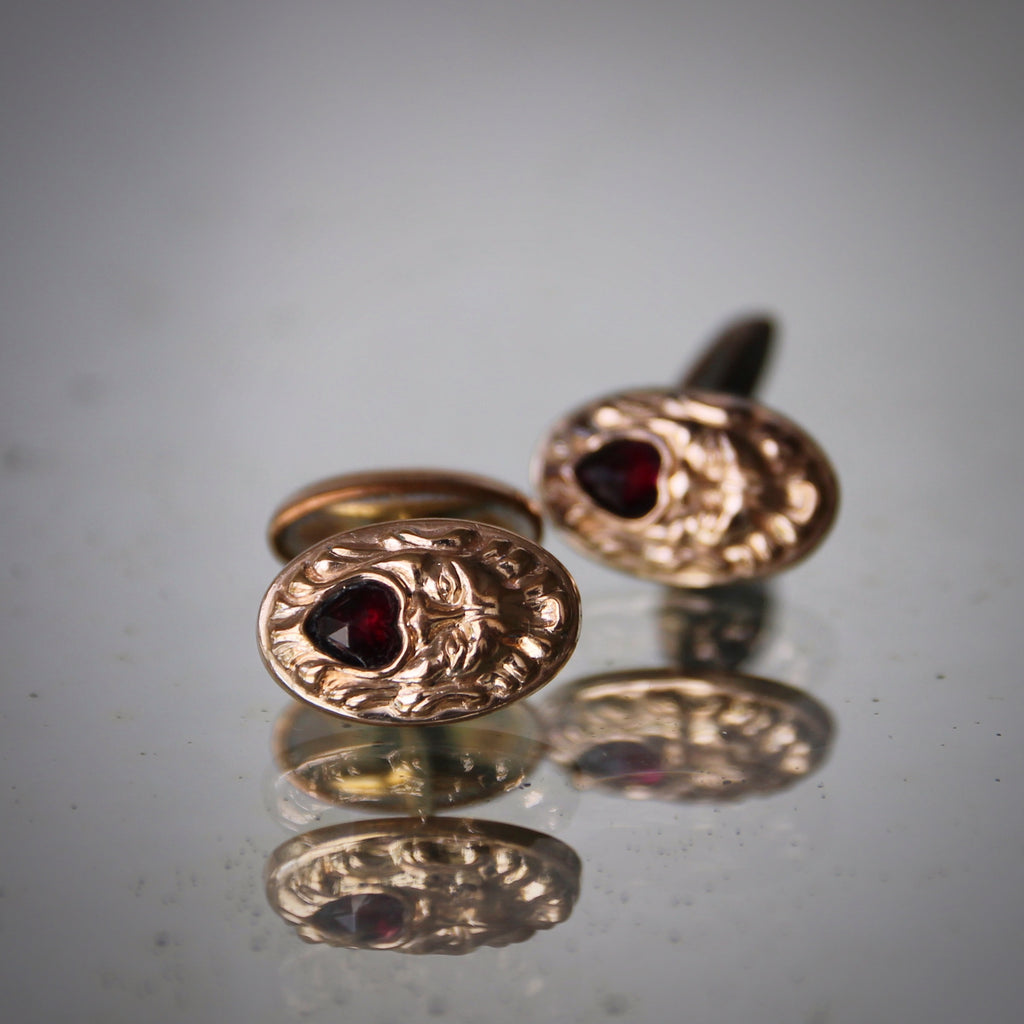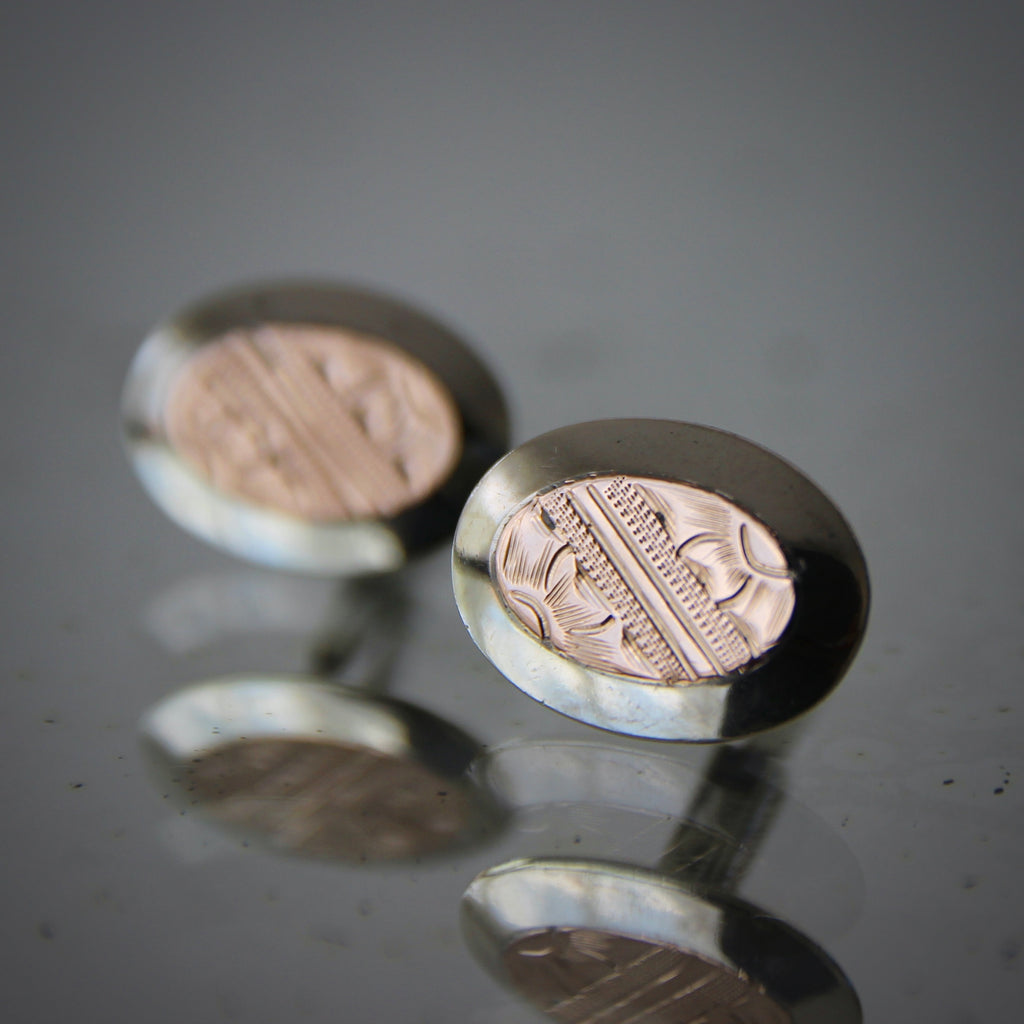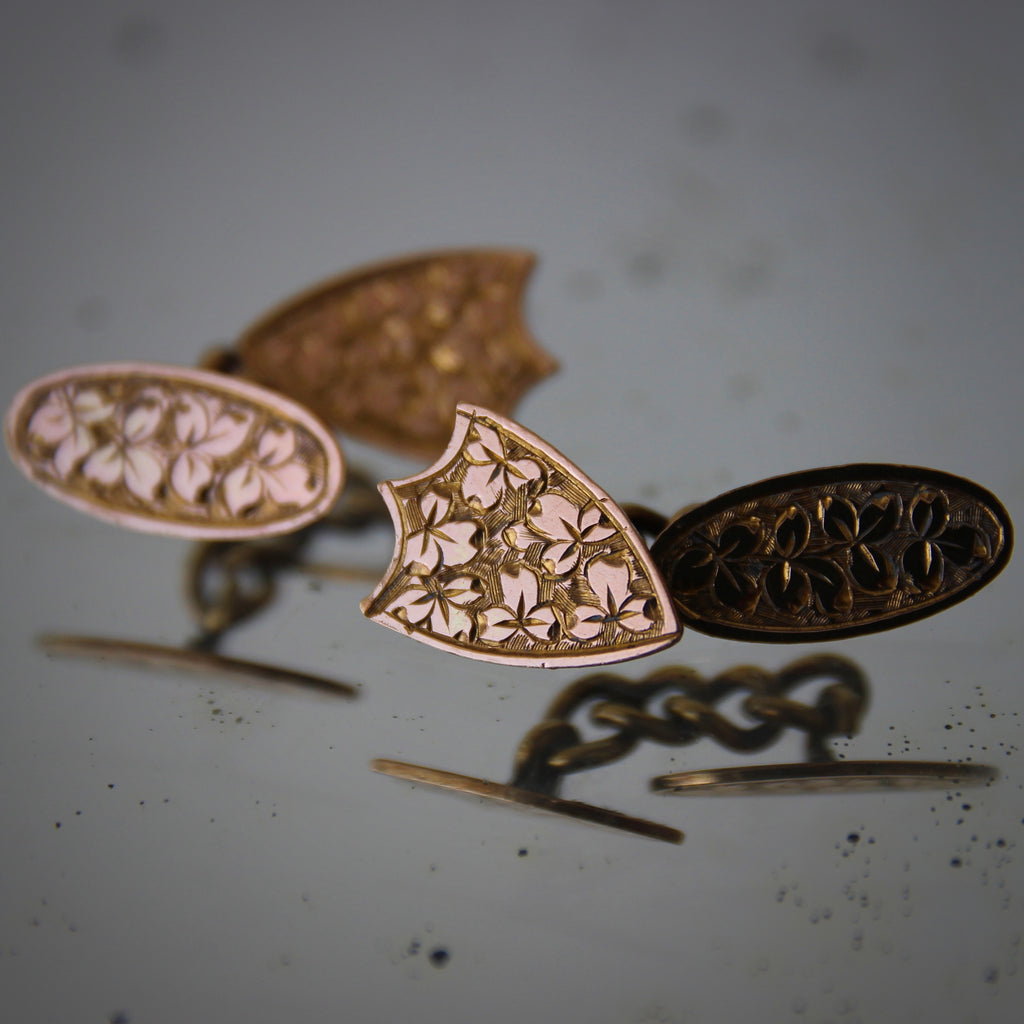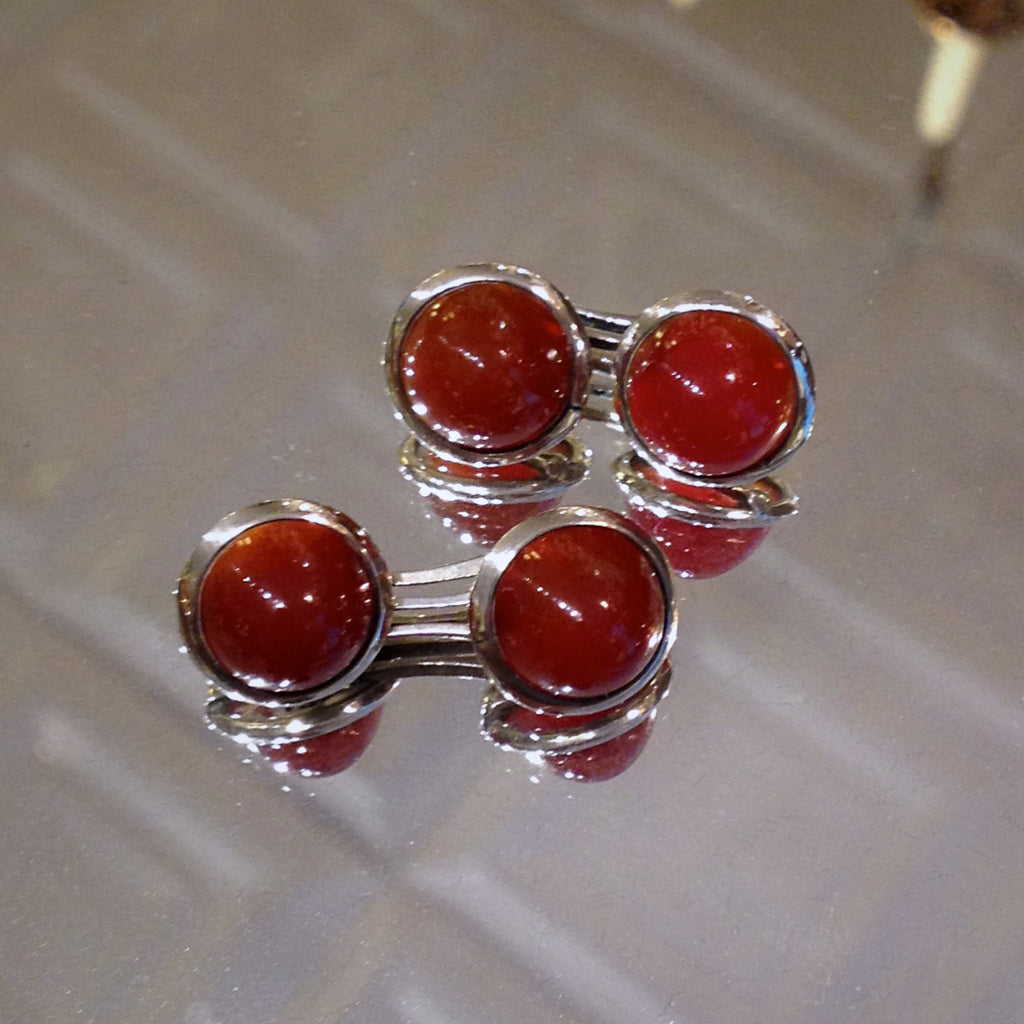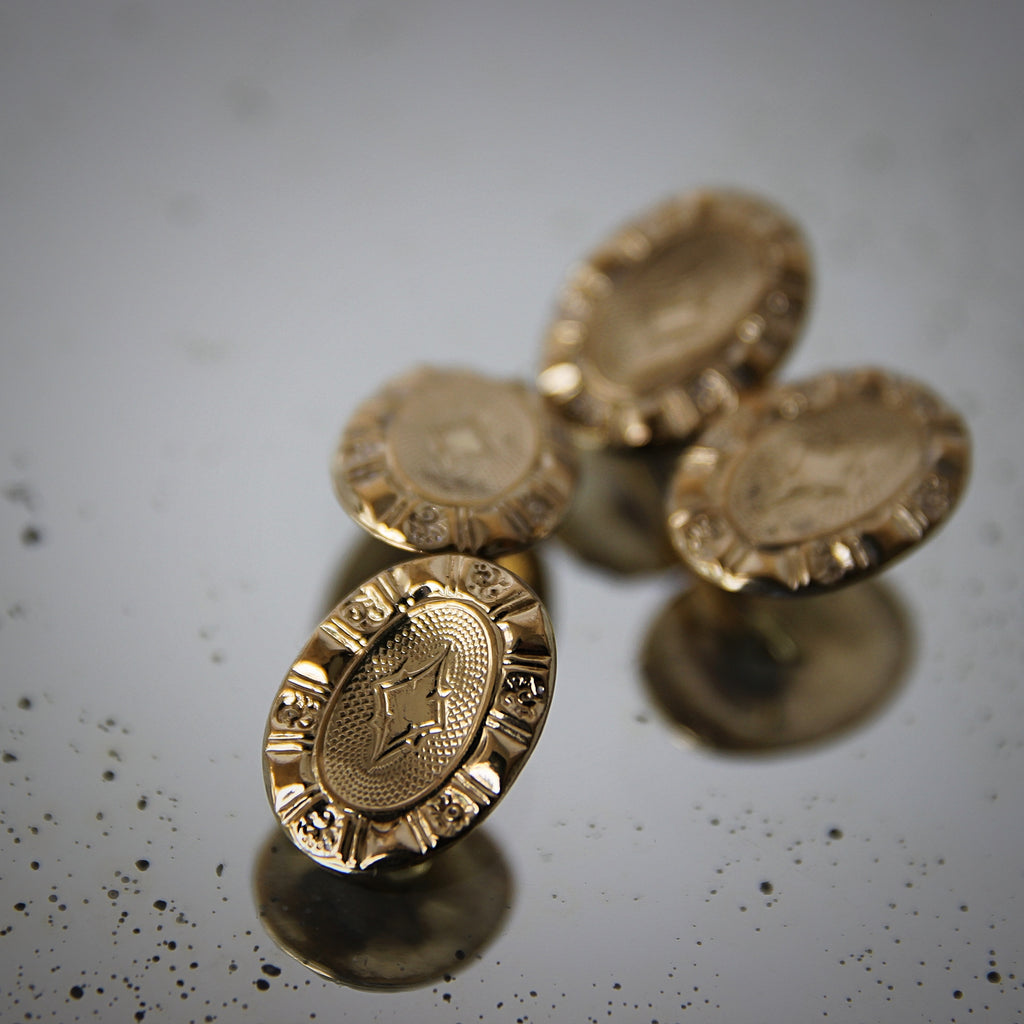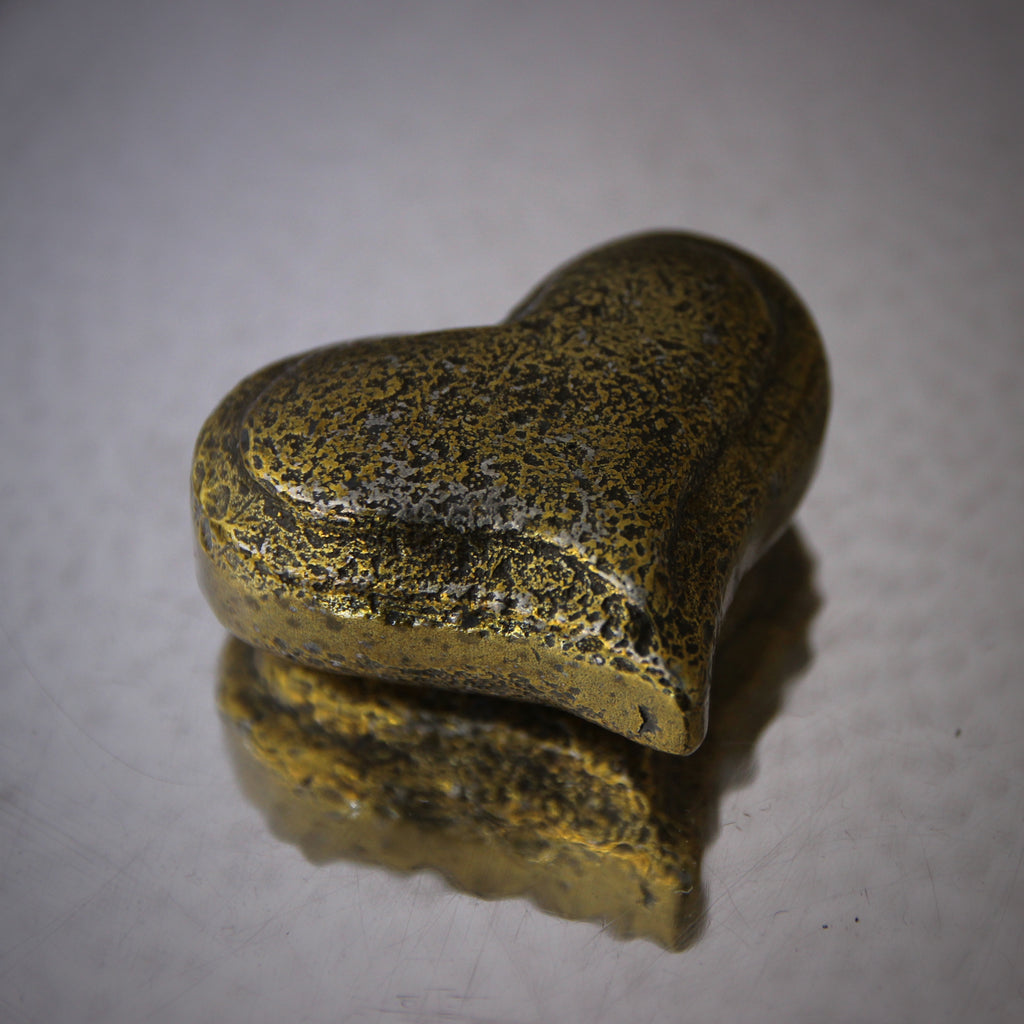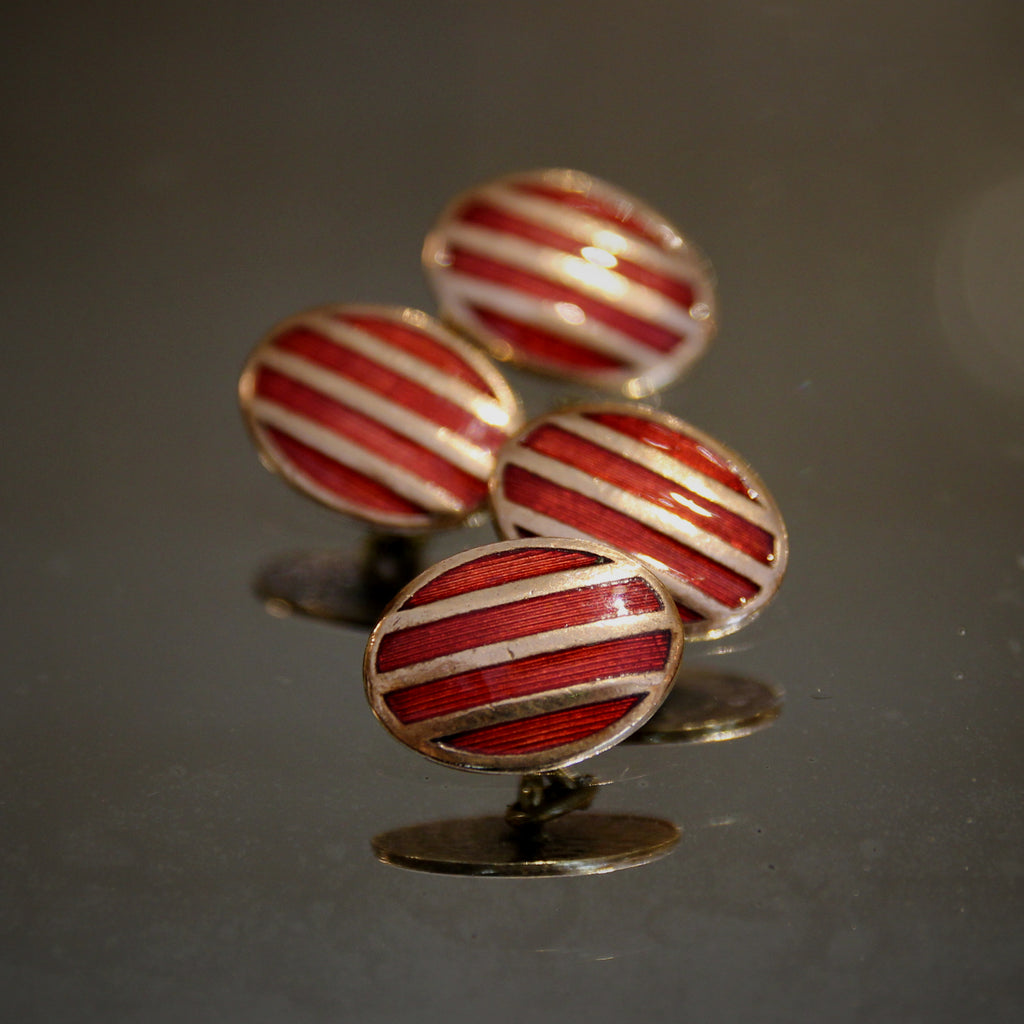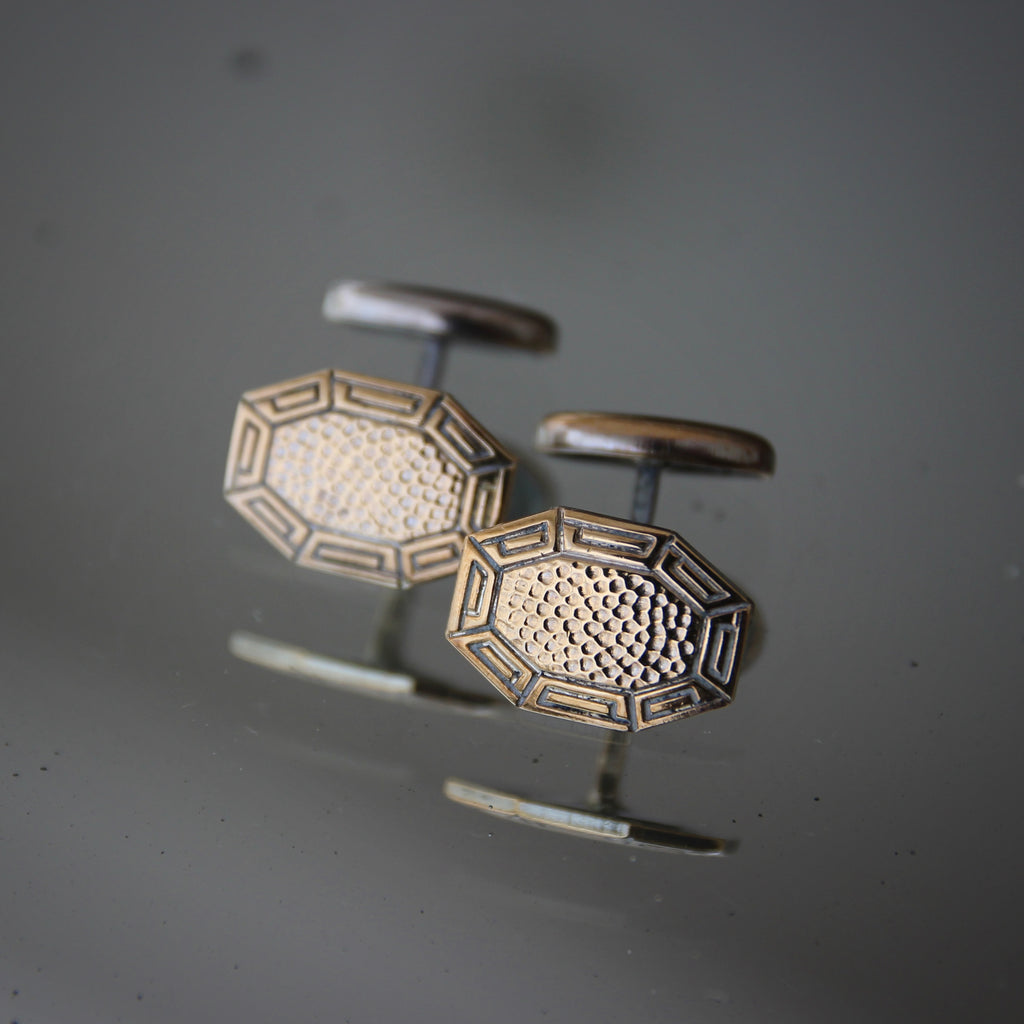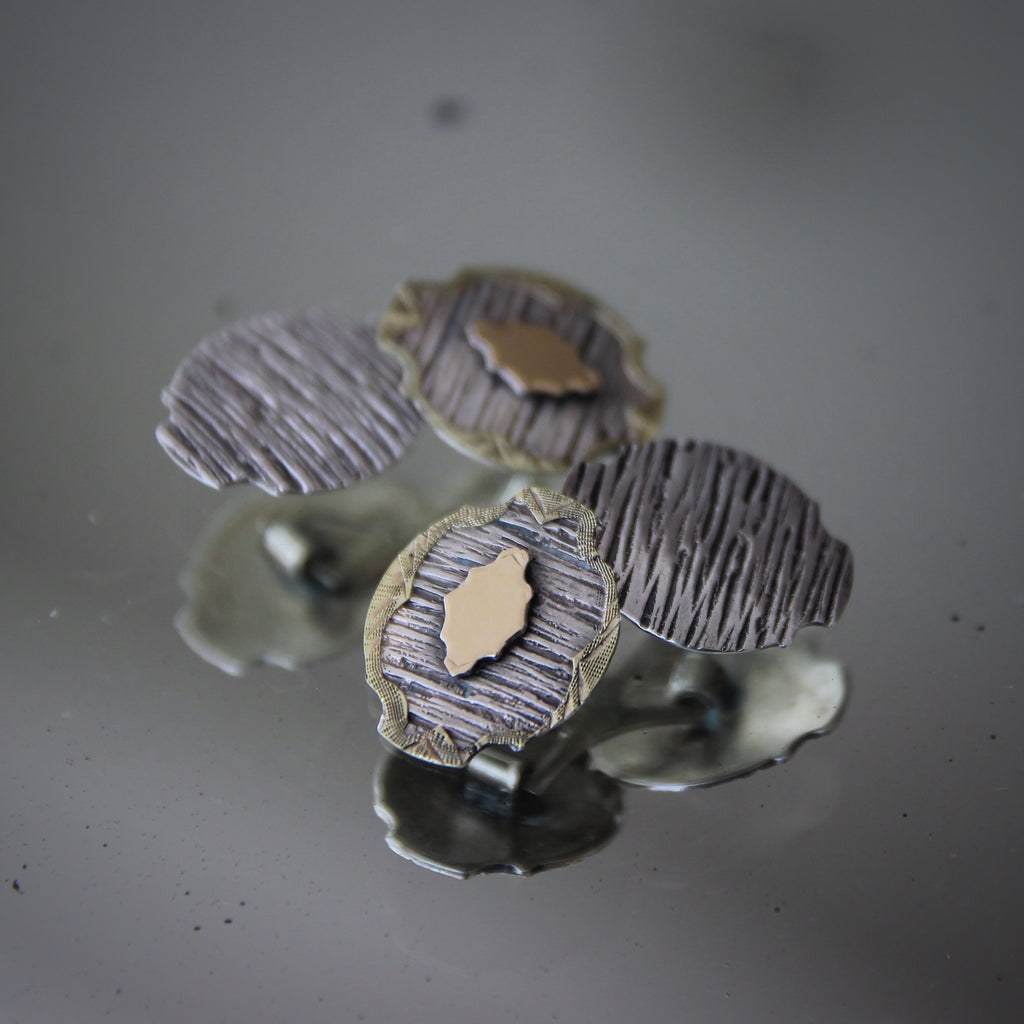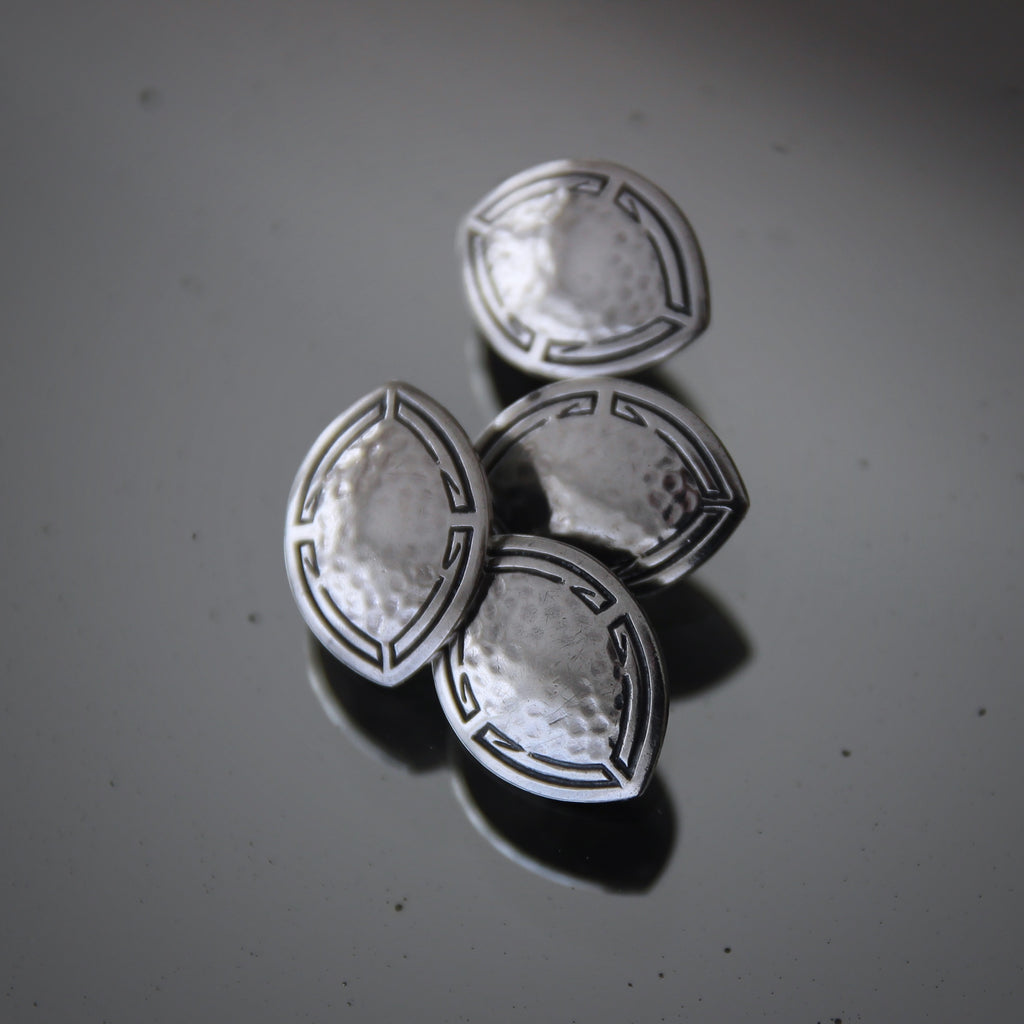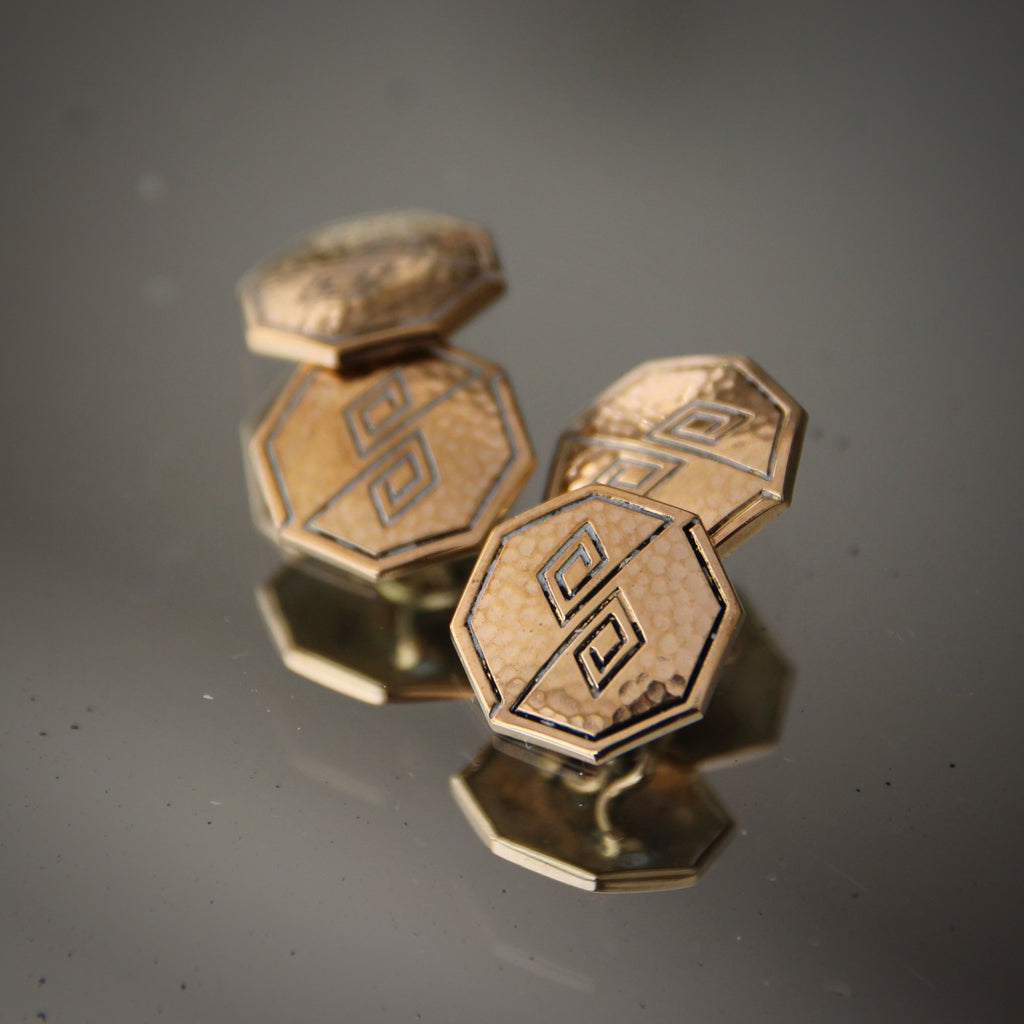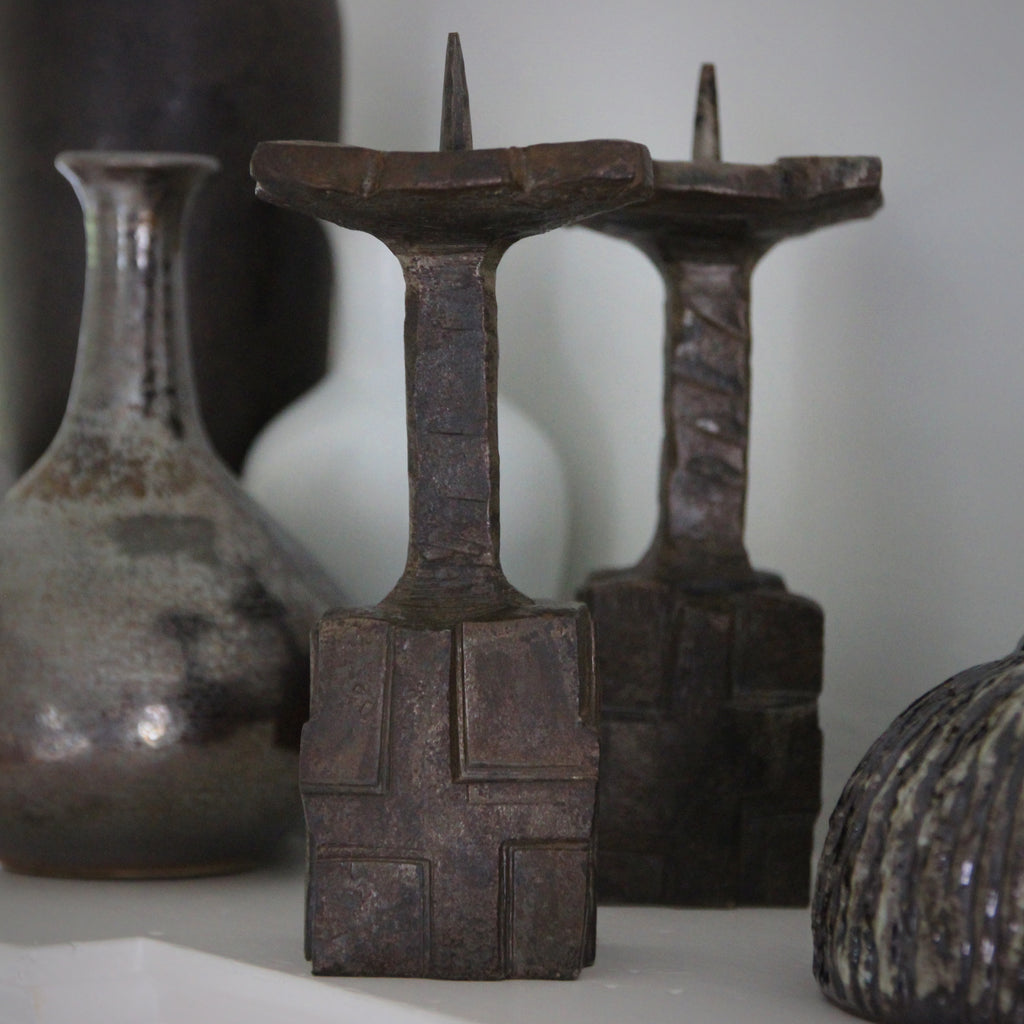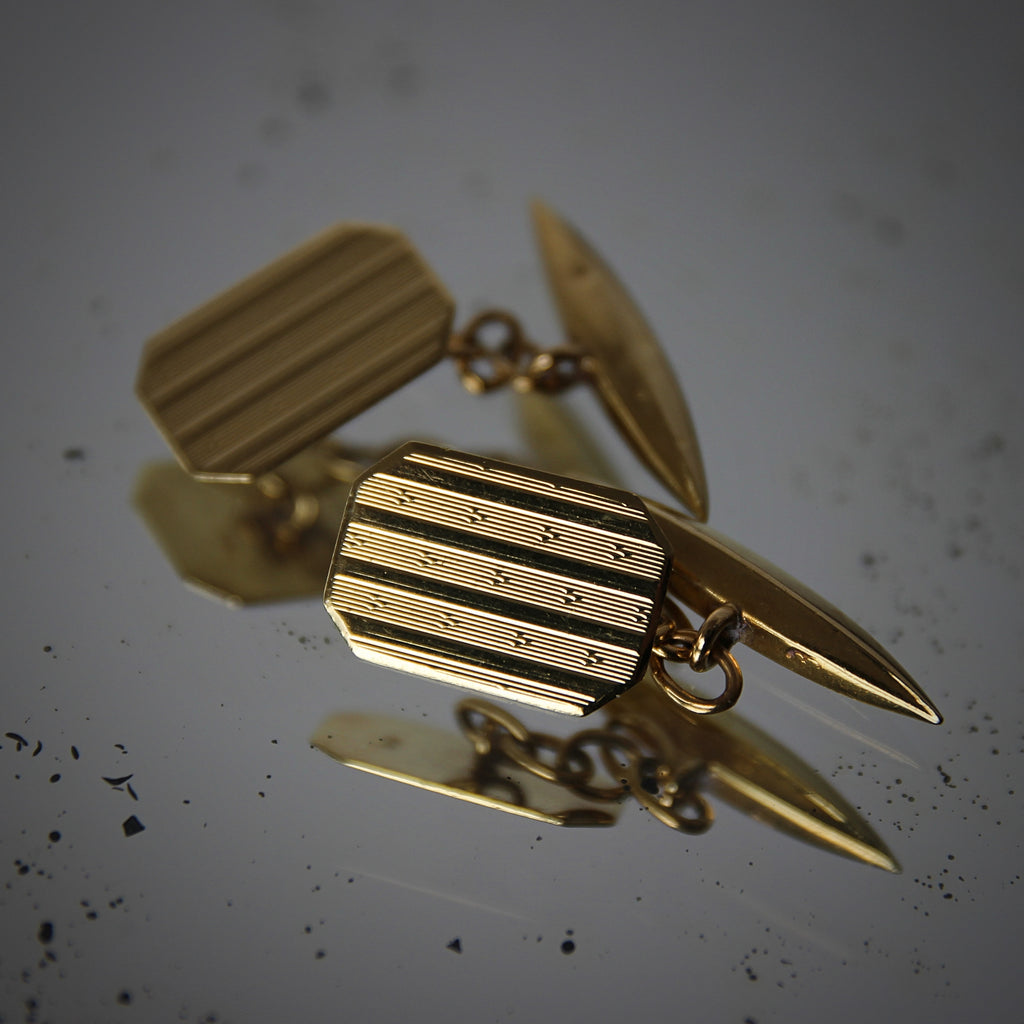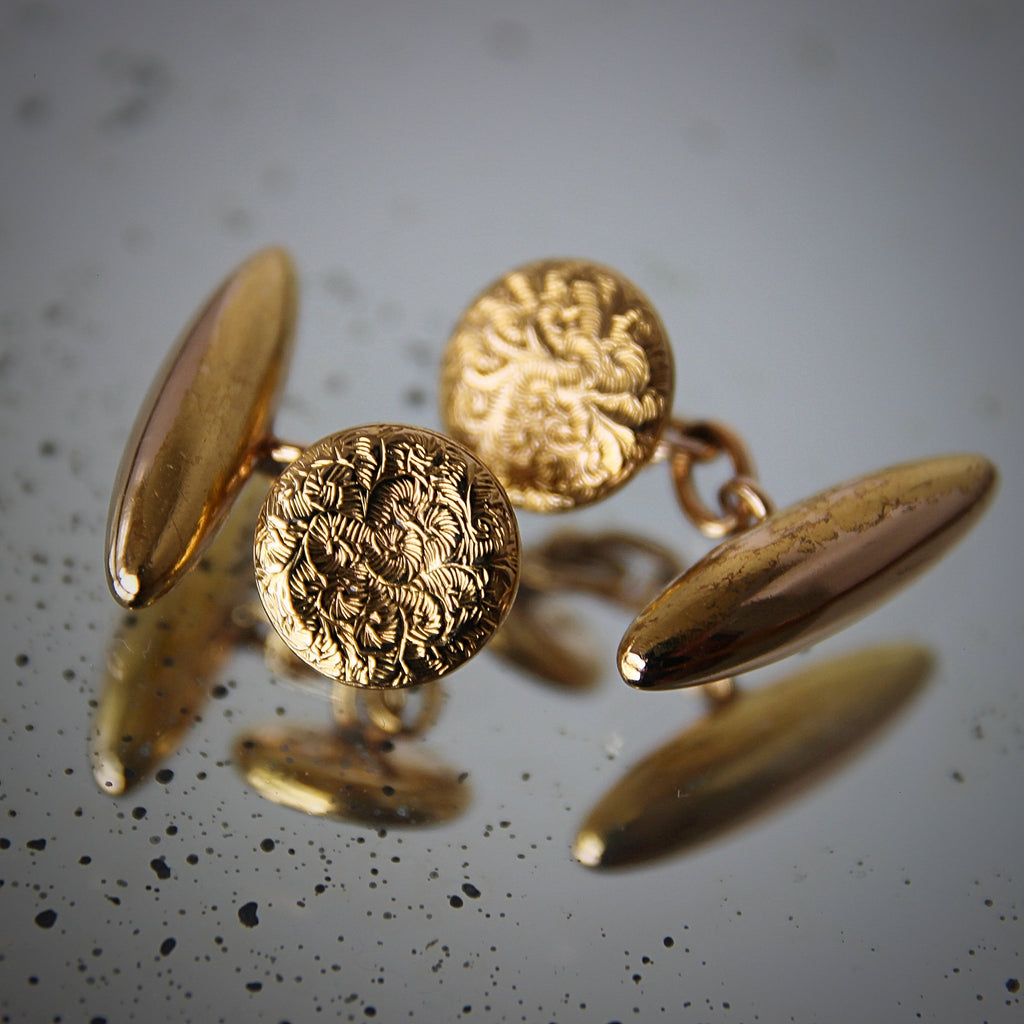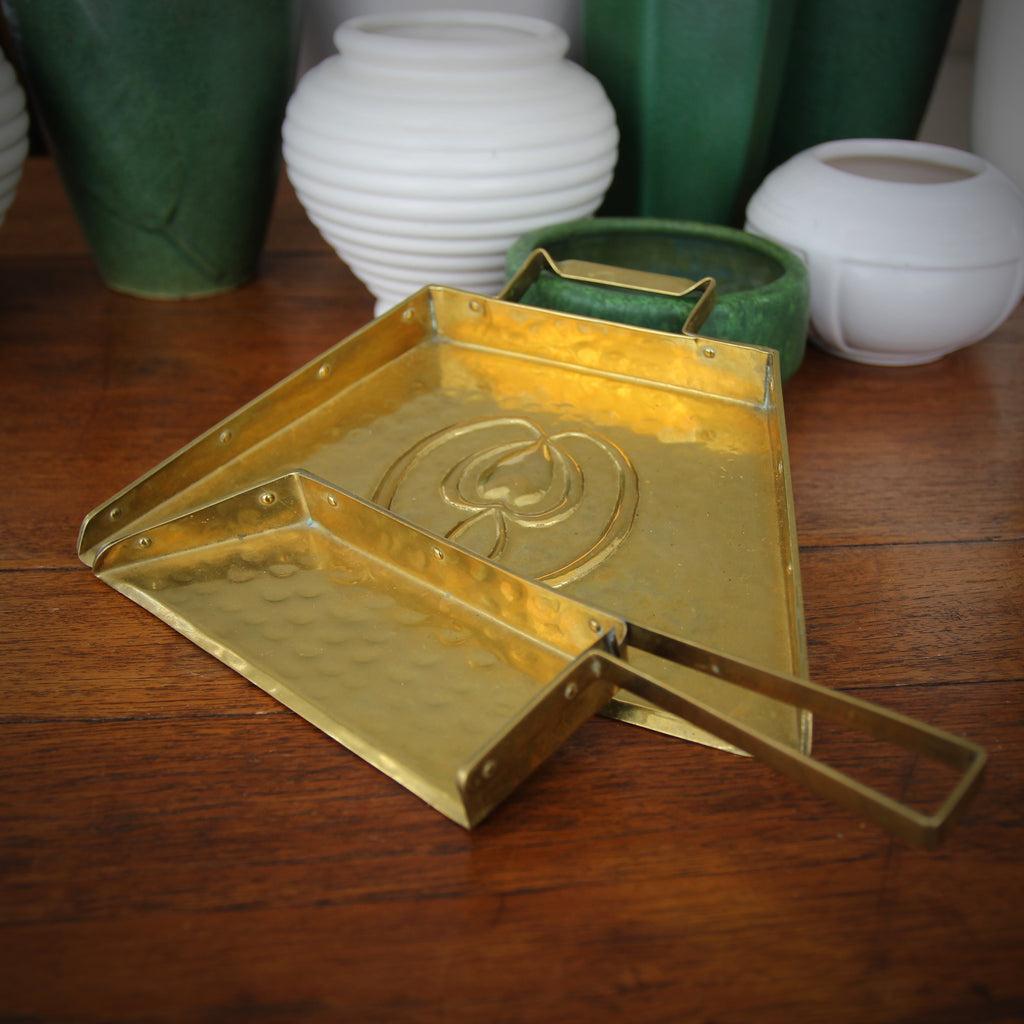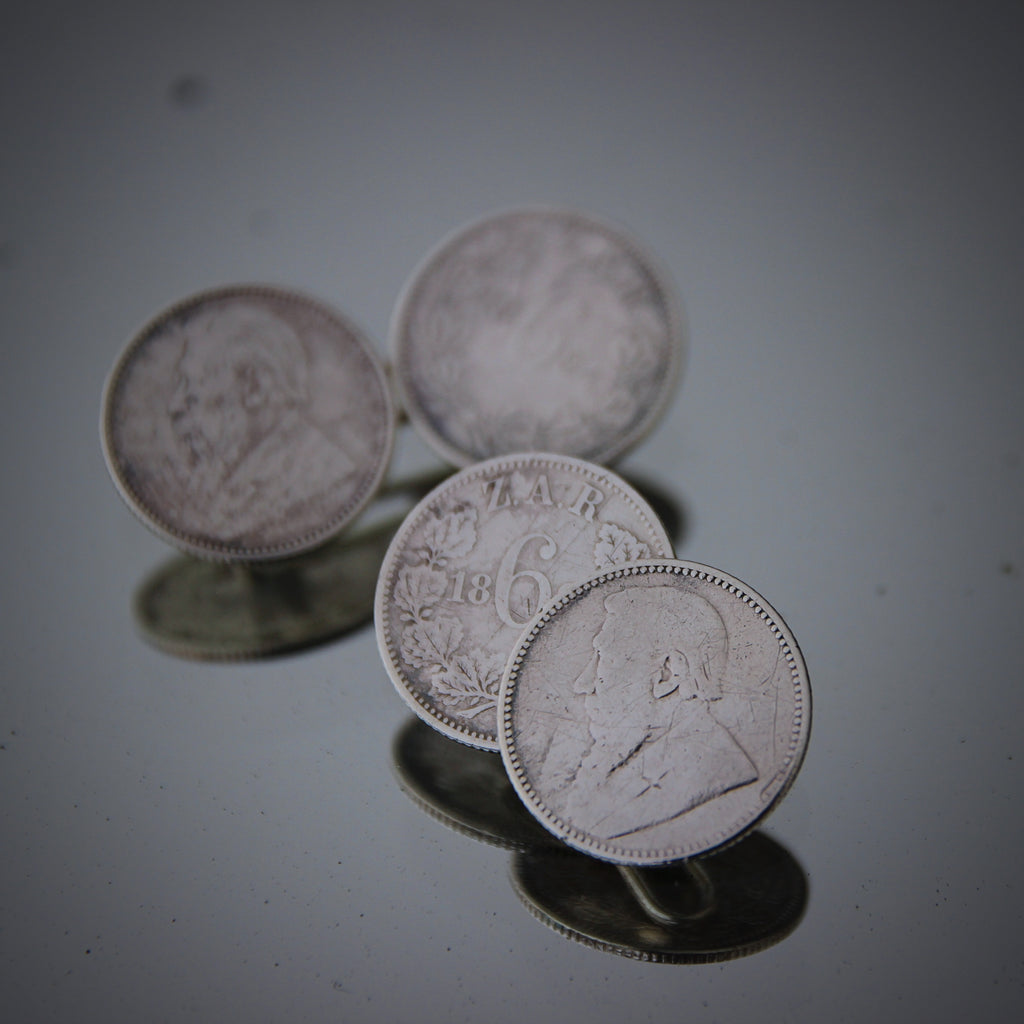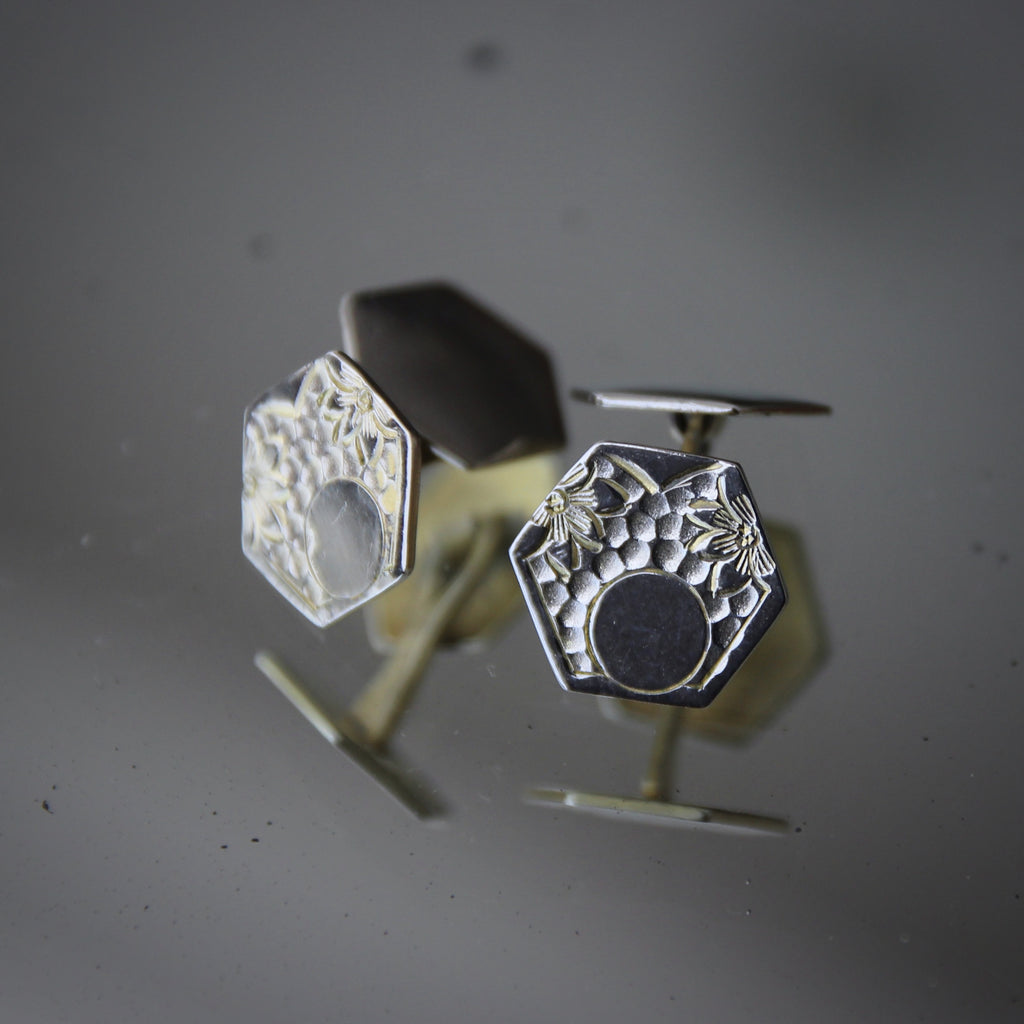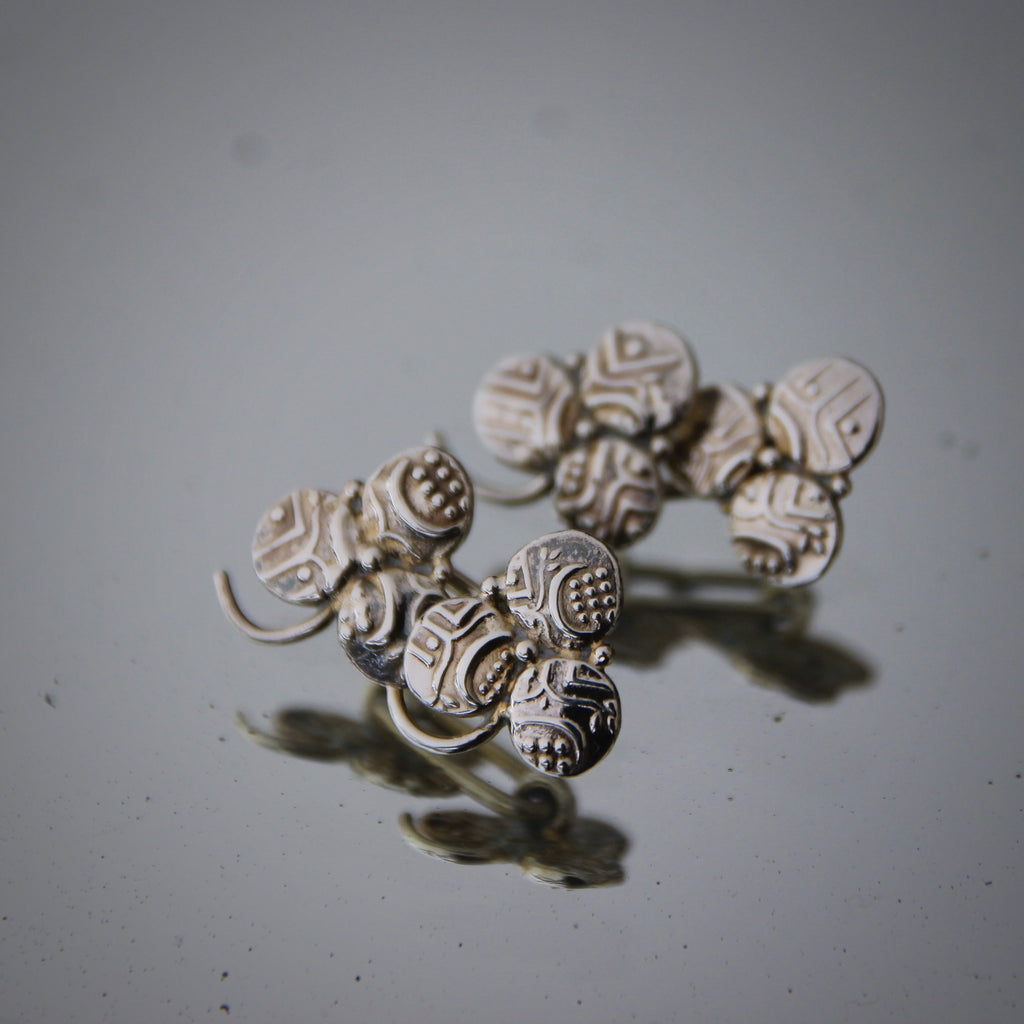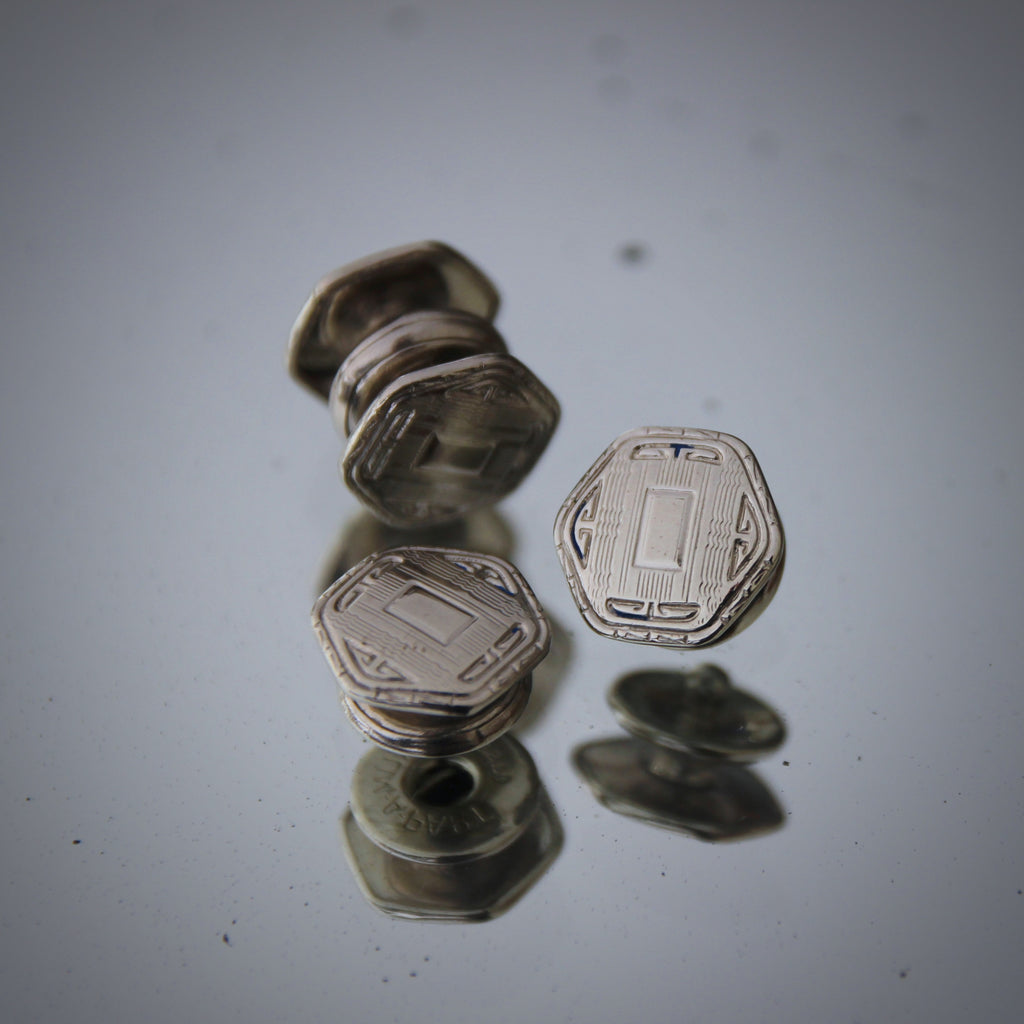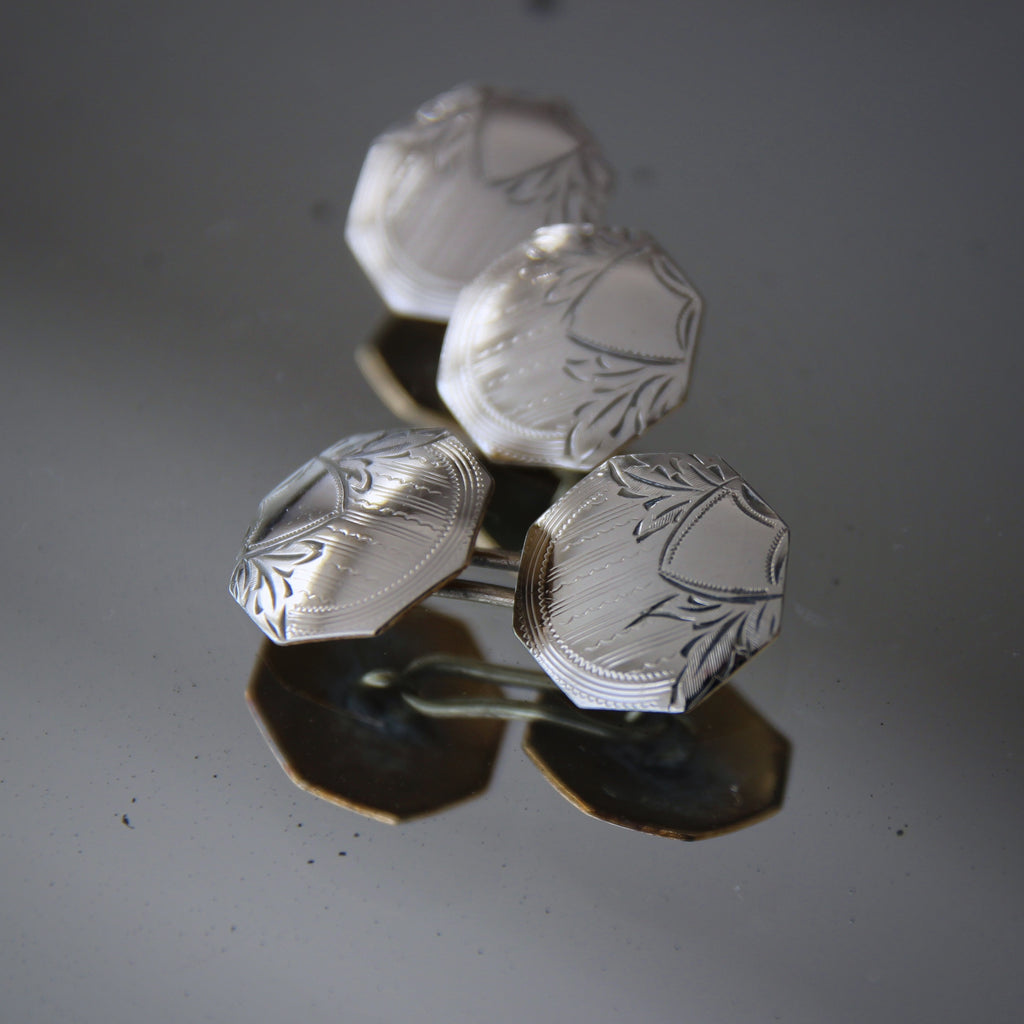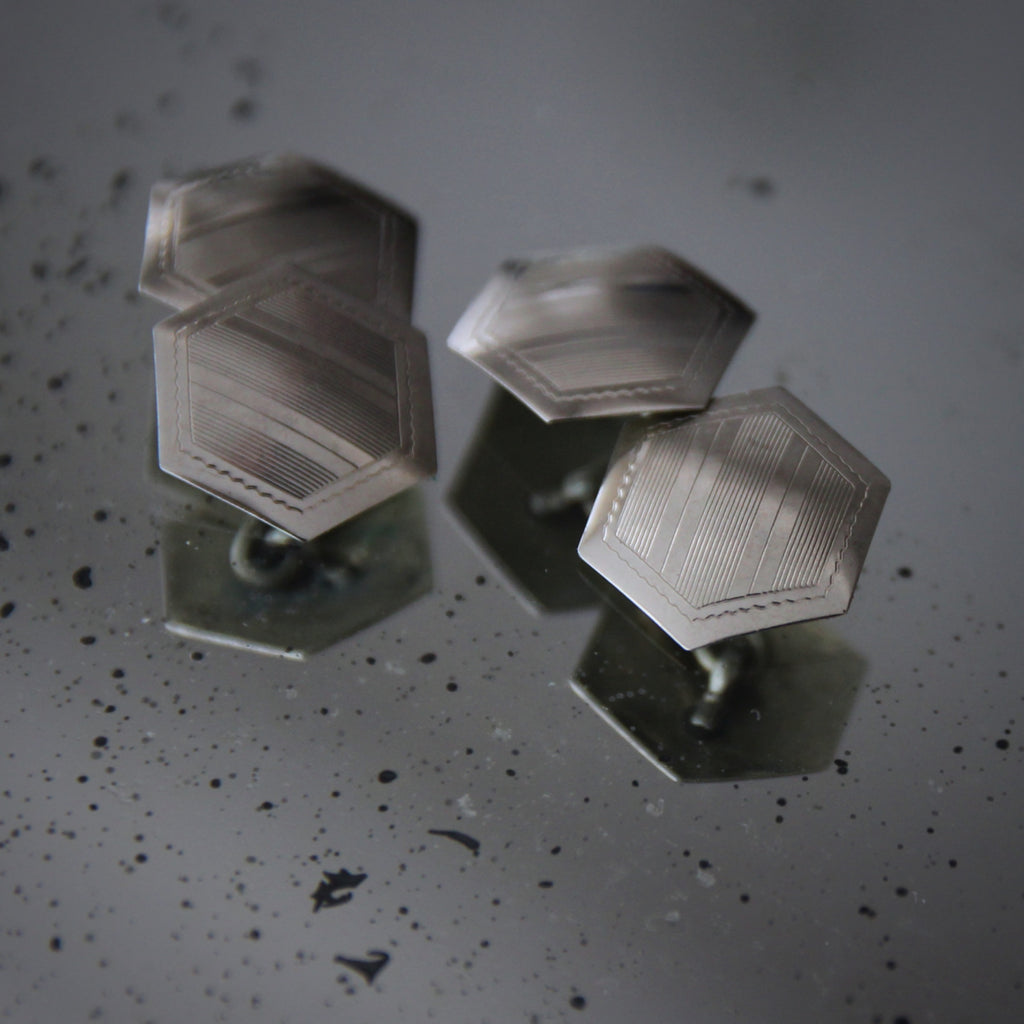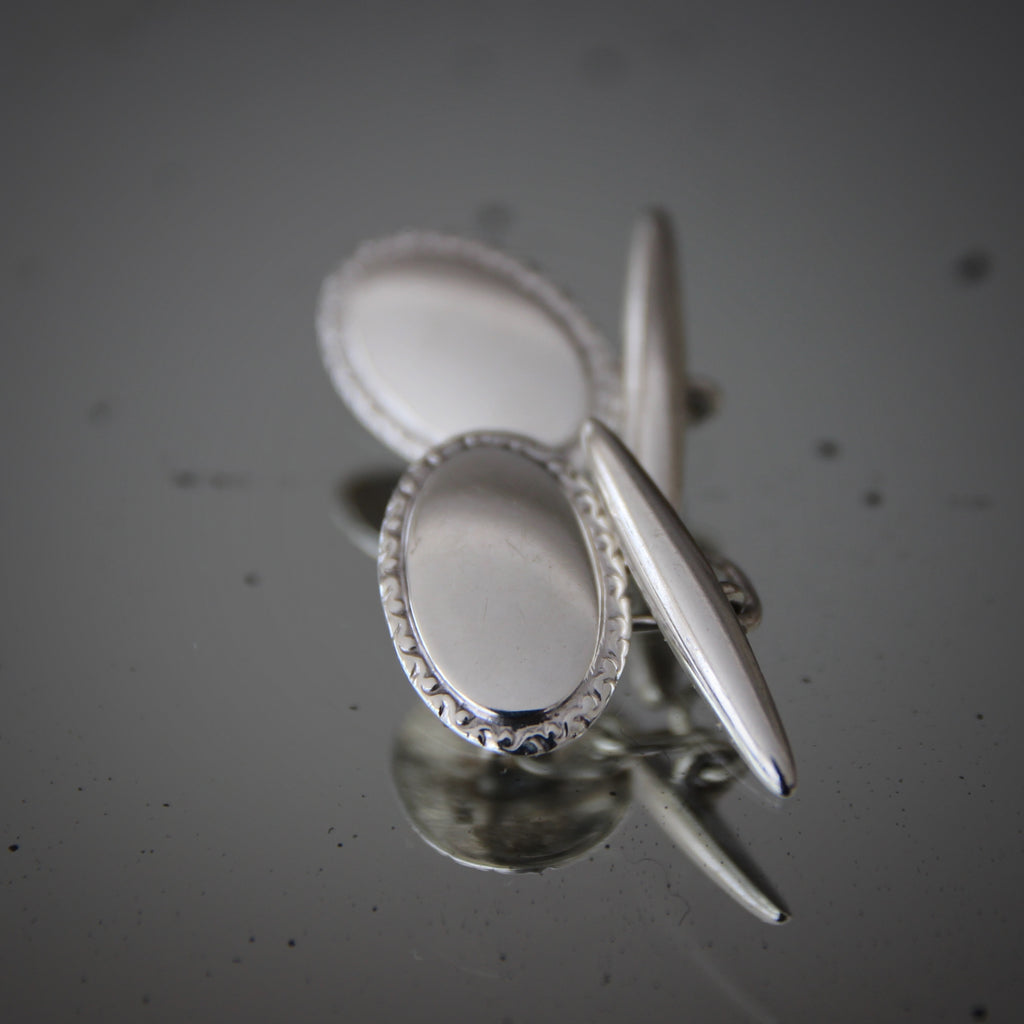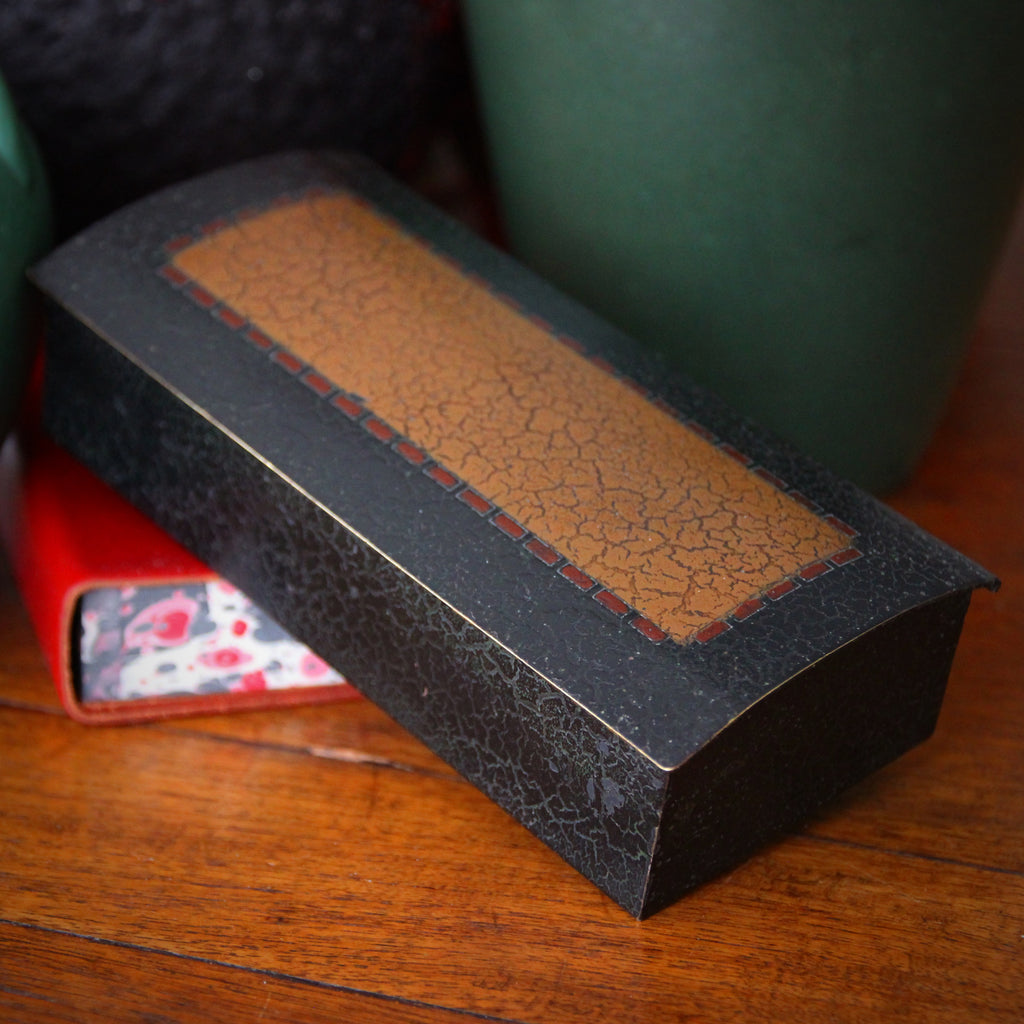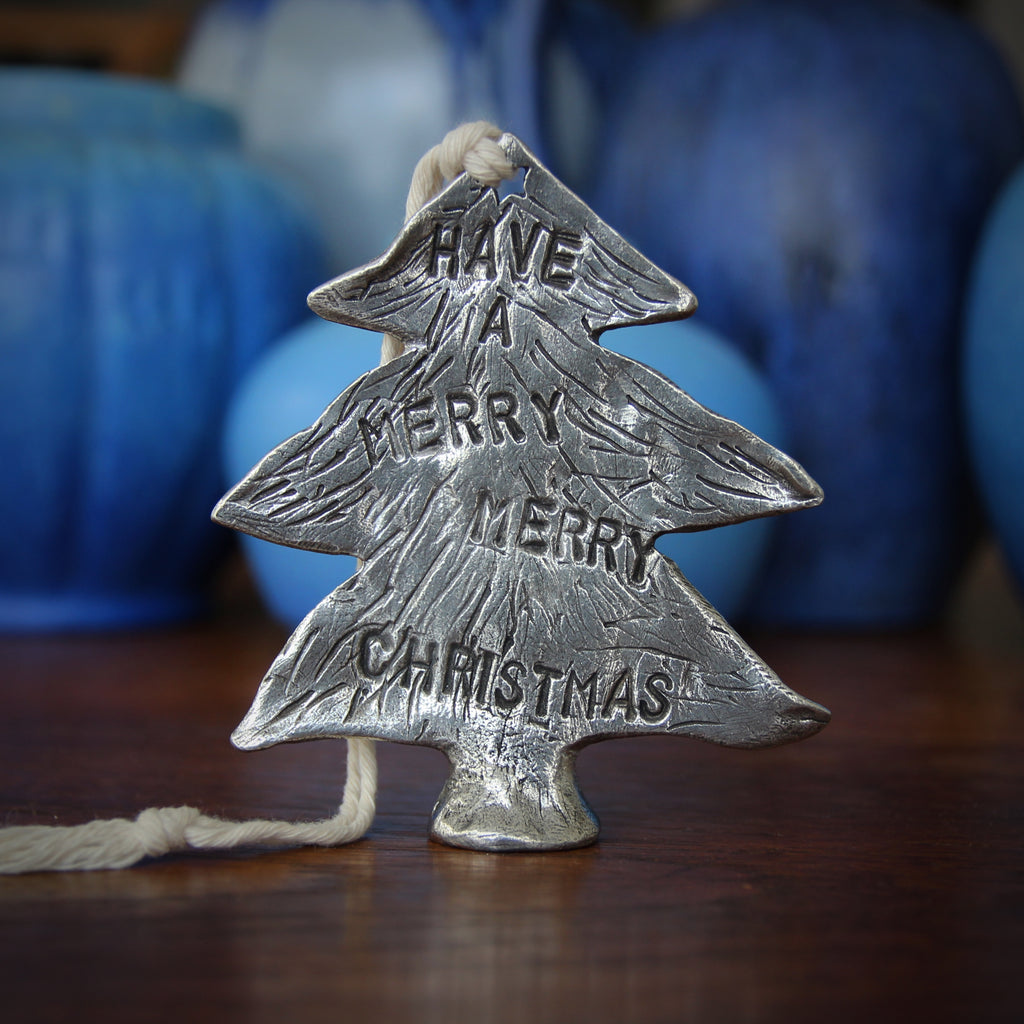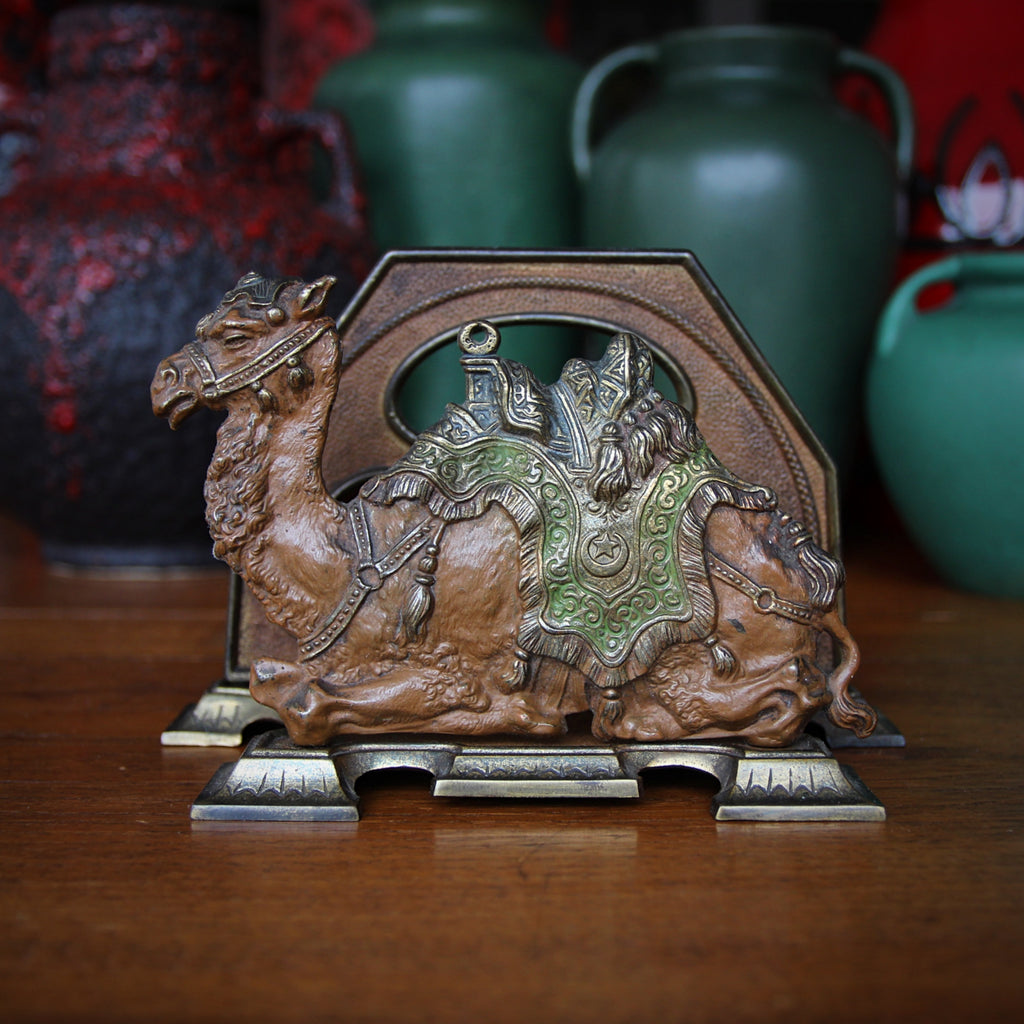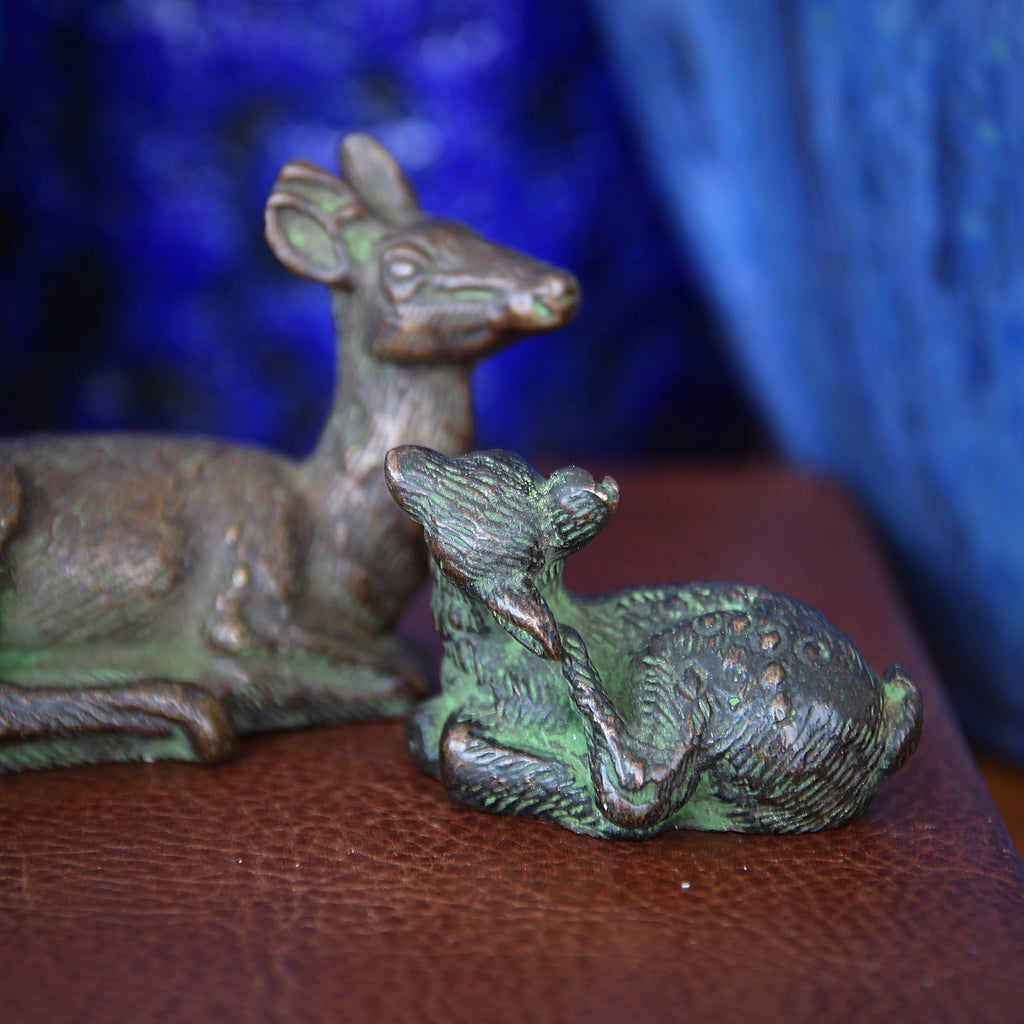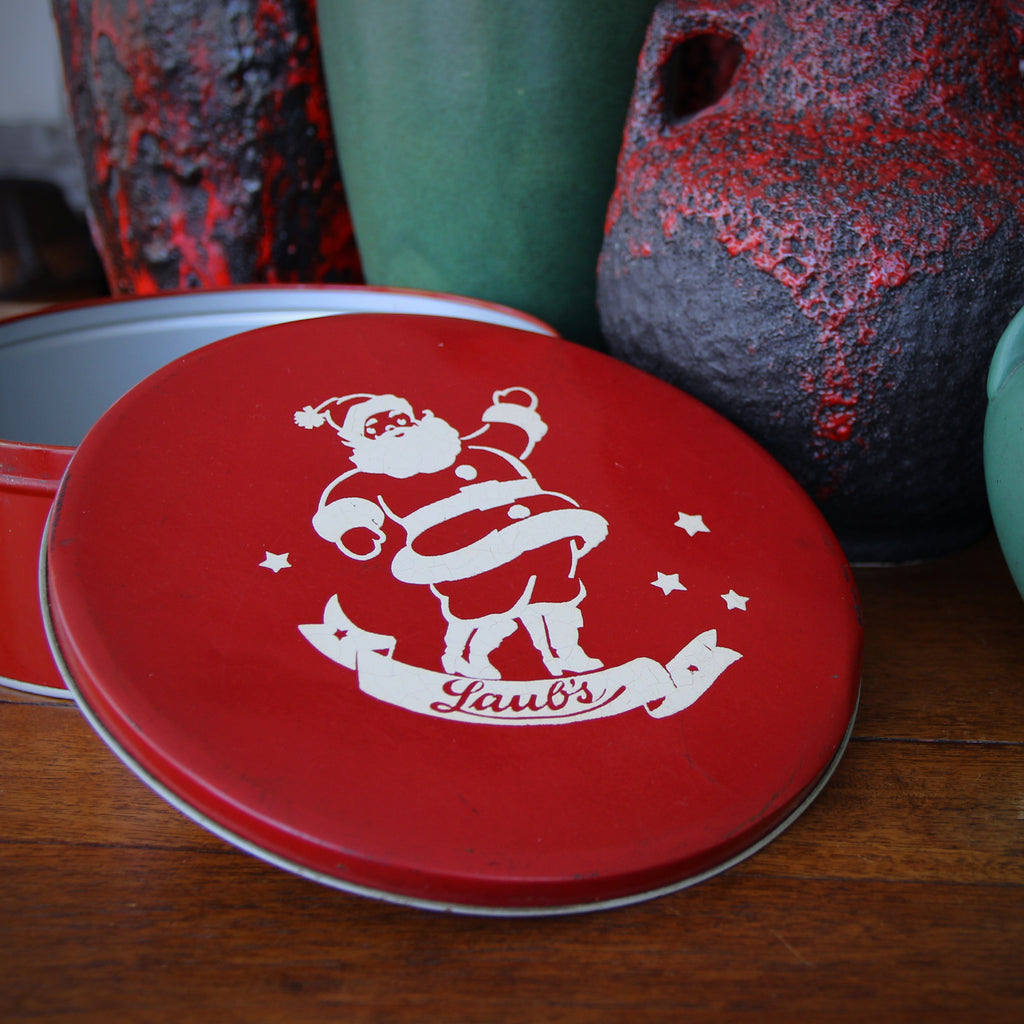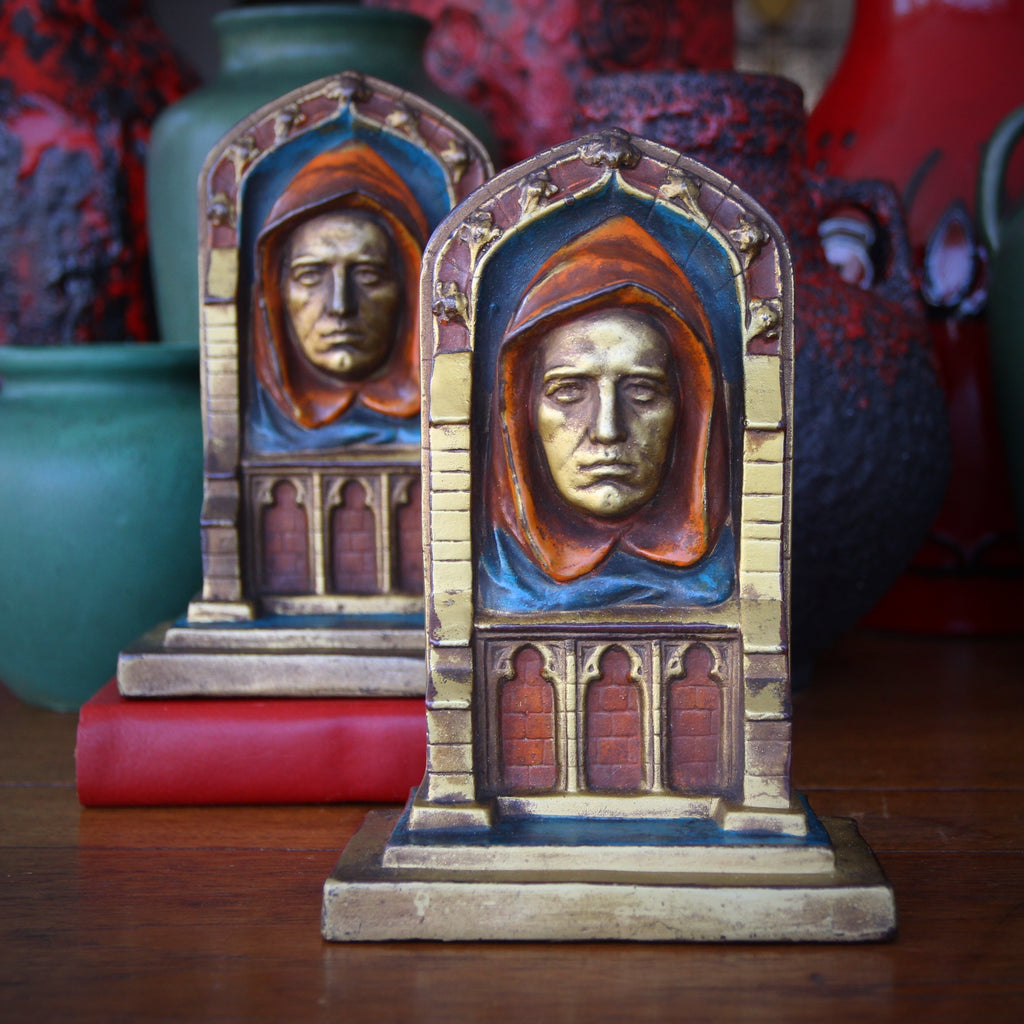JOURNAL — Metalwork RSS
For the rough-riding Dad: a heavy cast bronze bison, King of the Prairie. Classic symbol of the unspoiled West, bison have clawed their way back from the edge of extinction. This handsome and substantial beast will provide good company on Dad's desk—and bring back just a touch of Dad's wilder, earthier days.
Countdown to Father's Day - III
For the stylish Dad: a pair of English Art Deco cufflinks with a decidedly nautical attitude. Red and white striped enameling complete a seaworthy flag of bold, graphic color.
Countdown to Father's Day - II
For the Dad of Mettle: a three-dimensional puzzle of finely-engineered solid brass. Once it's securely reassembled, it makes a great paper weight and an even better conversation piece. Solid, well-assembled and just a little heavy. Just like Dad.
In Black & White - X
Let's end our "Symphony in Black & White" with this pair of English tin penguins—hand painted into their black and white tuxedoes. Created as a children's toys in the Twenties or Thirties—perhaps as members of a circus, zoo or ark menagerie—these tin animals would have usually experienced hard wear in the unforgiving hands of a youngster. Now, approaching their tenth decade, they are an elegant and whimsical reminder of a time gone by, when children's toys did not require batteries or wifi service.
In Black & White - IX
This week we've been exploring Handsome Gifts options in black and white. The English Art Deco cufflinks, shown above, were made in the 1930's. Indeed, they are enameled in black and white. But they also express other notable aspects of the British Art Deco movement including bold graphics, angular movement, and soft corners (which create a "sense of tension" as they wrestle to reform the angular original shape). The design and energy of this pair of cufflinks remind me of public transit signage from 1930s England: soft square shapes, high contrast coloration, bold graphics, simplicity of design and the use of hard-wearing enameling on metal. English Deco, to my eye, seems to feature the "softer side" of the movement—an opinion...
In Black & White - VI
The Jazz Age, that musical earthquake of the 1920's and 1930's, had a wide-ranging influence on the culture, image and attitude of the American nation. Indeed, Jazz affected the entire world. Jazz grew out of Black music, initially in the South. This origin triggered varied reactions to the musical style, from titillation, to fetishism, to wariness, to condemnation. Once White musicians began to pick-up or adapt (or copy) the genre, the music gained wider acceptance amongst White Americans. Jazz became very popular. Of course, this "jump" into the mainstream also changed the music dramatically.
In Black & White - IV
Stunning graphics are a legacy of the Art Deco movement—in America and worldwide. This pair of English Art Deco cufflinks boast handsome and energetic graphics on their enameled faces. Enameling involves artfully "laying" glass powder upon a surface (usually metal) and "baking" it to the point of melting the glass powder. The liquified glass spreads and fills the intended area—and eventually cools and solidifies back into a sheet of glass.
In Black & White - II
The Scottish Argyle pattern is a variety of "light plaid"—a series of solid colored squares or diamonds overlaid with diagonal lines. Sometimes the combination of elements creates an optical three-dimensional effect. The pattern has been worn in the Highlands of Scotland since the 1600's and is traditionally associated with Clan Campbell from Argyll, Western Scotland. Argyles became very fashionable after World War I. The Edinburgh knitwear company, Pringle of Scotland, popularized the pattern in England and America, using them on their fine hosiery and sweaters. The Duke of Windsor (who later became King Edward VIII) became associated with Argyles, increasing their popularity in the fashion of the Twenties and Thirties. He wore Argyle plaids while golfing, making the pattern...
Flowers for Mom - IV
For the mum with understated—and excellent—taste, here's something a little off the beaten path. A flower, indeed, sits at the center of this English Arts & Crafts hammered copper plate. Delicate peen work, precise piercing, and finely executed ribbing is surrounded by a gentle petaloid rim. Add to this the handsome nut brown patina which only develops on copper over decades. And, at center, is that precious little flower—shimmering ever so alluringly.
Flowers for Mom - II
Mother's Day is behind us, but it's always the right time to consider her next gift (or belated Mother's Day present). Shown here, a sweet border of flowers surrounds a little 2.5" x 3.5" pewter frame. It can sit either horizontally or vertically and would be a welcomed offering to any mother or grandmother.
Countdown to Mother's Day - X
We've been counting-down the days to Mother's Day with an assortment of thoughtful gifts for the important women in our lives. Be sure to request gift boxing, if you'd like it. We can also ship directly to your mother, possibly saving a few days in-transit. (Please be sure to specify your desired greeting for an enclosure card to accompany your gift.) A beautiful and functional letterknife is always a welcomed gift. And this one, shown above, is extra special. The handle is finely cast pewter, selectively gold-plated and enameled with a light olive green. To complete the design, hand-set Swarovski crystals are mounted into the handle. The nicely-shaped brass blade provides the working end of the implement. Click on the...
Countdown to Mother's Day - IX
Many mothers who travel for work carry photos of their children with them. Not just on their mobile phones, but in travel frames which they can display on their hotel room nightstands. These picture frames need to be big enough to be appreciated but portable and durable enough to withstand the rigors of travel. Even my own mother, who rarely travels (except to come visit me), will pack and bring-along a travel frame with photos of me and my brother. The travel photo frame shown above is from the 1940's. It closes like a portable compact, opening to reveal two round photographs. One of the nicest features is the handsomely engraved herringbone pattern which surrounds each photograph. Once closed, it is...
Countdown to Mother's Day - VIII
While on the hunt for men's jewelry, mostly cufflinks, I will often come-across women's jewelry which catches my eye—most often jewelry which might be called "handsome." (By the way, "handsome" was a term used to describe attractively stately women in the 19th Century. It did not carry a male-only connotation.) These pieces usually exhibit interesting metalwork or attractive semi-precious stones and would rarely be called "girly" or "fussy." Strong, bold and organic pieces are most likely to appeal to me. One such brooch is shown above: an English polished oval agate with randomly organic striations of blue, white and honey-caramel. The stone is set in a "twisted" sterling silver mounting, hallmarked London 1987. While the setting is not very old, the stone itself has...
Countdown to Mother's Day - VII
We're counting-down the days to Mother's Day with an assortment of thoughtful gifts for the important women in our lives. Order early and be sure to request gift boxing, if you'd like it. We can also ship directly to your mother, possibly saving a few days in-transit It's time to let our mothers kick-back, relax and demand a little service for themselves! This Edwardian English tea bell may give her the assist she needs. Tea bells were a fixture in British middle class households—back in the days when "middle class" meant a houseful of servants. Kept on a side table or tea tray, the bell would be used to summon the help quickly and discreetly. The specimen shown here, made of bronze "bell...
Countdown to Mother's Day - V
Since I opened my shop on Bleecker Street in 1995, I have always offered a curated blend of antique and contemporary items—"Handsome Gifts" and home furnishings. I always attempted to blend the items properly; to carry well-crafted offerings, old or new, which sat-well with each other. And I never wished to confuse the customer with a contemporary item deceitfully designed to pass as an antique. On the other hand, I occasionally found living artisans who were reviving age-old (perhaps "extinct") tradecraft—items made just as well (or better) today as they were made the first time around. The frame above is such an example. It was made by an artisan named Edgar Berebi in the East Coast jewelry manufacturing hub of Providence, Rhode Island. After...
Countdown to Mother's Day - IV
Everyone can use a little help organizing, especially busy moms. So much the better to help her do it with style.
This Edwardian English letter rack is made of brass mounted upon an oak base with handsomely chamfered edges. A swirling bale handle emerges energetically from behind brass botanical panels. Such a letter holder can be used on a working mom's desk or in the household: a place to sort mail, keep lists, save recipes, or store envelopes until they are ready to be mailed. The handsome design elevates these otherwise mundane tasks—and will add a bit of visual interest to her office, den or entry hall table.
Countdown to Mother's Day - III
Once upon a time (and not so long ago), sewing was a basic skill familiar to most households, especially (but not only) amongst women. While at-home dressmaking and tailoring was coming to a quick close after World War I (when "ready-to-wear" in department stores became quick, easy and affordable), most mending and altering of garments still could take place in the hands of a talented amateur. Every house had a drawer, box, or cake tin which held the needles, pins, seam-rippers and thread required to replace a button, mend a seam, or darn a sock. It was during this period, just before World War I, that this pincushion would have been in-use. The pincushion shown here is Edwardian English, made around 1905....
Countdown to Mother's Day - II
After Prince Albert died in 1861, Queen Victoria still had four decades left on the British throne. The Queen remained in-mourning throughout that long period, modifying her dress and adornment to suit her situation as a grieving widow. The Queen was also an important role model and taste-maker for the nation; her choices inevitably affected the mood, dress and comportment of her people. While not every piece of jewelry made during that time period could be called "mourning jewelry," simple, handsome and serious design remained popular through the end of the Nineteenth Century (and the Queen's lifetime). Frivolity was out. Sober was in. Luckily for me, I am fond of such heavy and handsome jewelry. And many of my female...
Countdown to Mother's Day - I
We're counting-down the days to Mother's Day with an assortment of thoughtful gifts for the important women in our lives. Order early and be sure to request gift boxing, if you'd like it. We can also ship directly to your mother, possibly saving a few days in-transit. (Please be sure to specify your desired greeting for an enclosure card to accompany your gift.) Picture frames are always a great gift for mum. No mother can have too many pictures of their children—or, better yet, their grandchildren. This Victorian English brass photo frame, made around 1890, has what are called "Oxford Corners"—the criss-crossing joinery usually found on wooden frames. Note the thoughtful chamfering along the horizontal and vertical members. This frame...
Light My Fire
Back in "the old days"—a time period which includes the Arts & Crafts period—maintaining and managing fire(s) was an important task. Fires might be used for lighting, cooking, heating, manufacturing and other industrial tasks. And sometimes one needed to "transfer" (or spread) a fire from one place to another. In a wood-burning fireplace or stove, a "Cape Cod" style "fire starter," like the one shown above, was a useful tool to have in the household. The "pitcher"—this one is hand-hammered steel in the Arts & Crafts style—would hold a supply of lamp oil. A wrought-iron "wand," with a soapstone "egg" at one end, would soak in the lamp oil, thus absorbing a good amount of the fuel. This wand would...
God Bless a Terrier!"
The Scottish Terrier—also called the Aberdeen Terrier or, more popularly, "The Scottie"—is one of the five recognized breeds of terriers from Scotland (a list which includes the Cairn, Skye, Dandie Dinmont and West Highland Terriers). The breed was developed as "ratters"—animals which would catch and kill small vermin indoors or on a farm. The breed is known for being bright, alert, quick, rugged, independent, feisty and territorial. They become very loyal to their families, often singling-out one or two individuals for an extra-close bond. These traits make them pleasant house pets and good watch dogs. But their stubbornness—and wariness of strangers—can make them unpredictable around people they don't know. It is advised to watch them carefully around the erratic movements of...
"Best In The World"
After San Francisco's devastating earthquake of 1906—and the fires which followed, which were worse—the city was in need of a jump-start. The "San Francisco Panama-Pacific International Exhibition" of 1915 was the kind of celebration and promotion that brought the world to The City by the Bay. In truth, this world's fair was intended to celebrate the completion of the Panama Canal the previous year. However, civic and business leaders also knew that such an event could be a wonderful showcase for San Francisco, encouraging industry and tourism for the city. A square mile of land—inconceivable today—was used to build-out the fair. A telephone line was run from New York City which allowed New Yorkers to hear the Pacific live. The...
Three Months 'til LEO!
Three months from today—on 23 July—the Sun enters the sign of LEO where it will stay for the following month. Anyone born during that month-long period will have the honor and distinction of being able to claim LEO as their sunsign.
The little bronze sculpture, shown above, celebrates LEO every day. Turn him over and you'll see the word "Courage" impressed into his tummy. It's a gentle (and perfect) reminder for your favorite Leonine: Stay Strong!
Tiffany Goes Modern
When I think of Tiffany silver goods, I reflexively picture the heavy and elegant works from the late Nineteenth Century: pitchers engraved with Aesthetic Movement graphics, crawling with the insects, arachnids and amphibians of the period's Darwinian intrigue. But Tiffany, the company, has adapted with the times and, for the most part, succeeded. They are still in business to this day. In the Post-War Modernist period, Tiffany crafted these little cordials of sterling silver—in keeping with the streamlined aesthetic of the Fifties and Sixties. The little "beakers" might be used to serve a cordial or after-dinner drink, perhaps a one-ounce "pony shot" as such a small tipple is known. These cups were sent to me by a customer in New...
Happy Easter
From your friends at LEO Design:
Wishing all a Happy Easter
and a Joyful Spring!
From Times Past
In the days before electricity, oil lamps and candles provided light for the household. A candle box—a wall-mounted receptacle to hold a supply of fresh candles—was as ordinary back then as a light switch is today. Plain candle boxes were often hung in the kitchen where their utilitarian purpose suited the functioning of the room. Beside providing light, candles were also handy for "transferring" fire from one spot to another—say, lighting a gas burner with the flame from a lamp. A more decorative candle box, like the English Arts & Crafts specimen shown above, might have hung on the wall of a sitting room or dining room—where the decorative repoussé metalwork would add a touch of panache. Candles stored in the...
The Chow-Chow
The Chinese Chow-Chow is amongst the oldest dog breeds in the world, one of the so-called "basal breeds" (that is, dog breeds which were developed for specific tasks centuries ago, before the modern era of canine husbandry). Some historians estimate the breed may be 2000 to 3000 years old, beginning in the Arctic, migrating through Mongolia, and eventually settling in China. Their sturdy bodies, ultra-thick fur, and fierce loyalty made them highly desirable as guard dogs or to work in difficult winter climates. The fact that their fur forms a ruff-like "collar" around their necks—which gives them the appearance of a lion—made them even more desirable as palace guard dogs. In the 13th Century, Marco Polo wrote his observations of seeing...
Happy Birthday, Jackie
My stepmother, Jackie, played a significant role in my life. And today would have been her 77th birthday. It just so happened that she, my father and my kid brother, Ian, arrived for a long-planned summer visit with me, in New York, the very day I received the keys to my first shop space on Bleecker Street. It was 1995. They spent their Manhattan holiday week helping me demo and clean the old shop. Six years later, Jackie stayed with us for a month after 9-11. She was volunteering as a social worker with the Red Cross, helping families in the aftermath of the attack. In 2005, I spent the last three weeks of her life with her, flying to Fez, Morocco,...
Spring Green
There's a beautiful delicacy to the early green of Spring: tender, gentle and hopeful. With winter moving-on, my garden is beginning to re-leaf in this wonderful hue. It is truly a color of promise.
These English Art Nouveau cufflinks, made in the early Twentieth Century, feature "jadeite" (green artglass) "turtleback" cabochons. Their softly-pebbled texture and central "dorsal hump" are also reminiscent of shagreen—the cured skin of sharks and rays, so fashionable in the period. Their soft green color are the perfect accent for Spring or even the Summer. They will look great on the shirt cuff dressing a handsome, sun-tanned wrist.
It's Mourning in England
When I hunt for jewelry, I mostly seek cufflinks—from the Victorian to the Art Deco Period. But I will frequently stumble across a piece of women's jewelry that I cannot pass-up. These pieces often feature interesting stones, heavy metal work and bold designs. More "handsome" than "girlie." Some of my favorite pieces are known as "Mourning Jewelry" from Victorian England. Mourning jewelry was not invented by the Victorians; it had been crafted and worn since the Medieval Era. But, with the death of Prince Albert in 1861, Queen Victoria began a 40 year period of mourning—and took her country along with her (at least for part of that time). Whitby jet, from Yorkshire, became popular. It was black, shiny and...
Wonder Metal
Copper is a marvelous metal, one of the few that is not naturally silver or grey in color. The first known human use of copper was around 8000 BC—and it was first "smelted" (that is, heated and leached out of an ore) around 5000 BC. In 3500 BC, copper was the first metal to be alloyed with another, that is, blended with tin to produce bronze. Some 2000 years ago, the Romans mined copper in Cyprus, calling it "the metal of Cyprus"; in time, this name was corrupted and Anglicized into the common word we know today. Copper is unusual in that it can be used immediately in its pure, natural form. It is soft, making it easy...
The Sign of Peace
From ancient times—in Mesopotamia, Ancient Greece and Jōman Era Japan—the dove has been used as an important cultural, religious, and aesthetic symbol. Even today, the world's biggest religions (and Paganism, too) all use the dove, usually in the role of messenger, symbol of purity or harbinger of peace. In the Jewish Old Testament, Noah releases a dove from the ark which returns with an olive leaf in her beak, a message to Noah that the flood waters have begun to recede. The Christian Gospels refer multiple times to a dove which symbolizes the Holy Spirit—or, more specifically, the Holy Spirit descending to Earth. Even in secular language, a person is called "dovish" if s/he prefers peacemaking to taking-up arms.
The Borzoi Hound
The Borzoi is the modern name for the Russian Wolfhound (which was the common name for the breed before 1936). In Seventeenth Century Russia, North African "sighthounds" (that is, dogs which hunt with sight and speed, rather than smell and endurance) were cross-bred with local, thick-coated dogs. They became popular with the Tsars who used them for hunting wolves. A pair (or trio) of the Wolfhounds would be sent after a sighted wolf. The dogs would attack the wolf's neck, eventually subduing and immobilizing it until the hunter could catch-up and kill the animal with a knife. The breed was so highly-esteemed that it was illegal for commoners to breed the dog; they could only be given by the Tsar....
Perpetually Shielded
Here's another pair of rolled-platinum cufflinks, made in the Teens or Twenties by Krementz of Newark, New Jersey. A "rolled-metal" involves bonding a top layer of a precious metal (with heat and pressure) to another layer of a less-expensive base metal. This allows the jewelry to have the appearance and weight of a more costly piece and it also makes the piece more durable (as base metals are typically stronger than high-content precious metals). Krementz was not the only jeweler to use "plied" metals to make its products. But they did use a thicker layer of the precious metal than did their competitors. And they confidently provided a "perpetual" guarantee—promising to replace any item, forever, which failed in quality or craftsmanship.
Celebrating the Classical Past
The Art Deco Movement frequently "lifted" historical aesthetic themes from the past. Sometimes from the distant past. Egyptian motifs were well-employed by Art Deco architects, decorators and designers. So were Greco-Roman elements. This reviving of the Classical Past lent an air of timelessness to the design—and a recognition of the Western World's intellectual, social and political roots. The polychromed bookends, shown above, are a sculpted bas relief representation of "The Graphic Arts." Scribes bend-over their drawings, draped in hand-painted robes, sitting beside a hand-painted forest. Sculptural elements, such as this, were often employed in Art Deco architecture and interior decoration. A walk through and around Rockefeller Center in New York, for example, will provide numerous examples of applied sculpted (or...
The Tax Man Cometh
Two weeks from today—18 April 2022—is Tax Day, that annual heavy lift that we keep putting-off 'til the last minute. For me, it is also the annual season of resolution: resolution to organize myself and "never go through this again!" To that end, here's a small solution. (A very small solution.) This little bronze Arts & Crafts organizer, made by Silvercrest (c. 1920), could make your organizing just one little bit easier. The bronze has a mottled and textured surface and is enhanced with an applied silver scrolling pine motif. It could hold fresh stationery, payments to be mailed, or envelopes containing receipts for tax time.
Old Giza
The Great Sphinx of Giza is the oldest known monumental sculpture in Egypt, completed around 2500 BC. It is also one of the most recognizable monuments in the world. Two thousand years ago—during the Greco-Roman Period—rich and powerful citizens made the difficult journey to stand before what was at that point an antiquity. The Sphinx crouches along the West Bank of the River Nile, carved out of the bedrock under the plain. The large mass of extraneous stone, removed during the carving, was intended to be used to build a temple surrounding the Sphinx (though this was never completed). The Sphinx stands 66 feet high and 240 feet long. It was originally painted, archaeologists believe, because traces of color have been found in...
Understated Elegance
On this day in 1866, just months after the close of the American Civil War, George Krementz founded his jewelry manufacturing company in Newark, New Jersey. For the first 12 years, he made a "general range" of women's jewelry but strictly for wholesale trade to other jewelry makers, not under the Krementz brand name. In 1884, he received a patent for his new collar stud design (which would become the first men's item he would manufacture). Collar studs were used to attach starched collars to dress shirts, in the days before they were sewn together. Krementz's new design was of one-piece construction (no seams, thus stronger) and could be made quickly on the new machinery he developed. Shortly after receiving his...
Technology Face-Off
Technology—and the corporate campaign to exploit it—transforms and adapts to satisfy the "needs and opportunities" of the times. Sometimes a "face-off" ensues: as technology marches forward, new businesses blossom and grow while other businesses wither and fall-away. Over the last 150 years, industry has responded (multiple times) to the way society reads and collects information. Let's close-out the month of March with this interesting bookrack, made shortly after the Turn-of-the-Twentieth-Century. Before the Industrial Age, there were very few people in the Middle Class. There were a handful of land and factory owners and a mass of people who worked for them. Though people were taught to read, only the wealthy could afford to collect many books. A private library was only within...
Beautifully Receptive
Yesterday we shared a French ceramic "comb dish"—once used to neatly tuck-away a comb on the dresser, washstand or vanity table. Today we share an Edwardian English "hair receiver." An object like this would be found on many an upper class woman's dressing table. As a woman brushed-out her hair, probably before bed, and loose hair collected in her hairbrush, she would gather that hair and stuff it down into the hair receiver. When a sufficient amount had been accumulated, she would send it to a hairdresser who would fashion it into a hairpiece. That ornament, made of her own hair, could be worn by the woman to supplement her hairstyle. This turned ebonywood hair receiver is topped with an engraved...
Ode to a Shrinking Font Size
Every year, it seems, the fine print on boxes, documents and mobile phones gets smaller and smaller. Is Kellogs attempting to use less ink? Perhaps Apple is trying to conserve pixels? Never mind, I say. Just start a collection of magnifying glasses—and position them strategically around your home and office. This brass-framed magnifying glass is nice and strong. The antique patina provides a handsome finish.
Lean Times
England enjoyed powerhouse economic growth in the Nineteenth Century. But, after World War I (1914-1918), England fell into a slump which lasted throughout the 1920's. Things got even worse in the Thirties as the whole world suffered the Great Depression. Then came the War—a terrifying six years of danger, loss, debt and economic deprivation for England. Unlike in the United States, where the economy boomed after the War, the decade following World War II was still very poor for the British economy. England had lost many of its export markets, racked-up tremendous debt, and needed to re-build its destroyed infrastructure. It was not until the Mid-Fifties that England was powered-up and producing at an impressive clip.
School's Back
To the delight of parents nationwide, "real" school is back, at least for now. After months of video classes, isolation and hoping for a children's vaccine, it seems that the morning school bell has finally rung.
The school bell, shown above, was made in England in the late Nineteenth Century. It is made of a type of bronze—sometimes called "bell metal"—in the Aesthetic Movement style. Horizontal etching on the body becomes horizontal ribbing on the shaft—carried-through to a turned, ribbed ebonywood knob at top.
Nine Months 'til Christmas!
It's beginning to look a lot like . . . Spring. But Christmas is a short nine months away. Start your shopping now! Here's a pewter Christmas Tree, made in Los Angeles, which could be hung upon the tree or in a window. It can also be used as a holiday candle snuffer. Click on the photo above to learn more about it.
To Clean or Not To Clean?
How much to polish antique metal is a matter of personal taste and local custom. As a rule, antiques dealers generally believe it is better to do less—and preserve the value of something—than to over-clean (or over restore) something and destroy its value. English antiques dealers tend to go a bit heavier on the polishing of antique metals than their American counterparts. For me, it depends on which metal is being considered and what the metallic object is. Copper, as long as the finish is nice and even, I will never polish. There is nothing more beautiful than a deep, rich, dark, nut brown copper finish—again, as long as it's even. The same is even more true of bronze....
Crouching Tiger
We're now several weeks into The Year of the Tiger—one of the twelve characters in the twelve year "Chinese" Zodiac cycle. Tigers are the LEOs of the Asian Lunar Zodiac: courageous, assertive, thrill-seeking, quick-tempered, leaderly and desirous of being the center-of-attention. Notable Tigers include Queen Elizabeth II, Tony Bennett, Christian Bale, Leonardo DiCaprio, Lady Gaga and Stevie Wonder.
This little tiger—cast in brass and finished with a verdigris bronze patina—will sit quietly waiting for just...the...right...moment to spring. Until then, his tense energy will remain coiled and waiting (on your desk, bookshelf or windowsill).
Great Drama
Though it may be a cliché, it is often presumed that great artists lead troubled, tortured and turbulent lives. In the case of the great German composer, Richard Wagner (1813-1883), this seems to be the case. Two hundred years after his birth, his music works still electrify audiences—some of whom travel thousands of miles to see good productions of his masterworks. And, yet, some of the troubling aspects of his life still hover over his legacy, perhaps promoting even more scrutiny as the decades mount. Wagner was the ninth sibling born to his family. His father died when Richard was six months old and the boy grew-up believing that his stepfather, Ludwig Geyer (a playwright and actor), was his biological progenitor. Young...
A Link to Secessionism
Secessionism was the Arts & Crafts Movement variant of Vienna at the Turn-of-the-Twentieth-Century. Like its "sister movements" in other parts of the world, Secessionism marked the "movement away" from the prevailing design and aesthetic conventions which preceded it. It also utilized a distinctive vocabulary of design elements including natural and botanical motifs, the elevation of handcraft and the promotion of natural materials.
The cufflinks shown above are probably not Viennese (or even Austrian). They are most likely American. But they are certainly from the Secessionist period—and utilize a Secessionist-inspired scrolling motif.
Puzzled
Art meets engineering meets intriguing plaything. This finely-engineered and beautifully sculpted "toy" could stand-alone as an objet d'art on your desk. It would certainly make a nice (and heavy) paperweight. But it is also a puzzle; its meticulously-honed solid brass members assemble into the geometric shape you see above. Made in Brooklyn, this little work of art will prove hard to resist. Visitors to your office will be unable to not pick it up!
The New Modern Woman
The 1920's marked the birth of a new Modern Woman. During World War I, while many American men were at war in Europe, women joined the labor force as never before (often replacing men who had been sent-off to fight). More women than ever experienced a taste of moving within the commercial working world and enjoyed increased independence, the result of earning their own wages. After the war, some women did return to home and hearth. But many more women seized the opportunity to reinvent their roles in society. Working outside of the home was one of the biggest changes. But style and fashion underwent changes, too. "Bobbed" hairstyles reflected the modern, sporty times. Clothing was revolutionized: out went the corsets...
Cufflinks Are Not Earrings
We've sold hundreds of pairs of cufflinks over the years. Eighty percent of the time, the purchaser is a man buying cufflinks for himself. The other twenty percent of the time, it's someone else (occasionally a woman) buying a gift for a man. When I'm selling a pair of cufflinks to a woman—which are intended to be a gift for a man—the customer will will nearly always remark, "My husband's very conservative in his dress." She will guide me to show her the more-understated options. My response is always, first, to show her the more conservative options. Then I will explain that cufflinks are not like earrings. Whereas earrings are highly-visible, centrally-placed, and subject to intense scrutiny, a pair of...
Out-of-Sight, Out-of-Mind
For most of LEO Design's 27 years, we've sold more photo frames, antique and well-crafted contemporary, than any other type of item. People like being surrounded by nicely-framed images of loved ones—even if they have thousands of digital pictures saved on their iPhone photo rolls. Displaying a picture in-the-flesh makes it prominent. One comes across it—glances at it—unexpectedly, unintentionally. And that's what makes a framed picture so much nicer than a digital screen image: you do not have to seek-it-out in order to enjoy it. When the photo's out-of-sight, it's out-of-mind. The frame, shown above, is from the 1940's. The brass is embossed with a highly-stylized, scrolling botanical motif. The metal is formed into the frame's profile, it's cut and assembled,...
Soft Brutalist
Add Sweden to the makers of cufflinks here at LEO Design. These sterling silver cufflinks, made in the late 1940's or 1950's, sit (aesthetically) somewhere between the earlier Art Deco period and the Brutalist Movement to come. Thus they present the crisp elegance of Deco while leaning-forward (but not too far!) into Modernist Brutalism. They present a "softer side" of Modernism—clean, elegant and not too chunky. They are crafted of 925 silver.
Georg Mendelssohn
Georg Mendelssohn (1886-1955) was a master metalworker, best known for his artistic brassworks in the early Twentieth Century. He was part of the Deutscher Werkbund, a progressive arts movement and predecessor to the Bauhaus School. His "primitive style" works (as they were called) fall within the greater Arts & Crafts Movement, called Jugendstil in German. Georg was born in Tartu, Estonia (then called by it's old German name, Dorpat). His family was well-educated, successful and upper middle class. Though his family had some Jewish ancestry, he was baptized and raised Lutheran. As a boy, he taught himself jewelry making. Shortly after the Turn-of-the-Century, while still in his teens, Georg moved to Italy where he helped found a Tuscan artists' colony...
Unidentified Flying Logo
I buy a lot of cufflinks while traveling in England and Scotland. Victorian, Edwardian, Art Deco and Modernism—my acquisitions span several periods and movements, from about 1870 to about 1970. The period which most catches my eye, it seems, is the Art Deco period of the 1920's and 1930's, that "Golden Age" of cufflink-making between the wars. But I also like early Modernist designs, too, especially if they seem to have evolved out of the Art Deco movement which preceded it. I search for cufflinks "with my eyes first," meaning, it is the appearance, design and visual aesthetic of the links which first pique my interest. Of course, material, condition, and theme also plays some role. But, if the cufflinks don't...
Tracks in the Snow
While Spring will be here in less than two weeks, there's still a chance that we may see a bit more snow. And, where there's snow, we find foot tracks. Human tracks, including the occasional skid mark. Doggie tracks, occasionally turning in circles. And the random tracks of wildlife—rabbits, squirrels, birds, deer and other indiscernible creatures—which "violate" the perfection of a new-fallen blanket of snow.
My "new" neighborhood in Pittsburgh adjoins the University of Pittsburgh—in a fairly well-urbanized district called Oakland. There are plenty of deer in the nearby Schenley Park, however, they rarely venture-out into the urban bustle.
Nouveau à Nouveau
What's old sometimes becomes new again. Here, a pair of French Art Nouveau silver cufflinks from just before World War One. Within almond-shaped "fields" bloom tiny gardens of flowers—life prevailing despite strict confinement. Alas, the Great War would change everything, including the aesthetics à la mode. Once the War was over, and life returned to normal, the world was ready for something different, something which augured a hopeful & progressive future. Art Deco stood in the wings, ready to take center stage.
The almond-like slivers pass easily through a buttonhole and provide an elegant, delicate closure to the shirt cuff.
Slouchy Puppy
Though this little sculpture is simple, the artist has deftly captured the slack energy—and curiosity—of a slouchy puppy. He is cast in brass and finished with an aged verdigris bronze patina. He would happily serve as a paperweight on your desk or provide companionship from your windowsill. His larger sibling is also currently available.
RUJT?
Are you J. T.? (Or, perhaps, T. J.?) This handsome pair of Soviet Era sterling silver cufflinks—dated 1 May 1956—are engraved with the letters T & J. A crisp, elegant border frames the monogram beautifully.
Russia is much in the news these days. Sadly, some political leaders and influencers (in Russia and America) are cheering for a reconstituted Soviet Union—and providing justification for the aggression. It's interesting to note that these very cufflinks were crafted during a period of hardship, discord and struggle. And, yet, their beauty managed to outlive the strife. Perhaps there's a lesson for us here: while bad periods pass (albeit after a lot of time and pain), human craft and beauty can survive and continue to inspire long after the conflict ends.
Forward, March!
March—and her birthstone, the Aquamarine—is here! The name Aquamarine was coined in 1677; the clear, aqueous blue gemstone was reminiscent of seawater, or "water" + "from the sea." But the stone had been well-known well before this date. Ancient Romans believed that the gemstone had the power to calm the seas, thus protecting seafarers. In New Age circles, the aquamarine's clear, bright coloration symbolizes youth, purity and happiness. And they are believed to help bring happiness to marriages. Aquamarine is the state gemstone of Colorado. Aquamarines are the aqua blue variation of the gemstone Beryl. Because they are rather plentiful, aquamarines are not very expensive (unlike the much-rarer beryl variant, the emerald). And enormous aquamarines have been mined; the largest...
Victorian Refinement - XIII
The Art Nouveau Movement could be found in many Western countries during the late Victorian and Edwardian eras. It might be called Arts & Crafts (in England), Craftsman Style (in America), Jugendstil (in Germany), Secessionism (in Austria) or Stile Liberty (in Italy). While the different countries may express different aspects or aesthetic characteristics, their motivations remained unified: a move away from industrial production while promoting accomplished handcraft—employing themes of nature, honoring natural materials, and reviving historic cultural elements (literature, mythology, symbolism or indigenous graphics).
These 14 karat gold cufflinks were made in Austria at the Turn-of-the-Century. A scrolling botanical hand-etched design swirls about the faces of the cufflinks.
Victorian Refinement - XI
A light—but stylish—engraved treatment adds an elegant zing to these handsome Victorian Aesthetic Movement rolled-gold cufflinks, made at the Turn-of-the-Century. Such a restrained and tailored look is well-suited to elegant menswear. I see them on a soft blue shirt—with crisply-starched cuffs—peeking-out from the sleeve of a dark grey, chalk-striped wool. Conservative, perhaps, but classic to the core.
Victorian Refinement - X
This pair of American Victorian cufflinks are a dynamic swirl of floral engraving, etched graphics and an energetic, circling border meant to contain all the motion and energy. They were made around 1900 in Providence, Rhode Island—a powerhouse of American jewelry manufacturing in the late Nineteenth and early Twentieth Centuries. They are signed "Parks Brothers & Rogers" which operated from 1892 until 1930.
Victorian Refinement - VIII
Though made in the Victorian 1890's, these cufflinks have a handsome Georgian sensibility: simple, restrained, elegant. The "mounded" oval forms are polished but otherwise left clean—making them suitable for the engraving of a monogram. Although unmarked, they have some gold content of unknown percentage. Monogramed or not, they would provide a classic, understated closure to your shirt cuffs.
Tuesday, Two Twenty-Two Twenty-Two
We interrupt our regularly-scheduled programming (Victorian cufflinks) to make note of this exceptional day: Tuesday, Two Twenty-Two Twenty-Two!
Two golden (polished bronze) eggs sit in this rustic cast-bronze nest, lovingly crafted in Canada. Such an interesting desk item will certainly provoke visitors to pick-up and fondle the clutch. The nest, alone, would make a perfect clip holder, ring saver or place to throw your keys near the door. And, of course, the two eggs will forever commemorate this special date.
And now: back to our regularly scheduled programming...
Victorian Refinement - VII
The English jeweler, Charles Horner, founded his namesake company in West Yorkshire in the 1860's. Although he made a large range of jewelry, the company is best known for its sterling silver Arts & Crafts hatpins, necklaces and brooches, which are usually enameled. Charles died in 1896 after which his sons opened a new workshop and expanded the product line to include other silver objects including clocks, silverware and various table service items. Most of Charles Horner's sterling was taken to the assay office in Chester for official hallmarking.
After WWI, the company began producing items with the new plastic material "casein" (under the trade name "Dorcasine").
Victorian Refinement - VI
In architecture and the decorative arts, a "grotesque" is a hideous human or animal face used in a highly embellished (and theatrical) manner of decoration. They have been utilized since Ancient Roman times, perhaps to illustrate the dark side of human behavior or to scare away evil spirits or habits. The name is derived from the Italian word "grottesca" which means "from a cave," for it was by being lowered into caves that 15th Century archaeologists rediscovered Emperor Nero's Domus Aurea palace in Rome—where such grotesque masks had been employed with abandon. Grotesques were much-used in the Medieval period, too, especially in churches, reminders to the faithful of the ultimate wages of sin. They were intended to frighten the congregants while warding-off evil....
Victorian Refinement - V
The Aesthetic Movement flourished in the last three decades of the Nineteenth Century. It could be considered a precursor to the Arts & Crafts Movement—with its liberal use of stylized botanical and naturalistic themes, the strong influence of Japanese graphic design, and a fearlessness of presenting handsome physical adornment.
Aestheticism valued beauty, above all, and argued that the only requirement of art was to convey that beauty. "Statements" (like morality or justice or historicism) were not required of great art. Aesthetes promoted "Art for Art's sake" and "Beauty for Beauty's sake." Good taste, artistic talent, and (above all) aesthetics were the hallmarks of great works. If a painting (or sculpture or lamp or necklace) was beautiful, no further statement was necessary.
Victorian Refinement - IV
A lush bed of engraved ivy leaves crowd the chevron-form faces of these English Late-Victorian gold-content cufflinks from the 1890's. Despite the tremendous detailing, they present a rather sophisticated look on the cuff—shape, color and subtle texture. Click on the photo above to learn more about them.
Victorian Refinement - III
Birmingham was a center of British Industrial Age manufacturing—and jewelry making was no exception. This "City of a Thousand Trades" has been producing metalworks, china, glass, weapons, automobiles and machinery for centuries. In the Nineteenth Century, Birmingham was called "The Workshop of the World" and it was populated with manufacturers large and small. Though the city is inland, a vast network of canals allowed cheap, fast and efficient shipping; raw materials were brought-in and finished goods were shipped out. Such direct access to coastal ports allowed high-quality Birmingham goods to be shipped-onwards to the rest of Europe, America, Asia and Africa.
Victorian Refinement - II
Queen Victoria reigned from 1837 to 1901—an era well-represented in our collection of handsome cufflinks. For the rest of the month, we'll be sharing some of these Victorian cufflinks offerings, many of them recently acquired.
Handsomeness is not the only interesting attribute of these Victorian English cufflinks from the 1890's. The polished carnelian "domed" cabochons are set into silver mounts—which can be "unclipped" and used as four shirt buttons on a dress shirt. Victorian ingenuity allows for variety and adaptability, even today.
Victorian Refinement - I
Cufflink production really took-off during the Victorian Era, thanks to the growth of the Middle Class (with a new-found discretionary income) and the evolution of industrial production (which made it possible to create quality goods in significant quantity at affordable prices). Victoria reigned from 1837 to 1901. Here at LEO Design, we collect American and European cufflinks from the Victorian though the Modernist eras with a sizable Art Deco collection. For the rest of the month, we'll be sharing some of our Victorian cufflinks offerings, many of them recently acquired.
The gold-content cufflinks, shown above, express elegant Victorian elan. A "ruffled" edge, decorated like architectural moulding, surrounds a central face, machine-etched with radiant engraving and a stylish "diamond" graphic at center.
Saint Valentine's Day
Saint Valentine was a Roman priest (and possibly bishop) who ministered to persecuted Christians in Third Century Rome. His evangelical efforts were not appreciated by the Roman authorities. He was arrested more than once, the final time by the Emperor Claudius Gothicas—who came to like Valentine. However, when Valentine pushed the Emperor to convert to Christianity, the monarch provided his own ultimatum: either Valentine renounce his faith or he would be clubbed and beheaded. The priest refused to renounce and was martyred on 14 February 269. Valentine's relics have proved popular for centuries—and remain so to this day—especially amongst those seeking love and marriage. Portions of his purported relics are venerated in the cities of Rome, Madrid, Vienna, Prague, Dublin, Glasgow, Birmingham,...
Tomorrow
If you're looking for a little "manly passion"—in a Valentine's Day gift, that is—may I suggest these handsome English Art Deco cufflinks from the 1920's. Red enameled rugby stripes zip across the oval faces of these links. Bold, masculine and very stylish.
Arts & Crafts Cufflinks - V
This week we shared a small collection of some of the Arts & Crafts cufflinks to be found in the LEO Design on-line shop. We end our presentation with this handsome pair of silver cufflinks.
Gothic and Medieval themes were commonly employed in Arts & Crafts design. These sterling silver octagonal shield-form cufflinks display two Crosses Pattée—a medieval cross of four equivalent members which widen from center to edge. In these cufflinks, one cross is hammered, the other is embellished with a small stylized botanical (like an Acanthus bud or Fleur-de-Lys). They would provide handsome punctuation on any wrist cuff.
Arts & Crafts Cufflinks - IV
One of the recurring design conceits which I've noticed in Arts & Crafts cufflinks is the combination of hammered metals with Greek Key meandering. Perhaps it's a way to "dress-up" the Arts & Crafts—a way to give the cufflinks a more-polished formality. Greek Classicism is used to provide a counter-balance to the more casual Arts & Crafts sensibility.
This modest pair of American Arts & Crafts cufflinks present hammered centers, encircled by Greek Key bordering. The silver-plated finish has warmed-up over the years, giving the cufflinks a soft, golden radiance.
Arts & Crafts Cufflinks - III
One feature of Arts & Crafts design was the "revival" of earlier themes: mythology, literature, aesthetics or other venerable ideas. The Gothic was a perennial favorite source of inspiration for Arts & Crafts designers and artists. Perhaps it was Gothic's rustic handcraft. Perhaps it was the romance of gallant knights. Or perhaps it was the lofty ideals (of heaven) that The Gothic strove to represent.
This pair of sterling silver Arts & Crafts cufflinks boast a Gothic shield-form silhouette. The silver is rustically striated, producing a rough-hewn texture, reminiscent of tree bark. A
Arts & Crafts Cufflinks - II
Though the LEO Design aesthetic begins with the Arts & Crafts movement, funnily enough, we do not find that many pairs of Arts & Crafts cufflinks. This week we will pull-together and share a short presentation of some of the Arts & Crafts cufflinks to be found in the LEO Design on-line shop.
This pair is a favorite! Sterling silver almond-form cufflinks are hand-planished and edged with a stylized Classical engraving. The combination of shape, soft hammering and gently-gleaming silver makes for a stylish pair of cufflinks for the modern man.
Arts & Crafts Cufflinks - I
At LEO Design, we buy and sell a lot of handsome cufflinks. We find many from the Late Victorian era and even more from the Art Deco & Modernist eras. But we find precious few designed in the Arts & Crafts manner—which is the starting point of the LEO Design aesthetic. We've pulled-together a handful of Arts & Crafts cufflinks to share over the coming week. You can see these cufflinks (and many more of varying styles) in our on-line shop.
The Arts & Crafts aesthetic comprises a wide range of styles: from the chunky rustic to the delicately sophisticated. Sometimes these two aspects will be found on a single object.
Six Months 'til LEO!
Six months from today—on 23 July—the sun in the heavens will enter the zodiac constellation of LEO, which is, naturally, my favorite sun sign. This also means that we've recently entered the zodiac sign of Aquarius—which is the "polarity" (or polar opposite) of the LEO birth sign on the annual "wheel of zodiac signs." In Greek mythology, Aquarius provides a remarkable story. Tros, the King of Troy, had a beautiful son. He was so beautiful, in fact, that Zeus (the King of the Gods) wanted him for himself. One day, while the youth was tending his father's flocks upon Mount Ida (in Phrygia, modern day Turkey) Zeus took the form of a giant eagle and swooped-down to carry-off the young...
More Light Forthcoming
Though the days now are getting longer and longer—ever sooo s-l-o-w-l-y—we crave more and more light. And we'd like it now! The shortest day of the year is a month behind us, but the longest day of the calendar is still five months away. Let these wrought iron Brutalist candlesticks help you illuminate your home. They were made in Germany after World War II and may have been avant-garde altarsticks from a Modernist church. The square bobeches will accept either a round pillar candle or a square columnar candle. Heavy bases provide stability while the rugged aesthetic adds a touch of primitive charm to an Arts & Crafts of Modernist interior.
That Golden Glow - III
The Art Deco movement "coalesced" at the Exposition Internationale des Arts Décoratifs et Industiels Modernes in Paris in 1925. Technically, it was a seven month World's Fair designed by the French Government to promote the new Style Moderne in the decorative arts: interior design, furniture and home furnishings, glass and metalwork, ceramics, carpets and textiles and any other form of decorative art which expressed Modernism (rather than historicism). 15,000 manufacturers from 20 different countries exhibited their creations and 16 million visitors walked the halls to view the latest in art and design.
Paris was well known for its periodic "salons" but these were traditionally restricted to the so-called "fine arts": painting and sculpture.
That Golden Glow - II
When buying cufflinks in England, if they happen to be silver or gold, I will usually ask the collector for the year and city of the hallmark. He or she will dutifully pull out his loupe, grab his book of hallmarks, and squint into the glass—bringing the cufflink's hallmarks into focus. If he lets-out a wistful "Ahhhhh....," I know that the piece must have been hallmarked in Chester. It rarely fails. The town of Chester holds some kind of romantic spot in the heart of British jewelry collectors. Chester is located not far from Liverpool, in the industrial Northwest of England (which includes Manchester, Sheffield and Birmingham). Two thousand years ago, it was an important Roman fortress—and some of those...
That Golden Glow - I
When I buy cufflinks, my foremost consideration is aesthetics. Simply put, I am most drawn to their design, appearance and condition. Whether they are made of precious materials (or not) is a secondary (or tertiary) concern. If a handsome pair of cufflinks happens to be made of gold, I'll buy them.
In the very early Twentieth Century, cufflinks were still considered a quotidian and functional accessory. Most men wore cufflinks, at least on occasion. After World War One (and even more after World War Two), cufflinks use dropped precipitously—at which point cufflinks started to be associated with "fancy dress," not everyday male life.
The Great Clean-Up
Most years, during the first couple of weeks of January, we've always tried to squeeze-in as many friends as possible for small dinner gatherings. Mostly we wish to see them after the busy holiday season. But we also want to make the most of our Christmas decorations before we put them away for the year. What good becomes of hours of work decorating when only a small handful of people get to see them? Alas, this year, the coronavirus has quelled our plans to open our house too widely. And the time has come to take-down, box-up and stash. 120 years ago, the English Arts & Crafts "crumber," shown above, would have been a customary sight at the dining table. The two...
The Missing Links - VII
This week we shared a handful of handsome vintage cufflinks, recently unearthed five years after being packed-up when we closed our Greenwich Village shop. You'll find many more cufflinks in our on-line shop.
We end our parade of cufflinks with this interesting offering. An assembly of four Nineteenth Century South African "Six Pence" coins make for a unique (and rather old) pair of cufflinks.
The Missing Links - VI
We like to think of the various design movements as being discrete, clearly-defined and well-separated aesthetics—with crisp start and end dates. But an artistic movement, like life itself, does not observe such black and white mandates. Like any life, a design movement enters the world as a budding underdog amongst seasoned giants. With time and tenacity, small beginnings can become consequential innovations.
The Missing Links - V
Sometimes an antiques dealer is required to buy something on aesthetics and instinct alone. S/he may come across an "unrecognized treasure" which she has never encountered previously. Sometimes he may not even be sure what it is! Nevertheless, something about the aesthetics or material or uniqueness of the item speaks to him. The item is purchased, wrapped-up and brought back to the shop! Such is the case with this pair of cufflinks, shown above, which I bought in England. They are clearly shamrocks (and clearly cufflinks). They appear to be assembled of some "re-purposed" object. Cutouts from a coin? Or from a piece of decorated metal trim? Perhaps a prehistoric motherboard? This is where my ideas hit the wall....
The Missing Links - IV
Any man who wears cufflinks—especially those who only wear them occasionally—knows that inserting the links takes a bit of skill and practice. The more a man does it, the easier it becomes (just like fastening button-fly jeans). Nevertheless, many men choose to avoid cufflinks altogether. "Snapping" cufflinks were invented in the early 1920's and they made dressing considerably easier. By this time, valets and manservants had already become a relic of the past. Snapping cufflinks came along at the perfect time! A snapping cufflink has two separate sides—one "male" and one "female"—which fit together. The two parts are separated (snapped apart) and inserted into the two sides of the cuff before the shirt is donned (which allows the man to use two hands...
The Missing Links - III
I often find "silver-fronted" (or "gold-fronted") vintage cufflinks are England. It was a way for jewelers to present quality metalwork in an affordable manner. This goal—to make nicer things for less money—has always been the mission which drove industrial design and mass production. It's helpful to remember that sewn-on buttons were not common or ordinary (for most people) until the early Twentieth Century. First of all, buttons were historically expensive—and played a featured role in promoting the wealth and status of the button wearer. There were times and places when buttons were taxed as luxury indulgences. During the Nineteenth Century, shirt (and collar) studs started to be made with increasingly affordable materials, using mass-production methods, which dramatically lowered their cost...
The Missing Links - II
This week we are showing a handful of handsome vintage cufflinks, recently unearthed—five years after being packed-up when we closed our Greenwich Village shop. See more cufflinks tomorrow and many more in our on-line shop. Simple and handsome—two of my favorite words—but hardly boring. The light machine-etched striping and bordering on these Art Deco cufflinks give them subtle sophistication, just enough embellishment to make them special. The light, shiny metal remains unidentified. There is no mark. They could be a novel tarnish-resistant base metal of the Thirties or possibly platinum (which was not always marked 100 years ago). These cufflinks would make an ideal "starter pair" for the wrist of a young graduate or a young man heading-off to the...
The Missing Links - I
It's been nearly five years since we closed our Greenwich Village store and re-established ourselves in Pittsburgh. And, yet, we are still unearthing merchandise which had been hurriedly packed-up in January 2017—and has remained buried since then. This week, we'll be sharing a few of the (several dozen) cufflinks which have recently been excavated, polished, photographed and listed to our on-line store. When I think of Australian jewelry, opals usually spring to mind. The indelible scene from "Priscilla, Queen of the Desert," in which three drag queens (on a bus!) divert to Coober Pedy to replace their engine, dominates my impression of the jewelry industry Down Under. Redneck miners and Sydney sophisticates mix with disruptive consequences. But, apparently, there's more to Australian jewelry...
Boxing Day
Today—the day after Christmas Day—is called "Boxing Day." It is a major holiday in England and in other British Commonwealth countries. "In the old days," servants (of which there were many) were expected to serve their employers (of which there were relatively few) on Christmas Day. Christmas was no holiday, no day off for the staff. Nor was it an easy day: ambitious meals, parties and other social events had to be planned, managed and cleaned-up after. Thus, "Boxing Day" was instituted, the day when staff would receive their "boxes" (presents) and have (most of) the day off. This brass cigarette box straddles the Arts & Crafts and the Art Deco movements. The interior is lined with wood and the...
Two Weeks to Go!
Christmas is two weeks away! There is still time to order and receive your gifts by Christmas. But please act quickly! We always try to ship purchases on the day of receipt—if they arrive by Noon (Eastern). Orders received on the weekends (when the Post Office is closed) are posted Monday.
This sweet pewter Christmas ornament was hand-cast in California. It also makes a useful (and festive) candle snuffer.
For the Serious Reader
If there's a reader in your life—a real, serious bookworm—perhaps this pair of "British Poets" bookends will fit the bill. They were made in the Thirties by Bradley & Hubbard (Meriden, Connecticut). They celebrate two English writers of note, Alexander Pope and Edward Young. Both men were influential in their time. Alexander Pope (1688-1744) had a difficult early life. As a Catholic, he was not allowed to go to school due to the English "Test Acts" which banned Catholics from teaching, attending college, holding public office or going to Catholic grade school. Little Alexander was homeschooled, for a time, and he later attended an illegal "underground" school. When a law was passed disallowing Catholics from living within 10 miles of London,...
When Do We Leave?
The Feast of the Epiphany—also called "Three Kings' Day"—is on 6 January, four short weeks from today. The camel above might be asking, "When do we leave?" Well, actually, he probably should have left a month ago (if he were walking). The Gospel of Saint Matthew tells us that an unspecified number of "wise men" came "from the East," in search of the new king, having "observed his star at its rising." The Western convention of three magi probably derives from the fact that three gifts were presented to Jesus: gold, frankincense and myrrh. Their precise origin is not specified, though early Christians associated them with Zoroastrian priests from Persia (who were accomplished in their knowledge of astronomy). In recent centuries, the "Three...
The Eighth Night of Hanukkah
Tonight is the eighth and final night of Hanukkah, the annual Jewish "Festival of Lights." The celebration commemorates the Maccabees victory over the Greeks and the miracle of the oil lamp. In the Second Century BC, the Jews found themselves under the thumb of the Hellenistic Seleucid Empire. The Greeks insisted that the Jews worship their god, Zeus, and they desecrated the Jewish Temple (the "Second Temple") by slaughtering pigs within it. Many Jews rebelled. But the Maccabees rose-up and took-on the Greek Army. Despite a small number of warriors, the Maccabees defeated the Greeks and reclaimed their temple. While cleaning-up their house of worship, they were disappointed that they only had enough lamp oil to last through one night of...
Deer Me!
Dear me! It's the final day of November! Where has the month (or the year) flown? Here in Pittsburgh, we've already enjoyed little flurries—with just enough snow to whiten our garden. Winter will be here in three weeks. And Christmas four days after that. Dear me!
This little bronze sculptural grouping—a spotted doe and her fawn—are nicely cast and finished in a light verdigris patina. Though I am not certain, I suspect that they might be Japanese (from the Teens or Twenties). The mother remains watchful while her baby scratches blithely, oblivious to life's dangers. The fine detail, nice patina and the sensitivity of the sculptor's perceptive modeling all make the group a wonderful touch of nature brought indoors.
What Supply Chain Problem?
The Holidays are upon us! Christmas is only five weeks away! And while other retailers lament the collapse of "the supply chain," here at LEO Design we are brimming with terrific gifts—ready-to-ship. We have nothing "waiting-on-the-water." Nothing queueing off of California. I suppose this is one of the inadvertent strengths of the antiques trade: I have to buy it when I find it, not place an order for some future "ideal" delivery date. So place your orders; there's plenty of time to ship! And remember: the perfect time to buy an antique is when you see it. Many of our offerings are one-off items. Once it's sold, it's gone. This festive vintage biscuit tin, dressed in a vibrant Christmas red,...
A Monk the Very Best
The Gothic Movement, in my opinion, remains the high-water mark of architectural and decorative art history. The original movement spanned the 1100's into the 1500's. Later, in the mid 1700's, there was a Gothic Revival movement in England, followed by a bigger one (throughout the Western World) during the first three-quarters of the Nineteenth Century (sometimes called "Victorian Gothic"). When the Arts & Crafts Movement flowered (circa 1900 - 1910's), Gothic elements and themes were often adopted as decorative influences and embellishments. I am likewise smitten by these later revivals, too. These bronze-clad, Monk's head bookends, made in the 1910's or 1920's, tap a heavy vein of Gothic inspiration. In addition to the clerical reference, you'll find a triptych of gothic arches...


